Sold Ceramics
Sold Chine de commande
Armorial / Pseudo-Armorial wares 1700-1800
Page 1
Armorial porcelain forms a special group within Chine de commande. Made especially for Eastern markets, this porcelain was decorated with the coats of arms of European families, cities or towns. The first armorial porcelain was produced for the Portuguese market around 1540. The Dutch started ordering armorial porcelain in 1700 when they replaced the Portuguese as the main porcelain traders in Asia in circa 1630. These objects were originally manufactured in the style of blue-and-white Kraak porcelain; when enamel colours were developed later, these were also applied. This porcelain could be ordered to specification in China. Tableware with a family coat of arms was a treasured possession that enhanced the status of the owner. (Source: Keramiek Museum Princessehof, Leeuwarden)
In the Sold Ceramics - Sold Chine de commande - Armorial / Pseudo-Armorial wares 1700-1800 category the sold objects are categorized in the following alphabetical order:
- Armorial - Dutch
- Armorial - British
- Pseudo-Armorial
Sold Armorial - Dutch

Sold Ceramics - Sold Chine de commande - Armorial / Pseudo-Armorial wares 1700-1800 - Armorial - Dutch - Page 1
Object 2012514
Dish
China
c.1700
Provenance: Fa. A.C. Beeling & Zn, Hofleverancier (seller to The Dutch Royal House), Leeuwarden, the Netherlands.
Height 35 mm (1.38 inch), diameter of rim 214 mm (8.43 inch), diameter of footring 115 mm (4.53 inch), weight 333 grams (11.75 ounce (oz.))
Moulded dish on footring, lightly foliated rim. Decorated in underglaze blue with the coat of arms of the De Pinto family within a meander-pattern border. On the sides eight lappet panels filled with flowering chrysanthemum. On the rim a lozenge diaper-pattern border, with a meander pattern at the well. On the reverse two widespread flower sprays. On the base the remains of an old paper dealers label.
The coat of arms belongs to the De Pinto family. It has five crescents (two-one-two) and the crest a plume of three ostrich feathers. The arms on several examples differ from the original with inverted crescents and once ovals. The De Pinto family of Portugal bore a white shield with five red crescents, and in blue would have been painted as blue crescents on a white ground. (Howard & Ayers 1978, p.63), (Kroes 2007, p.107)
The De Pinto family were Jewish and came from Spain and Portugal, arriving in Rotterdam and Amsterdam about the middle of the 17th century. Later, in the third quarter of that century, they also settled in The Hague. The De Pintos became very wealthy and lived in grand style in patrician homes and landed estates. Several members of this family could have commissioned this porcelain, such as David Emanuel (1652-1712) or one of his three cousins: Mozes (c.1654-1729), Aron (died (1718) and Joseph died (1740). Mozes and Aron lived in The Hague and the famous philosopher Isaac de Pinto (1717-1787) was Aron's grandson. David Emanuel and Joseph both lived in Sint Antoniesbreestraat in the Jewish quarter of Amsterdam. David Emanuel, the wealthiest member of his family, probably commissioned this Armorial porcelain.
David Emanuel de Pinto (born Rotterdam, 1652; died Amsterdam, 27 October 1712) inherited his patrician house in Sint Antoniesbreestraat, no.69, from his father Isaac who had bought it in 1651 for fl.30,000. (Kroes 2007, p.107)
(reproduced from: Porzellanschätze der Kangxi-Zeit / Porcelain Treasures of the Kangxi Period, (Exhibition catalogue, Deutsch-Chinesische Verlagsanstalt, Düsseldorf / Beijing 2015), p.145, not included in this sale/offer)
(House De Pinto, Sint Antoniesbreestraat 69, Amsterdam. source: Jewish Cultural Quarter)
David Emanuel rebuilt it in 1686 with a new and impressive front that can still be seen today. His estate on his death in 1712 consisted of approximately fl.800,000 and his two houses in Sint Anthonisbreestraat were valued at fl.4,500 and fl.1,000. He married his cousin Rachel de Pinto (c.1653-1718), but they had no children. (Kroes 2007, p.107)
(source: R. Bachmann, 'Chinese porcelain Ordered by Portuguese Jews in the Diaspora', from: Portuguese Jews, New Christians and 'New Jews'. A tribute to Roberto Bachmann, Claude B. Stuczynski/Bruno Feitker (ed.), Leiden/Boston 2018, chapter 21, pp. 476-478, incl. fig. 21.1 (dish) and fig. 21.2 (Armorial on book. (the book is not included in this sale/offer)
Of these type of dishes three sizes are known ranging from 180 mm (7.09 inch) to 267 mm (10.51 inch).
For an identically shaped, sized, and decorated dish, please see:
- Porcelaine de le Compagnie des Indes, (M. Beurdeley, Office du Livre, Fribourg, 1962), p.189, cat. 154.
- China for the West. Chinese Porcelain and other Decorative Arts for Export illustrated from the Mottahedeh Collection, (D.S. Howard & J. Ayers, Philip Wilson Publishers for Sotheby Parke Bernet Publications, London 1978), vol. 1, p.63, cat. 17.
- Oosterse keramiek uit Groninger kollekties exhibition catalogue Groninger Museum, (C.J.A. Jörg, Martinipers/Wolters-Noordhoff, Groningen 1982). p.62, cat. 92.
- Chinese Armorial Porcelain for the Dutch Market, Chinese Porcelain with Coats of Arms of Dutch Families, (J. Kroes, Waanders Publishers, Zwolle, 2007), p.107, cat. no. 4.
- Porzellanschätze der Kangxi-Zeit / Porcelain Treasures of the Kangxi Period, (Exhibition catalogue, Deutsch-Chinesische Verlagsanstalt, Düsseldorf / Beijing 2015), pp.144-145, cat 77.
- Ashmolean Eastern Art Online.
The dish was aquired from the estate of a deceased lady from Delft, The Netherlands. A family member stated that his aunt told him that this was a special dish and that she had purchased it in the sixties-eighties of the 20th century at A.C. Beeling & Zoon B.V. Hofleverancier (seller to The Dutch Royal House), Leeuwarden. She even had saved the business card of the firm which still is with the dish today.
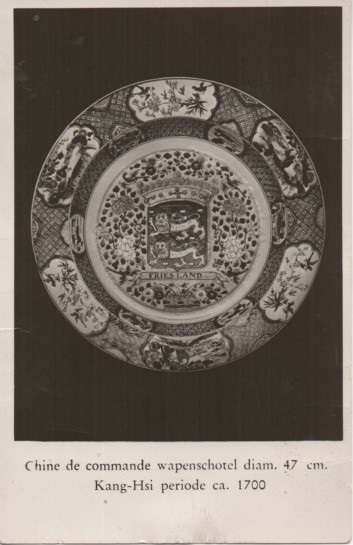
I know from experience that at that time, A.C. Beeling had the custom of providing their objects with a rectangular paper label with their name and the period from which the object originated. The original label is now gone all that remains are it's paper residu on the base.
(Example of an original Fa. A.C, Beeling & Zn. Hofleverancier Leeuwarden rectangular paper dealers label with their name and the period from which the object originated.)
Condition: Some firing flaws and frits and a chip to some corners of the rim.
Reference:
Howard & Ayers 1978, vol.1, cat.17
Lunsingh Scheurleer 1989, p.204 & p.235
Bachmann 2018, pp. 476-478, fig. 21.1 & fig. 21.2
Price: Sold.
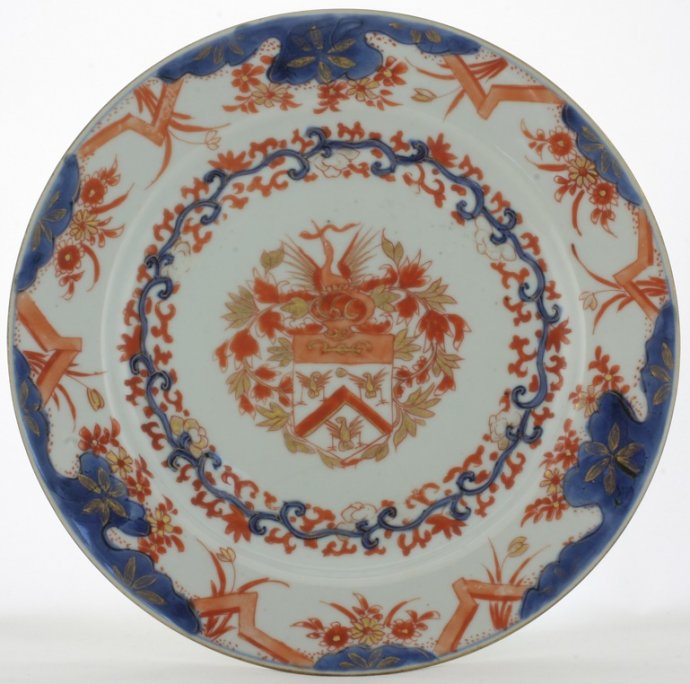
Sold Ceramics - Sold Chine de commande - Armorial / Pseudo-Armorial wares 1700-1800 - Armorial - Dutch - Page 1
Object 2011499
Dish
China
1710-1730
Height 18 mm (0.71 inch), diameter of rim 222 mm (8.74 inch), diameter of footring 120 mm (4.72 inch), weight 317 grams (11.18 ounce (oz.))
Dish on footring, flat underglaze brown-edged rim (jia mangkou). Chinese Imari, decorated in underglaze blue and overglaze iron-red and gold with a coat of arms. On the sides a flower border, round the rim flower sprays. On the reverse six single prunus blossoms in iron-red.
This coat of arms, a Chevron between three eagles and a bezant, in chief an unidentified charge; the crest is a heron-like bird with an eel (or snake) in its beak between two wings, was borne by the Van Gellicum family. It can be seen on a seal of 1921 which belonged to J.A. van Gellicum, who was a cavalry major. He descended from a family of probably wealthy farmers in the village of Deil in the Betuwe, Gelderland, The Netherlands. In this family either Jan Roelofs van Gellicum (1684-) or his son, Roelof van Gellicum (1708-), could have ordered this armorial porcelain. Jan Roelof married in 1707 and his son Roelof in 1749, the latter to Elisabeth Hoeken (1718-). In the 18th century three members of another branch of the Van Gellicum family (who are not related to the Deil family as far as is known) could have ordered these armorial dishes. The first two are the surgeon Chr. van Gellekom living in Amsterdam in 1742 and Hermanus van Gellicum, who also lived in Amsterdam about 1750-1760. The third is most interesting, Harmen van Gellecom, a native from Gorinchem The Netherlands, who was kwartiermeester (quarter-master or leading seaman), on four East Indiamen sailing on behalf of the Dutch East India Company, (Vereenigde Oost-Indische Compagnie, VOC), Chamber of Zeeland to Batavia between the years 1728 and 1736. The date of this porcelain correlates with his time in the Indies. This dish was part of a very large set of dishes, over 100 recorded examples (so far only dishes have been identified) Three sizes are known 380 mm (14.96 inch), 355 mm (13.98 inch) and 225 mm (8.86 inch). On the sides a floral scroll border, the rim with rocks, flowers, leaves and zig-zag lines. The zig-zag lines represent a thunderbolt, seen on Delft faience of the first quarter of the 18th century and based on Japanese patterns. (Kroes 2007, pp.118-119)
On basis of 20th century lacquer seals these arms are usually attributed to the Van Gellicum family, but since nothing seems to be known about 18th century members, the identification is questionable. Dishes of this design are not rare and usually have a Dutch pedigree. There are other examples (unpublished) in the Drents Museum Assen, and the Keramiekmuseum Princessehof, Leeuwarden. (Jörg & Van Campen 1997, p.302)
For identically decorated dishes, please see:
- Chinese Ceramics in the Collection of the Rijksmuseum Amsterdam, The Ming and Qing Dynasties, (C.J.A. Jörg in collaboration with J. van Campen, Philip Wilson in association with The Rijksmuseum Amsterdam, London 1997), p.302, cat. 353.
- European Noble and Private Collections. Including the G.A.H. Buisman Jzn. Chinese Armorial Porcelain Collection, auction catalogue Christie’s Amsterdam, 14-16 February 2006, pp.430-431, lot 1095.
- Chinese Armorial Porcelain for the Dutch Market, Chinese Porcelain with Coats of Arms of Dutch Families, (J. Kroes, Waanders Publishers, Zwolle, 2007), pp.118-119, cat. no. 20a & 20b.
- 300 Treasures, (F. Suchomel, Academy of Arts, Architecture and Design in Prague, Prague, 2015), p.339, cat. 196.
Condition: A frit to the rim and a X-shaped hairline to the base.
References:
Jörg & Van Campen 1997, cat. 353
Düsseldorf 2015, cat. 123.1-123.5
Price: Sold.

Sold Ceramics - Sold Chine de commande - Armorial / Pseudo-Armorial wares 1700-1800 - Armorial - Dutch - Page 1
Object 2012590
Bowl with cover and stand
China
1723-1735
Dish: height 33 mm (1.30 inch), diameter of rim 264 mm (10.39 inch), diameter of footring 141 mm (5.55 inch), weight 488 grams (17.211 ounce (oz.))
Bowl (without cover): height 85 mm (3.35 inch), diameter of rim 193 mm (7.60 inch), diameter of footring 72 mm (2.83 inch), weight 466 grams (16.43 ounce (oz.))
Cover: height 92 mm (3.62 inch), diameter of rim 168 mm (6.61 inch), weight 303 grams (10.69 ounce (oz.))
Published: A. Howard, Bespoke and elegant, in: Vormen uit Vuur 256, Amsterdam November 2024/3, pp.62-63, p.116.
Bowl on footring, steep sides with a flared lip. Dish or plate or stand on footring flat rim, everted lobed edge, the cover with a gilded Buddhist lion finial. Chinese Imari, decorated in underglaze blue and overglaze iron-red and gold on the rim there is an underglaze blue band with four reserves, each with three red flowers, alternating with four blue lappets and four ju-i reserves with a rouge-de-fer and gilt flower, The centre has a foliate scroll with the coat of arms of Van Gellicum. The reverse is undecorated. On the inside of the cover abroad unglazed band. The bowl and cover are decorated en suite.
This coat of arms, a Chevron between three eagles and a bezant, in chief an unidentified charge; the crest is a heron-like bird with an eel (or snake) in its beak between two wings, was borne by the Van Gellicum family. It can be seen on a seal of 1921 which belonged to J.A. van Gellicum, who was a cavalry major. He descended from a family of probably wealthy farmers in the village of Deil in the Betuwe, Gelderland, The Netherlands. In this family either Jan Roelofs van Gellicum (1684-) or his son, Roelof van Gellicum (1708-), could have ordered this armorial porcelain. Jan Roelof married in 1707 and his son Roelof in 1749, the latter to Elisabeth Hoeken (1718-). In the 18th century three members of another branch of the Van Gellicum family (who are not related to the Deil family as far as is known) could have ordered these armorial dishes. The first two are the surgeon Chr. van Gellekom living in Amsterdam in 1742 and Hermanus van Gellicum, who also lived in Amsterdam about 1750-1760. The third is most interesting, Harmen van Gellecom, a native from Gorinchem The Netherlands, who was kwartiermeester (quarter-master or leading seaman), on four East Indiamen sailing on behalf of the Dutch East India Company, (Vereenigde Oost-Indische Compagnie, VOC), Chamber of Zeeland to Batavia between the years 1728 and 1736. The date of this porcelain correlates with his time in the Indies. This dish was part of a very large set of dishes, over 100 recorded examples (so far only dishes have been identified) Three sizes are known 380 mm (14.96 inch), 355 mm (13.98 inch) and 225 mm (8.86 inch). On the sides a floral scroll border, the rim with rocks, flowers, leaves and zig-zag lines. The zig-zag lines represent a thunderbolt, seen on Delft faience of the first quarter of the 18th century and based on Japanese patterns. (Kroes 2007, pp.118-119)
Reflected in the glossy enamels and rich gilding of this elegant, covered bowl and stand are diverse intertwined threads of Japan, China and Europe. Following the fall of the Ming dynasty (1368-1644), Dutch traders turned to Japan for new merchandise. By the last quarter of the seventeenth century, bright and dense geometric designs had evolved, adding iron-red and a lustrous gold to the ubiquitous underglaze cobalt blue. Deriving their name from the port of Imari, these wares were immediately popular in Europe. Chinese painters were quick to adopt this innovative palette, but also adapted it with their own designs and motifs, creating a new hybrid 'export-style' which remained fashionable until the 1740s. (Howard 2024, p.116)
In the eighteenth century new dining habits in Europe elicited Dutch and English orders for bespoke tableware personalised with coats of arms, many of the early orders being place by personnel of the Dutch East India Company (VOC) and the East India Company (EIC). In England, thirty-two Chinese Imari armorial services are recorded, all but two of them from the Kangxi (1662-1722) period. Seven services were ordered from the Dutch Republic which include this covered bowl and stand with the arms of Van Gellicum; the commissioner is uncertain but most likely seems to have been Harmen van Gellecom, a VOC quartermaster who travelled to Batavia four times between 1728 and 1736. two related services were made: the first a large but unremarkable set of at least one hundred plates and dishes, while this covered bowl and stand are from a second, much smaller, service with noticeably more refined workmanship, a more complex design and richer gilding. A Buddhist lion finial adds distinction. Only two complete sets of three pieces appear to remain together; possibly few as eight sets were made. (Howard 2024, p.116)
They were clearly intended for hot food: in Asia they would have held rice dishes, in Europe probably a spicy stew popular in both Portugal and the Netherlands known as olla podrida served in a olio pot. In England the title page of 'The Compleat Court-Cook' of 1710 by Patrick Lamb, Master-Cook to the monarch, boasts recipes for 'Soopes, Bisques, Olio's and Ragoo's'. The Dresden porcelain collection records six very similar bowls and covers in the 1721 inventory as 'N.19. six ribbed olio pots with bowl-shaped covers and companion assiettes'. The function of these delicate bowls was probably short lived, as the shape was supressed in the 1730s by sturdier tureens. (Howard 2024, p.116)
A decade after its manufacture, one of these armorial bowls was elevated from the everyday into the realm of the collector and set in elaborate gilt bronze mounts in Paris. Supported by three ornate dolphins, it was mounted above a tripod stand with a similar palette and transformed into a fanciful rococo ormulu creation, now at the Getty Museum. Together with a single dish at the residenzmuseum in Munich, and this set in The Anders Collection at the Groninger Museum, perhaps this small, refined group was to become destines for the Museum rather than the table. (Howard 2024, p.116)
At least eight other dishes are recorded. All these dishes were probably used as stands for covered bowls. A minimum of four examples of the matching bowls have been identified. There is only one complete set with a covered bowl and stand and one other set of a bowl with a stand, but the cover missing. The deep circular bowls have a flared lip and a diameter of 19 to 20 cm and are decorated both inside and outside. The cover has a gilded Buddhist lion finial. There is a bowl in the J. Paul Getty Museum which has a gilt bronze, probably German, mount dated 1740. It is very likely that this service was ordered by the same person as the first armorial service with the Van Gellicum arms, possibly shortly afterwards. (Kroes 2007, p,119)
For an identically, shaped, and sized dish, plate or stand decorated with the Van Gellicum II, c.1720-1730 armorial design, please see:
For dishes decorated with the Van Gellicum I, c.1720-1730 armorial design, please see:
Comparison between Van Gellicum I, c.1720-1730 (left) and Van Gellicum II, c.1720-1730) (right).
The center of the Van Gellicum II, c.1720-1730 (right) set has a foliate scroll with the coat of arms painted in almost exactly the same way as the first armorial set, Van Gellicum !, c.1720-1730 (left), Slight variations can be seen on the helmet and the objects in chief of the shield. This set seems to be more richly decorated, with more gold which is also better preserved and rather more accurately painted than the first set. (Kroes 2007, p,119)
For dishes decorated with the Van Gellicum I, c.1720-1730 armorial design, please see:
A broad unglazed band on the inside of the cover decorated with zig-zag lines in iron-red on the biscuit. A rare feature selden seen on Chinese export porcelain.
Condition: Some wear to gilding of the cover and a hairline to the cover.
References:
Jörg & Van Campen 1997, cat. 353
Kroes 2007, cat.no. 20a, 20b & 21
Price: Sold.
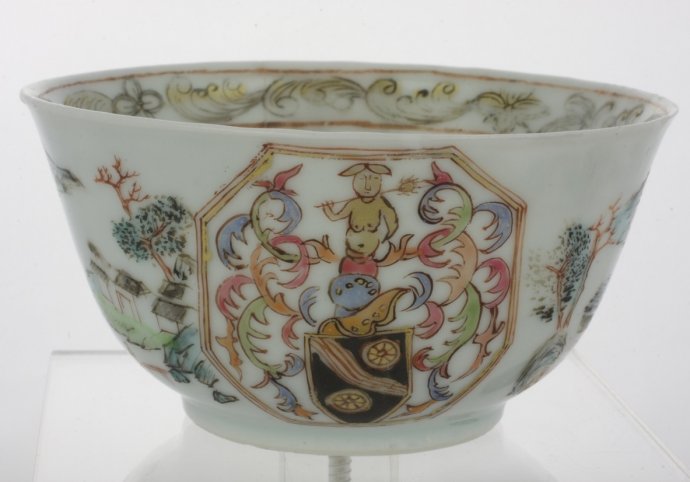
Sold Ceramics - Sold Chine de commande - Armorial / Pseudo-Armorial wares 1700-1800 - Armorial - Dutch - Page 1
Object 2010520
Teacup
China
1730-1735
Height 38 mm (1.49 inch), diameter of rim 140 mm (5.51 inch), diameter of footring 75 mm (2.95 inch)
Teacup on footring, slightly everted rim. Polychrome decorated in various overglaze enamels with a Chinese water and mountain landscape with rocks, trees, houses on a shore, a bridge, several Chinese figures and two little boats on a lake alternating with an octagonal panel painted with a coat of arms: on a black background a gold waving bend with two gold roses or flower heads; the crest is a half-naked figure with a club on the right shoulder. The mantling has an open pattern of scrolling leaves. On the bottom a single flower spray. Around the inner rim a foliate and floral scroll pattern border.
This coat of arms was borne by the "Beekman" family from Middelburg and Nijmegen. About 1720-1730 there were two Beekman brothers living in Middelburg, Samuel and Adriaan. They were related to the influential Van de Putte family and in 1730 both brothers were heirs of Cornelis van de Putte. Both brothers held positions with the Middelburgsche Commercie Compagnie (MCC), they probably owed their position within the MCC to their grandfather, the MCC director, Hermanus van de Putte. In the 1740s Adriaan belonged to the (upper) middle class of Middelburg and probably had good connections with the Dutch East India Company (VOC) and its officials and it would have been easy for him to order these Armorial wares. Round the inner rim a foliate and floral scroll border. On the bottom an orchid (Cymbidium virescens), the Lan Hua. a motif commonly seen on fine Chinese export porcelain of around 1740. The mountain and water landscape is similar to the neighbourhood of the porcelain manufacturing town Jingdezhen in the province of Kiangsi. (Kroes 2007, p.138)
In total there are only three or four plates in different sizes: 230 mm (12.60 inch) and 430 mm (16.93 inch), one coffee cup, two tea bowls and a saucer known with this Armorial. (Kroes 2007, p.138)
A dish with an identical armorial design can be found in the collection of the Rijksmuseum Amsterdam, number; AK-NM-13402.
For an identically decorated dish, please see:
Condition: Restored.
Reference:
Price: Sold.
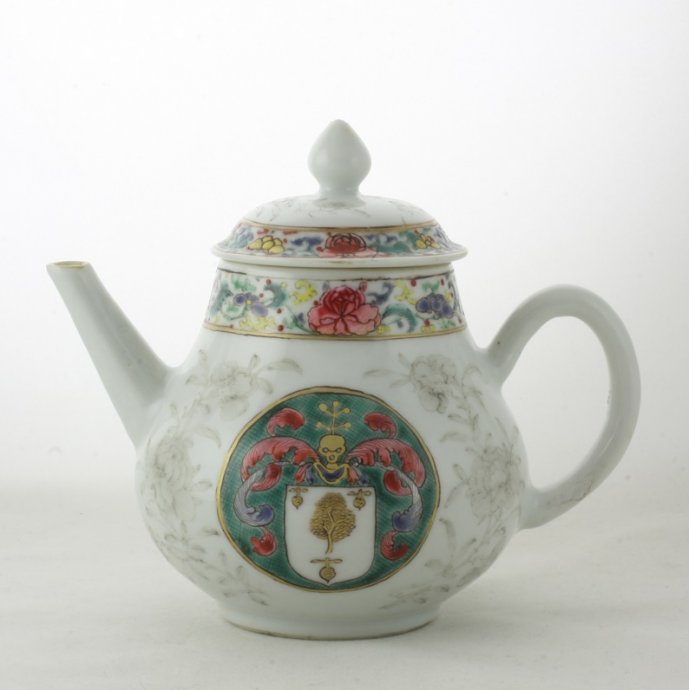
Sold Ceramics - Sold Chine de commande - Armorial / Pseudo-Armorial wares 1700-1800 - Armorial - Dutch - Page 1
Object 2010735
Teapot
China
1732-1735
Provenance: Polly Latham, Boston, USA.
Height (with cover) 125 mm (4.92 inch), height (without cover) 92 mm (3.62 inch), diameter handle to spout 150 mm (5.90 inch), diameter of mouthrim 53 mm (2.09 inch), diameter of footring 50 mm (1.97 inch)
Teapot of pear shape on footring, straight spout and C-shaped handle a domed cover with pointed knob, Polychrome decorated in yellow, rose-red, blue and green overglaze enamels, black / grisaille and gold with an armorial painted in a roundel flanked by stems of flowering peonies finely painted in grisaille on each side of the body. Around the mouthrim a border filled with brightly coloured flowers (peony, lotus, hibiscus) and tendrils. The cover with stems of flowering peonies finely painted in grisaille, round the rim a border filled with brightly coloured flowers (peony, lotus, hibiscus) and tendrils. On the base two paper labels that read: "Polly Latham" and "KIEN-LUNG 1736-1795".
The rich and beautiful palette of famille rose enamels with pink, yellow, blue, green, black / grisaille and gold is typical of the Yongzheng period (1723-1735), in particular of the first half of the 1730s.
The coat of arms is depicted on a green and black hatched background in the medallion: a large gold leaf-like figure (or a human organ) with three gold hanging fruits each with foliated stem, possibly pine-cones or mulberries, the helmet comprising a gold skull with above a withered tree-like figure with five branches, surrounded by mantling with scrolling leaves in rose and blue. These arms with rather peculiar heraldic charges are unidentified, although they have been wrongly attributed to the Le Saulnier family from France. The skull and the branches, or possibly ears of corn, point to new life (the grain of corn dying in the earth to create new life).
This particular armorial design and in fact the overall style and decoration in various overglaze enamels is almost identical to the armorial service of the Dutch Titsingh family, dated 1732-1735. There are only some minor differences regarding the shape of the shield, helmet and mantling, please see: here.
It seems that whoever commissioned this service would have been a colleague of Abraham Titsingh and his fellow surgeons in Amsterdam. It might have been made for the Amsterdam surgeons' guild. The heraldic charges such as the leaf-like figure, the skull with branches and probably also the fruit points to the medical profession. As far as we know, Abraham's fellow trustees of the guild in 1732, Vermey, Van Wesik, Van der Swed, De Bruijn and Monnikhoff, bore quite different arms from these. If it's made for the surgeons' guild to decorate the guild room, Abraham Titsingh must have taken the opportunity to order armorial porcelain both for himself and for the guild room. There are no recorded arms for the Amsterdam surgeons' guild, although guilds in other Dutch cities had arms, such as the Deventer and Gouda guilds, bearing arms with a skull and two cross bones (Deventer) and a pentalpha or star of David with a sun and two stars (Gouda).
This teapot is one of only seven objects documented with this specific armorial design.
All information:(Kroes 2007, pp.177-179)
For a tea-caddy, with identical armorial design, please see:
For a dish from the armorial service of the Dutch Titsingh family please see:
Condition: A rough tip of the knob and a glaze rough spot to the handle.
References:
Kroes 2007, pp.177-179, cat.no. 89 & 90.
Price: Sold.
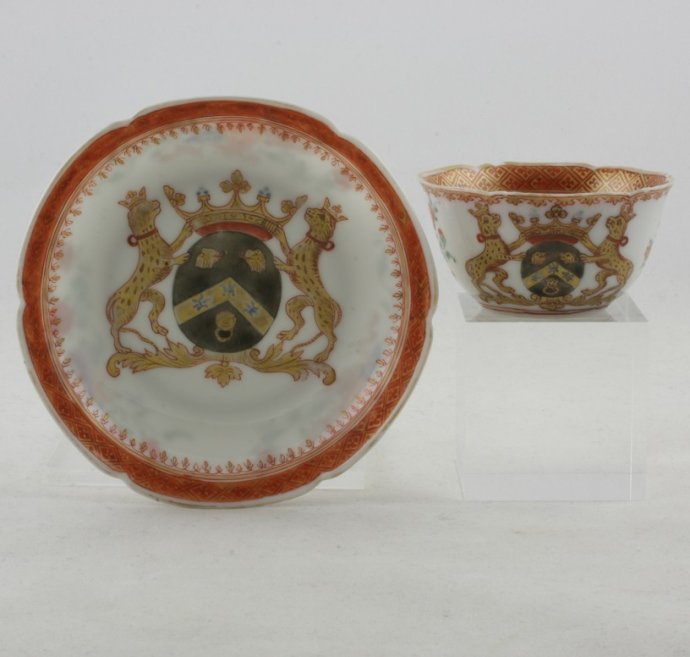
Sold Ceramics - Sold Chine de commande - Armorial / Pseudo-Armorial wares 1700-1800 - Armorial - Dutch - Page 1
Object 2012191
Teacup and saucer
China
c.1735-38
Height of teacup 29 mm (1.14 inch), diameter of rim 56 mm (2.20 inch), diameter of footring 25 mm (0.98 inch), weight 21 grams (0.74 ounce (oz.))
Height of saucer 18 mm (0.70 inch), diameter of rim 88 mm (3.46 inch), diameter of footring 50 mm (1.97 inch), weight 23 grams (0.81 ounce (oz.))
Teacup and saucer on footrings, sixfold scalloped rims. Decorated in various overglaze black, gold, blue and green enamels, iron-red and gold with a coat of arms round the rim a lozenge diaper border in gold on a rouge de fer ground with a flowerbud-like or early spearhead border. On the reverse rim three groups of flower sprays with antiquities and round the rim a regular spearhead motif border. The teacup is decorated en suite.
The coat of arms shows:
Sable, on a chevron d’or three azure fleur-de-lys, above with two severed lion’s heads with red tongues facing each other and below a lion’s head facing forward with a ring in its mouth, all in gold. Two leopards as shield bearers, holding a crown. (in Dutch: in zwart een lage keper beladen met drie blauwe lelies, boven vergezeld van twee toegewende afgerukte leeuwenkoppen, rood getongd en beneden van een aanziende leeuwenkop, rood getongd, alles goud)
The Dutch coat of arms on this teacup and saucer are unidentified and unrecorded in literature (including J. Kroes’ Dutch armorial porcelain) until now. They belong to the ‘De la Faille’ family (also written: del la/della Faille).
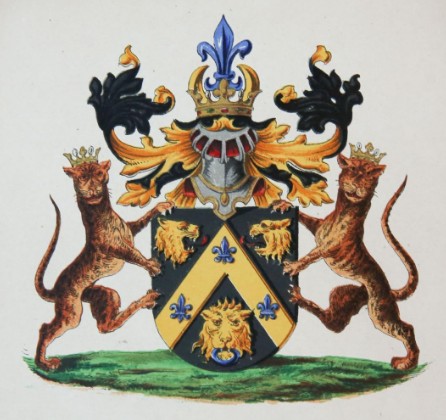
Coat of arms de la /del la/della Faille family, drawing, HxW…inch,138 mm (4.43 inch) x 126 mm (4.96 inch) © Antiquariaat /antiquarian bookshop Van der Steur, Haarlem, the Netherlands.
The De la Faille family has its origin in Antwerp and already traded on the Levant in 1540, with some of its family members taking up residence in Venice. The family can still be found in Belgium today (until 1831 the southern part of the Netherlands) and belongs to the Belgian nobility.
The family split when after the fall of the city of Antwerp in 1585 some Protestant members emigrated to the Netherlands, more precise to Haarlem, Dordrecht and Leiden. In the late 17th century the family also took residence in the city of Delft.
Because of their prominence in Delft and Delft being one of the VOC Chambers, further research was done on these members of the De la Faille family.
The Delft connection starts with Bernardus de la Faille, who resided in The Hague (Dutch: Den Haag) nearby Delft; he was an accountant for the Stadtholder Maurice of Orange. He married Elisabeth Camerling from Delft in 1618.
His son, Johan del la Faille (1628-1713) already became a member of the City Council (Dutch: vroedschap) in Delft. As a supporter of stadtholder William III of Orange, he was appointed in 1672, the Year of Disaster after the First Stadtholderless Period, when the Dutch Republic was under threat of an invasion by the troops of King Louis XIV of France. He was also bailiff (Dutch: Schout) in Delft between 1680 and 1713. Johan de la Faille owned a famous curiosity cabinet, which was started by his grandfather and father, mainly consisting of sea shells as well as birds, Roman coins and medals, tapestries and paintings and interestingly also porcelains.
Portrait of Johan de la Faille(1628-1713), 1680s, member of the City Council (vroedschap) and Bailiff (schout) of Delft, Oil on copper, H x W 6 1/4 x 12 inch (41.3 x 30.5 cm),Jan Verkolje, signed on the butt of the rifle: Jan Verkolye 168(?)
© 2018 Wadsworth Athenaeum Museum of Art, Hartford Connecticut, US, object-id: 1982.36
Johan de la Faille married on 28th of January 1671 with Anna Margaretha Delff (1647–1715). The couple had four children: Johan Bernard, Cornelis, Abraham and Elisabeth.
His second son Cornelis (1674-1730) was the centre of an interesting story. In 1730 he became involved in the so-called ‘Sodomite Hysteria’ (Dutch: Sodomietenhysterie) in the Netherlands. Cornelis was homosexual, but in the elite circles of the time this was usually handled reasonably open-minded.
In 1730 however the Dutch Republic had just experienced an epizootic disease in its cattle population, while its dikes were threatened by shipworm. These circumstances had readied the minds of the Dutch for moral panics fuelled by Protestant preachers, because they saw this as evidence of God's wrath against homosexuals. This dangerous mind-set and an already present aversion against the clique of city rulers was pretty suddenly canalized in a violent outbreak of hate against homosexuals, which started in the city of Utrecht, after which a nationwide wave of prosecutions ensued. In a series of pamphlets and veil gossip a whole network of homosexual members of city councils across several Dutch cities, including the locations of the public houses they met, was outed and vilified. The government, pressured by the public outrage, now felt compelled to act.
Dozens of men were condemned to the gallows or drowned, and their remains were burned or casted into the sea, which attests to the dangerous atmosphere at the time.
Engraving, 180 mm (7.09 inch) x 280 mm (11.02 inch), 1730; Allegory, showing Justice in the centre, ‘glorified by the discovery of …severe Sin.’ [Dutch: ‘De geregtigheid verheerlijkt door het ontdekken der hooggaande zonde’].To the left an angel holding a banner showing the Biblical text ‘Men desisting from natural relations with women,’ Romans 1:27 [Dutch: ‘Mannen nalatende het gebruik der vrouwen’, Romeinen 1:27]. Time lifts the curtain to reveal homosexual gentlemen; the four chained women to their right represent Fornication, Lust, Avarice and Wantonness. On the background the cities of Sodom and Gomorra burning.
© National Prison Museum, Veenhuizen, the Netherlands, inv. nr. 05417645X
In Delft three ‘suspects’ were arrested. Fortunately, prime suspect Cornelis de la Faille had fled town just in time. He was convicted in absentia and all his possessions, including a large townhouse (Oude Delft 124), inherited from his mother, were confiscated.
Cornelis died in 1730 of natural causes; the family de la Faille however did not accept Cornelis’ conviction and started a trial at the High Court of Holland to regain their family possessions. When the homophobia finally died down the family won the court proceedings arguing that it was first and foremost a family affair in which the courts had no say at all, an argument which the court, consisting of fellow city elite members, was highly sensitive of.
Cornelis died in 1730 and his brothers Johan Bernard and Abraham both in 1729, which makes it unlikely any of them ordered this tea-and coffee set with their coat of arms, because this cup and saucer can actually be dated quite precisely due to the interesting fact that - apart from the coat of arms - it is identical to cups and saucers from the well-known Valckenier armorial tea- and coffee service, ordered by governor-general Adriaan Valckenier, dated 1735-38.
The back and sides of a Valckenier teacup and saucer, which further confirms that it is completely identical with de la Faille, are never shown, therefore an few rare pictures are also included in this description.
It is because of these never visible verte enamels in this part of the decoration, this Valckenier tea- and coffee service has sometimes been described in the past as ‘famille verte’ [Corbeiller 1974, p.88].
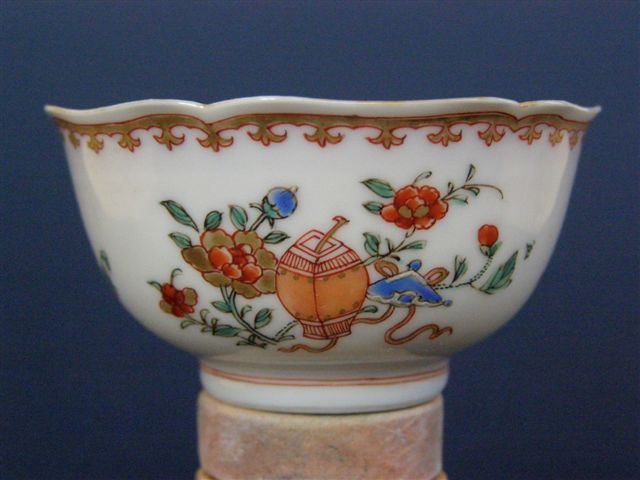
Teacup and saucer with the arms of Valckenier, c. 1735-38, cup H.3,7 cm (inch),D. 6,7 cm(inch), saucer 10,7 cm (inch), Private Collection, the Netherlands. (not included in this sale)
For more background information about this Valckenier tea-and coffee set, please see:
For more information about other Valckenier armorial services in general, please see:
The similarity with Valckenier of course begs the question whether there could be any connection between the two families. Further research revealed no family connection (e.g. through marriage). However, it became clear that at the same time Adriaan Valckenier was in Batavia, there were also at least two members of the De la Faille family present as part of the government of the Dutch Indies, working directly with him.
In 1701 Cornelis’ elder brother Johan Bernard (1672-1729) married with Anna Catharina van Heemskerck (1676-1723); the couple had no less than 8 children. One of Johan Bernard’s children was Bernard Jacob de la Faille (1709-1746), who went to Batavia in 1731 aboard the VOC ship ‘Spiering’ as a member of the Council of Justice (Dutch: Raad van Justitie) in Batavia [source: openarch.nl] He married Marie Gosewine in 1732.
Another was Mr. Cornelis Coenraad de la Faille (1710-1744), merchant and First Keeper of the Storage Rooms (Dutch: koopman en dispensier Provisiekamer) in Batavia in 1736. Presumably around that same time he married Magdalena Clara van Schagen, the daughter of Joan Paul van Schagen (1689-1746), who became director-general of the Indies in 1737, at the same time Adriaan Valckenier became governor-general. The couple had two daughters.
[source: Wijnaendts van Resandt, W., De gezaghebbers der Oost-Indische Compagnie op hare buiten-comptoiren in Azië, Amsterdam 1944, pp. 68-69]
Both De la Faille brothers could have ordered armorial porcelain because of their significant VOC functions in Batavia. The most likely of the two in this case however would be Cornelis Coenraad, because of his stronger connection to Adriaan Valckenier through his spouse whose father worked directly alongside Valckenier. Another indication could be the oval shape of the shield, which usually (although not exclusively) points to a married woman. Perhaps he ordered this armorial tea service when he married Magadalena van Schagen?
All in all, this hereto unknown Dutch armorial cup and saucer provides a fascinating view not only into the De la Faille family history, but also into Dutch and Batavian history and the high society of the time.
Condition teacup: some frits and fleabites to the rim
Condition saucer: a short hairline to the rim.
References:
De Nederlandsche Leeuw, jaargang 15 (1897), p. 191
Corbeiller 1974, pp. 86-88, no. 34, figs. 46-47
Kroes 2007, cat. 32 t/m 36, cat. 78,cat. 96 t/m 101
Wijnaendts van Resandt 1944, pp. 68-69
Price: Sold.

Sold Ceramics - Sold Chine de commande - Armorial / Pseudo-Armorial wares 1700-1800 - Armorial - Dutch - Page 1
Object 2012012
Dish
China
c.1735-38
Height 31 mm (1.22 inch), diameter of rim 255 mm (10.04 inch), diameter of footring 132 mm (5.20 inch), weight 498 grams (17.57 ounce (oz.))
Dish on footring, flat rim. Decorated in various overglaze enamels, iron-red, gold and encre de Chine with a coat of arms with falcon crest, helm and mantling. On the rim three sprays of flowering boughs and a small scalloped border. The reverse is undecorated.
The arms are those of the influential Valckenier family of Amsterdam: On a gold background a blue pale charged with a white and black (silver) branch with two red crescents on either side. The crest is a rising pink falcon with a red hood.
This plate is part of a dinner service ordered by Adriaan Valckenier (1695-1751), governor-general of the Dutch East Indies. It contains a large number of (soup) plates and dishes of varying sizes, from 225 mm (8.86 inch) to 440 mm (17.32 inch). This dinner service also comprises of octagonal trencher salts, sauce boats and – quite exceptionally - at least 15 pear shaped beer jugs with lids.
Covered beer jug with arms of Valckenier, c. 1735-38, H. 220 mm (8.66 inch), Thumb rest Hop cone
original bronze fittings on handle and lid, thumb rest in the shape of a hop cone, thus providing a clear clue as to its intended use; Collection Valckenier Kips, the Netherlands. (not included in this sale)
For identical dishes with the Valckenier coat of arms, please see:
- China Trade Porcelain. An account of its historical background, manufacture, and decoration and a study of the Helena Woolworth McCann Collection (J.G. Phillips, Harvard University Press, Cambridge, Massachusetts, 1956), p. 92 & p. 95, pl. 22
- The Choice of the Private Trader. The Private Market in Chinese Export Porcelain illustrated from the Hodroff Collection (D.S. Howard, Zwemmer, London 1994), p. 79, cat. 62
- Supplement to Chinese Ceramics in the Collection of the Rijksmuseum, Amsterdam. The Ming and Qing Dynasties (J. van Campen in collaboration with C.J.A. Jörg, Philip Wilson Publishers Limited, London, 1997), p. 79, cat.nr. 1014 [Bequest J.G.A.N. De Vries 1925]
- Made in China. Export Porcelain from the Leo and Doris Hodroff Collection at Winterthur, (Ronald W. Fuchs II in collaboration with D.S. Howard, University Press of New England, Winterthur 2005), p. 63, cat. 25
- Chinese Armorial Porcelain for the Dutch Market, Chinese Porcelain with Coats of Arms of Dutch Families, (J. Kroes, Waanders Publishers, Zwolle, 2007), p. 134, cat.nr. 36
- The Hodroff Collection, Part II, auction catalogue Christie’s New York, 23th of January 2008, sale 1958, lot 370
Other Imari Valckenier porcelain with almost identical decoration is recorded, such as large beaker vases (420 mm (16.54 inch)) and tea, coffee and chocolate services.
Beside this particular service there are other services bearing the Valckenier arms, such as the one with town views en grisaille on the border, which is probably the best known. Furthermore, there exists an underglaze blue variety, for which Adriaan’s son Adriaan Isaac later ordered some additional pieces, and a rare tea and coffee service in famille rose enamels.
Beside Chinese armorial porcelain, there are also several Japanese jugs with the Valckenier arms and sometimes silver lids, dated c.1663, thus belonging to the earliest recorded Japanese armorial porcelain in the Netherlands. These jugs are probably ordered by Adriaan’s grandfather Gillis (1629-1681), 9 times burgomaster of Amsterdam and Bewindhebber of the VOC. There is also a beautiful Japanese lacquer dish with the Valckenier arms in the collection of the Rijksmuseum.
Japanese lacquer dish with the Valckenier arms, c. 1665-1690, Ø 530 mm (20.87 inch), © Rijksmuseum Amsterdam, objectnr. BK-1994-30. (not included in this sale)
Adriaan Valckenier (*6-6-1695 - †20-6-1751) went to the Dutch East Indies when he was 19 years old and reached Batavia in 1715. In 1725 he marries Johanna Alida Tolling, daughter from a member of the Council of the Indies. This advantageous marriage progressed his career further, he soon became Opperkoopman in 1726 and Boekhouder-Generaal and schepen of Batavia in 1727. In 1728 his daughter Susanna Catharina was born, his wife died a year later while in labour from twins.
In 1730 he remarried Susanna Christina Massis, daughter of a Councilor of Justice and widow of another high-ranking VOC official. In 1731 his son Adriaan Isaac was born. In 1734 he became First Councillor and Director-General, usually the forerunner post for governor-general. Eventually he had to wait because first Abraham Patras became governor-general after the Council of the Indies could not agree and decided to draw lots.
Oil painting, 1410 mm (55.5 inch) x 1600 mm (63.0 inch)., c.1737, Nicolaas Verkolje; Adriaan Valckenier (1695-1751) with his second wife Susanna Christina Massis (1704-1737) and his two children Susanna Catharina Valckenier (1728-1743) and Adriaan Isaac Valckenier (1731-1784), Private Collection, the Netherlands. (not included in this sale)
Finally, in 1737 Adriaan was appointed governor-general. In the same year, he sent his son and daughter to the Netherlands, because his second wife Susanna also died earlier that year. In all likelihood, they already took some armorial porcelain with them.
Adriaan was eager to follow them home and had already requested to be released of his post. In 1738 the Heeren XVII confirmed both his post and permission to return to the Netherlands at his own leisure. So, contrary to popular belief, he already received an honourable discharge long before the Chinese massacre occurred in 1740. This is confirmed by correspondence he received from family and friends congratulating him with his promotion but also with the permission to return home whenever he was ready:”…UwEd. te feliciteren met de confirmatie en bevestiginge in dat Hoogwigtig Ampt, en met eener permissie om naar UwHoogEdGestr. welgevallen te blijven of te repatrieeren zonder naader ordre hetwelk ons doet hopen van UHoogEdelgestr. in korte jaeren alhier te lande te sal moogen opwagten.“ (“Your Excellency, congratulations with the confirmation of that considerable office and with the permission to stay or repatriate at your own discretion, which gives us hope that we will be awaiting Your Excellency in this country within a couple of years.”)[National Archives of the Netherlands, the Hague, inv.nr. 1.10.05.05, coll. Valckenier, nr. 1, letter from Adriaan’s godchild Clara Jacoba van Holst, dated 22-12-1738]
Chinese massacre Batavia 1740
From about 1725 onwards the export of sugar came to a standstill, because the market got saturated. This meant a dramatic decline in work and trade for the Chinese merchants as well as the labourers on the sugar plantations around Batavia. However, new Chinese immigrants kept coming over every year and slowly the situation became untenable and tense. Tensions grew even more as the colonial government attempted to restrict Chinese immigration by implementing deportations from unemployed labourers to Ceylon and South Africa. There were rumours that deportees were not taken to their destinations but were thrown overboard once out of sight of Java and in some accounts, they died when rioting on the ships. This caused unrest among the remaining Chinese, leading many Chinese workers to desert their jobs. Gangs of Chinese formed and started to attack Batavia in June 1740. The VOC was barely able to resist these attacks. On 7 October, hundreds of ethnic Chinese, many of them sugar mill workers, killed 50 Dutch soldiers outside the city walls of Batavia. The Raad van Indië was afraid that the large groups of Chinese living in Batavia would soon join the revolt, leading Dutch troops to confiscate all weapons from the Chinese populace and to place the Chinese under a curfew. Later on, the government decided to take every suspicious Chinese into custody to prevent further uprising. This soon got out of hand and two days later, rumours of Chinese atrocities led other Batavian ethnic groups to burn Chinese houses along the Besar Stream and Dutch soldiers to fire cannon at Chinese homes. The violence soon spread further throughout Batavia, killing more Chinese. Although Adriaan Valckenier declared an amnesty on 11 October, gangs of irregulars continued to hunt and kill Chinese until 22 October, when the governor-general called more forcefully for a cessation of hostilities. In a lengthy letter in which he blamed the unrest entirely on the Chinese rebels, Valckenier offered an amnesty to all Chinese, except for the leaders of the unrest, on whose heads he placed a bounty of up to 500 rijksdaalders. It is estimated that between 5000 and 10000 Chinese were killed. The Kali Besar river in nowadays Jakarta is still called Hongqi by the Chinese, a name stemming from the massacre in 1740 and meaning Red River.
Etching, 1740, Adolf van der Laan, ‘de Schrikkelyke Slagting der Chinezen, na de Ontdekking van hun Verraad’ or “The horribel massacre of the Chinese after the discovery of their treason’, © Rijksmuseum Amsterdam, objectnr. RP-P-OB-75.355
After the Chinese revolt the already cumbersome relations between Adriaan Valckenier and the Raad van Indië reached an absolute low. Especially Valckenier and his sworn enemy Van Imhoff had several confrontations about who was responsible for the massacre. Vermeulen suggested that the tension between the two colonial factions played a major role in the ensuing massacre [Vermeulen, Johannes Theodorus. De Chineezen te Batavia en de troebelen van 1740 (The Chinese of Batavia and the Troubles of 1740) Proefschrift (thesis), University of Leiden, 1938]. Eventually this lead to the arrest of Van Imhoff and two of his supporters, Council members Elias Haese and Isaac van Schinnen. Valckenier sent the men back to the Netherlands, each on a separate ship.
Etching, 1793, The arrest of the Council members Van Imhoff, Haese en van Schinnen in 1740, Reinier Vinkeles after a drawing by Jacobus Buys,from: Jacobus Kok, Vaderlandsch Woordenboek, Johannes Allart, Amsterdam 1785-1799, 35 delen, dl. 29, pl. 3., © Rijksmuseum Amsterdam objectnr. RP-P-OB-75.360
This wasn’t a very smart move because Van Imhoff upon his return to Amsterdam seized the opportunity to convince the Heeren XVII that he was wronged and that Adriaan Valckenier was solely to blame for what happened. Adriaan Valckenier meanwhile was heading home on board the ‘Amsterdam’ in 1741 as Admiral of the Return Fleet, but was arrested at the Cape and sent back to Batavia awaiting his trial. The East Indiaman the ‘Amsterdam’ continued his voyage but sunk in a storm near the Shetland Islands, along with about 15 armorial services (about 2,377 pieces) as well as other porcelain and many exotic treasures.
When Valckenier arrived in Batavia on the 2nd of November 1742, he was escorted from the ship ‘by “een Sergeant, twee Corporaals en 24 Soldaten” and transported to “de ‘punt Robijn’, sonder acces van vrienden, excepto den heer Crul, de weduwe Massis en den oud-Secretaris Fruynink. [“A sergeant, two corporals and 24 soldiers”…”to fortress Robijn, without being allowed access by any friends, except for mr. Crul, the widow Massis and former secretary Fruynink”; Arsip Nasional Republik Indonesia, file 997, folios 1185-1211]
Meanwhile, Van Imhoff was sent back to Batavia as the new governor-general of the Dutch East Indies. He arrived on 26 May 1743. Valckenier was subsequently charged with the death penalty and forfeiture of all his possessions. Van Imhoff even lodged a personal claim of 125.000 rijksdaalders, demonstrating his questionable personal involvement in the proceedings. In March 1744 Adriaan was convicted and condemned to death, and all his belongings were confiscated.
However, in December 1744 the trial was reopened when Adriaan Valckenier gave a lengthy statement to defend himself. He had written 12.233 articles in his defence until pencil and paper were taken from him [Valckenier’s articles can still be found in the City Archive of Amsterdam, inv.nr. 30491, nr.974]
Valckenier also asked for more evidence from the Netherlands, but particularly Van Imhoff did everything in his power to delay the proceedings.
Adriaan eventually died in his prison cell on 20th of June 1751, before the investigation was completed, having never seen his beloved children and family again. He was placed in the burial chamber of his father-in-law Isaac Massis. His death penalty was rescinded posthumously in 1755.
The investigation and trial of Adriaan Valckenier are often characterised as unfair, fuelled by popular outrage in the Netherlands he was made a scapegoat, while others equally involved such as Van Imhoff stayed in the clear. Arguably this was officially recognised because in 1760 Valckenier's son, Adriaan Isaac Valckenier, received reparations totalling 725,000 gulden, an enormous sum of money at the time.
Politics aside, what remains of Adriaan Valckenier is an impressive legacy of beautiful armorial porcelain and many other artefacts, of which this plate is a beautiful example.
Condition: a hairline to the rim, very slight wear to the enamels
References:
Goldsmith Phillips 1956, p. 92 & p. 95, pl. 22
Corbeiller 1974, pp. 86-88, no. 34, figs. 46-47
Hervouët & Bruneau 1986, nr. 14.5
Ayers, Impey & Mallet 1990, cat. 41
Howard 1994, cat. 61 & cat. 62, cat. 247
Jörg & Van Campen 1997, cat. 355
Lunsingh Scheurleer 1989, pp. 231-232
Kroes 2007, cat. 32 t/m 36, cat. 78,cat. 96 t/m 101
Price: Sold.

Sold Ceramics - Sold Chine de commande - Armorial / Pseudo-Armorial wares 1700-1800 - Armorial - Dutch - Page 1
Object 2012503
Dish
China
c.1738-1741
Height 40 mm (0.71 inch), diameter of rim 300 mm (8.74 inch), diameter of footring 165 mm (4.72 inch), weight 959 grams (33.83 ounce (oz.))
Octagonal dish on footring. Decorated in underglaze blue with eight lotus petals, each containing a stemmed lotus flower on a spiralling diaper ground. In the medallion, in the heart of the lotus-shaped flower head, a coat of arms of De Haze and Sonmans accollé. On the left or heraldic right (a running animal with a small tail representing a hare, on the base, with two six-pointed stars above) and a coat of arms accollé to the right or heraldic left: quarterly, 1. and 4. a crown with a cross above (a king's crown or papal tiara), 2. a plant with stem and seven leafy branches, the stem continuing into the fourth quarter, 3. fleur-de-lis, with an oval shield of pretence with a mask-like human face. Both shields are on a pedestal, surrounded by ornaments and scrollwork in Louis XiV style and with a coronet above and a ribbon on either side. A narrow band of spirals on the outer rim. On the reverse four stylized flower sprays.
The dexter arms are those of De Haze from Middelburg. The quarterly arms accollé were borne by a branch of the Sonmans (or Sonnemans) family, although several armorial variations have been used by this family.
The armorial on the porcelain was borne by Rachel Sonmans on a seal when she signed a notarial act drawn up in The Hague in 1766.
Rachel Sonmans was the elder sister of Sara Sonmans who was Elias de Haze's first wife. Elias de Haze (1689-1752) ordered this service after his marriage to Sara Sonmans on 23 September 1738, but before 13 September 1741 when Sara died. In the 1730s Elias was active as a VOV official in Ambon, Ternate and Batavia. From 1734 he lived in Batavia, first as extraordinary councillor and from 1739 as ordinary councillor of the Indies. Shortly after his wife death in 1741 he returns home, settling in The Hague where he married secondly Catarina Emants (1715-1782) on 4 June 1744.
Sara Sonmans' family came from Amsterdam. This family was originally from 's-Hertogenbosch, with a branch in Amsterdam from the beginning of the 17th century and also branches in Rotterdam, Naarden and Moordrecht. Sara's father, David Sonmans (1664-1727), was a brewer in Amsterdam and he went to the Indies, In Batavia from 1712. There he was a junior merchant and secretary of marital affairs (1713-1722) among others. From his marriage to Sara Frossart (1677/78-1743) he had seven children at least, including Rachel, Johanna and Sara, the youngest.
Rachel, who the boar the coat of arms as depicted on the porcelain, married two VOC officials, first Christoffel Ringh from Copenhagen and second Elso Sterrenburg from East Friesland, Germany. The later became senior merchant and commander of Java (1744-1745), but he was dismissed in 1747 because of misbehaviour. Rachel left him and returned to the Netherlands, where she lived in The Hague, Delft and probably Nijmegen where she was buried in 1776.
Sara's older sister, Johanna, married four times, all to VOC officials too. Her second husband was Henry Abbis (dies Batavia 1744), an Englishman who was supercargo of the Dutch factory in China in 1735-1737 and in 1739. It is very likely that Abbis carried out this order in 1739 on behalf of his sister-in-law Sara Sonmans and her husband Elias de Haze. In 1755 Johanna Sonmans married for the fourth and last time Librecht Hooreman. Her last husband ordered an armorial service with their arms accollé and decorated with flower festoons. It is interesting to note that Johanna's arms were quite different from those of her sister, Sara.
Of these type of dishes two sizes are known the small 210 mm (8.27 inch) and this large 300 mm (11.81 inch) version.
For an identically decorated dish, please see:
Condition: Some firing flaws and frits and a chip to some corners of the rim.
Reference:
Price: Sold.
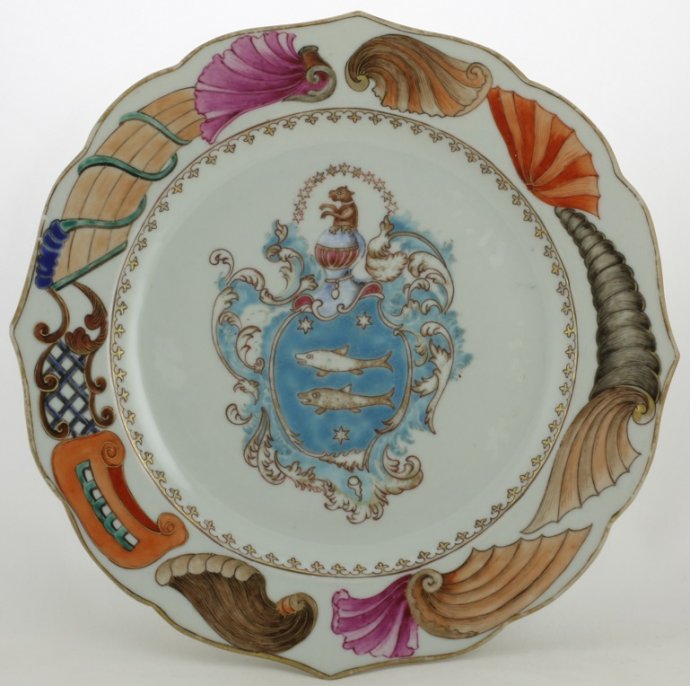
Sold Ceramics - Sold Chine de commande - Armorial / Pseudo-Armorial wares 1700-1800 - Armorial - Dutch - Page 1
Object 2011521
Dish
China
1740-1743
Height 24 mm (0.94 inch), diameter of rim 227 mm (8.93 inch), diameter of footring 123 mm (4.84 inch), weight 316 grams (11.15 ounce (oz.))
Dish on footring, flat, scalloped underglaze brown-edged (jia mangkou) rim. Polychrome decorated in pink, iron-red, gold, encre de Chine and blue or turquoise and brown overglaze enamels. Decorated in the centre with an asymmetrical shield: on a blue ground two red and gold fish one above the other, with three six-pointed stars; the crest a rampant bear with collar beneath an arch of twelve gold stars. The shield is surrounded by an enamelled cartouche with typical rococo ornaments of scrolls, feathering, branches and so on, in blue, iron-red and gold. On the sides a spearhead border and on the rim a shell, cornucopia and lattice ornaments border of European origin. The reverse is undecorated. (Kroes 2007, p.324)
Kroes states that traditionally it was believed these arms belonged to the Snoeck family from Amsterdam, but as it is pointed out in an article of 1997, they are in fact those of the Guillot family from Amsterdam. The first to attribute these plates to the Snoeck family was Goldsmith Phillips in 1956. His identification was based on Rietstap's Armorial Général. However, the Snoeck arms have two gnarled sticks between three stars, the sticks being misinterpreted by Rietstap as fish. Members of the Guillot family bore these arms from the early 1740's. As far as we know, only one member of the Guillot family went to the East Indies, making his fortune there, and must therefore be the one who ordered this beautiful armorial service. This was Elias Guillot (born Bordeaux, c.1695; died Batavia, 28 January 1743) Elias Guillot went to the Indies in 1714 where he started as a junior merchant and master of the warehouse in Masulipatnam (India) in 1715. In 1730 he was appointed senior merchant and chief of settlement of northern Coromandel, followed by his promotion to governor of Coromandel in 1733 (to 1737). In 1737 he moved to Batavia where he became extraordinary councillor of the Indies. This promotion could have prompted the order for this service. Shortly before he died in 1743 Elia Guillot became first councillor and director-general of the Indies (Kroes 2007, pp.324-325)
For identically decorated dishes, please see:
- China trade porcelain. An account of its historical background, manufacture, and decoration and a study of the Helena Woolworth McCann Collection, (J. Goldsmith Phillips, Harvard University Press, Cambridge, Massachusetts, 1956). p.71, Plate 5.
- Chinees porselein en aardewerk, (D.F. Lunsingh Scheurleer, De Haan, Bussum,1972), p.183, cat. 138.
- Chine de Commande, (D.F. Lunsingh Scheurleer, Hilversum, 1974), p.130, cat. 32.
- China for the West. Chinese Porcelain and other Decorative Arts for Export illustrated from the Mottahedeh Collection, (D.S. Howard & J. Ayers, Philip Wilson Publishers for Sotheby Parke Bernet Publications, London 1978), vol. 2, p.396, cat. 393.
- Important Chinese Export Porcelain and Chinese works of art from the Collection of the late Mildred R. and Rafi Y. Mottahedeh, auction sale catalogue 7520, Sotheby's New York, October 19, 2000, p.116, lot 259.
- Chinese Armorial Porcelain for the Dutch Market, Chinese Porcelain with Coats of Arms of Dutch Families, (J. Kroes, Waanders Publishers, Zwolle, 2007), p.32, XXXI & P.324, cat.no. 242a.
There is also another dinner service with the same arms but a different rim decoration. There are probably two varieties of this replacement service (which could also very well have been made just for decoration only) both made in the 19th century an enamelled in blue, iron-red and gold. The first being a 19th century Japanese porcelain version that according to Howard and Ayers might even be Dutch decorated. (Howard & Ayers 1978, vol. 2, p.397) Please see:
- China for the West. Chinese Porcelain and other Decorative Arts for Export illustrated from the Mottahedeh Collection, (D.S. Howard & J. Ayers, Philip Wilson Publishers for Sotheby Parke Bernet Publications, London 1978), vol. 2, pp.396-397, cat. 394.
- Chinese Armorial Porcelain for the Dutch Market, Chinese Porcelain with Coats of Arms of Dutch Families, (J. Kroes, Waanders Publishers, Zwolle, 2007), p.325, cat. no. 242b.
The second was produced by Samson in Paris in the second half of the 19th century. (Kroes 2007, p.325) Please see;
The dish's rather striking border design was inspired by patterns from a European rococo prototype. Although the design's specific origin is not presently known, Howard & Ayers suggest that it is possible that it originated with one of those artists who worked with Cornelis Pronk and were employed to find or invent suitable designs for the Dutch market.
Another possibility is that it has been copied from a Delft original. However the closest model for this border is found on faience from northern France at Rouen and Sinceny. Called décor à la corne, it incorporated the cornucopia and outsized shell motifs.
On Chinese export porcelain only two other examples of this border are known. The first is an identically shaped and polychrome decorated version depicting roosters amidst peonies and pierced rockwork. Please see;
- Chinese export porcelain in North America, (J. McClure Mudge, New York 2000), p.135, cat. 202.
- Treasures of Chinese Export Ceramics from the Peabody Essex Museum, (W.R. Sargent, Salem, Massachusetts, 2012), p.249, cat. 124.
The second is a dinner service in underglaze-blue made probably for the Dutch market and decorated with scenes of the cultivation and marketing of tea. All dishes are numbered on the reverse although there are occasional examples of the same scene with different numbers. Howard states that a set of twenty-four of these dishes is known in Holland. (Howard 1994, p.84)
For the numbered dinner service decorated in underglaze blue on Chinese export porcelain with scenes of the cultivation and marketing of tea, please see:
- Chineesche Ceramiek. Handboek. Geschreven naar aanleiding van de verzameling in het museum het Princessehof te Leeuwarden, (N. Ottema, N.V. Drukkerij en Uitgeverij J.H. de Bussy, Amsterdam 1943), p.190, cat. 216.
- China for the West. Chinese Porcelain and other Decorative Arts for Export illustrated from the Mottahedeh Collection, (D.S. Howard & J. Ayers, Philip Wilson Publishers for Sotheby Parke Bernet Publications, London 1978), vol. 1, pp.214-215, cat. 213 & 213a.
- The Choice of the Private Trader. The Private Market in Chinese Export Porcelain illustrated from the Hodroff Collection, (D.S. Howard, Zwemmer, London, 1994), p.84, cat. 69.
- Ceramics crossed overseas. Jingdezhen, Imari and Delft from the Collection of the Groninger Museum, (C.J.A. Jörg et al., Tokyo, 1999), p.75, cat. 98.
- Important Chinese Export Porcelain and Chinese works of art from the Collection of the late Mildred R. and Rafi Y. Mottahedeh, auction sale catalogue 7520, Sotheby's New York, October 19, 2000, p.86, lot number 192.
- Fine & Curious: Japanese Export Porcelain in Dutch Collections, (C.J.A. Jörg, Hotei Publishing, Amsterdam 2003), p.254 cat.326b.
- Treasures of Chinese Export Ceramics from the Peabody Essex Museum, (W.R. Sargent, Salem, Massachusetts, 2012), p.137, cat. 46.
For different varieties of the shell, cornucopia and lattice ornaments border design on Japanese export porcelain. Please see:
- Japans porselein met blauwe decoraties uit de tweede helft van de zeventiende en de eerste helft van de achttiende eeuw, (D.F. Lunsingh Scheurleer, in, Mededelingenblad Nederlandse Vereniging van Vrienden van de Ceramiek, vols. 64/65, 1971), p.71, cat. 60.
- Christie's pictorial history of Chinese ceramics, (A. du Boulay, Phaidon-Christie's, Oxford 1984), pp.200-201, cat. 9.
- Fine & Curious: Japanese Export Porcelain in Dutch Collections, (C.J.A. Jörg, Hotei Publishing, Amsterdam 2003), p.254 cat.326a/c/ & 327.
(sources: Howard & Ayers 1978, vol. 2, p.397), (Howard 1994, p.84), (Sargent 2012, p.138 & p.249)
This exceptional dish is beside beautiful also fascinating because of the many interesting stories and viewpoints on the history of Chinese export porcelain that can be connected with it.
Condition: Wear to the gold decoration, a firing flaw to the inner footring, two fleabites and a frit to the rim.
References:
Goldsmith Phillips 1956, p.71, Plate 5
Lunsingh Scheurleer 1971, cat. 60
Lunsingh Scheurleer 1972, p.183, cat. 138
Lunsingh Scheurleer 1974, cat. 32
Howard & Ayers 1978, vol. 1, cat 213 & 213a, vol. 2, cat. 393 & 394
Boulay 1984, pp.200-2001, cat. 9
Jörg 2003/1, cat. 326a/b/c & 327
Kroes 2007, p.32, XXXI & cat.no. 242a/b/c.
Sargent 2012, p.183 & cat. 46 & 124
Price: Sold.

Sold Ceramics - Sold Chine de commande - Armorial / Pseudo-Armorial wares 1700-1800 - Armorial - Dutch - Page 1
Object 2012640
Saucer
China
c.1740-1750
Height 20 mm (0.79 inch), diameter of rim 119 mm (4.69 inch), diameter of footring 69 mm (2.72 inch), weight 69 grams (2.43 ounce (oz.))
Saucer on footring, slightly flaring rim. Decorated in underglaze blue, encre de Chine (grisaille), iron-red and gold with a unknown coat of arms. The arms are impaled, 1. parted per fess, in each part a couped cross, 2. a covered jug. On the sides a band of lotus flowers and scrollwork in underglaze blue. The rim with an engrailed border with ball points in gold and rouge de fer. The reverse is undecorated.
This service, of which only one other saucer is known, is unidentified, but probably Dutch because it descended from Mrs. Jaaike Fellinga - Bouwes van Dijk (1814-1905), the grandmother of the Princessehof curator, Nanne Ottema (1874-1955), who in turn bequeathed it to this museum. Curiously, a martlet has been painted between the shield and the helmet which is surmounted by a coronet.
For this saucer, please see:
- Chinese Armorial Porcelain for the Dutch Market, Chinese Porcelain with Coats of Arms of Dutch Families, (J. Kroes, Waanders Publishers, Zwolle, 2007), p.440, cat. no. 316.
- Ottema-Kingma Stichting, Objectnummer NO 00576.
There are two other tea services known in this specific style namely:
The "J. de Wit 3", c.1741-1743 tea service
and
An unidentified probably Dutch coat of arms with monogram "HVSB", c.1740-1745
Condition: A tiny fleabite to the rim.
Reference:
Kroes 2007, cat. no. 360, 361 & S17
Collectie Keramiekmuseum Princessehof
Price: Sold.

Sold Ceramics - Sold Chine de commande - Armorial / Pseudo-Armorial wares 1700-1800 - Armorial - Dutch - Page 1
Object 2011877
Saucer
China
1745-1750
Provenance: Collection W. Angevaren, The Netherlands.
Height 28 mm (1.10 inch), diameter of rim 105 mm (4.13 inch), diameter of footring 60 mm (2.36 inch), weight 55 grams (1.94 ounce (oz.))
Saucer on footring, straight rim. Decorated in encre de Chine (grisaille) and gold with a coat of arms: on a black background a white (silver) griffin with gold wings: the crest a similar griffin. The mantling of scrolling featherlike leaves is partly filled with hatched lines. The coat of arms is surrounded by scattered flower sprays. Round the rim a spearhead border. On the base a circular paper dealers label that reads: 'Collectie W. Angevaren L16' and the handwritten 'L16' in blue ink.
This is the coat of arms of the Van Riemsdijk family, a large and leading family in the Dutch East Indies in the 1700s. In total three services are known bearing the Van Riemsdijk arms (Kroes 2007, cat. no. 165, 174 & 178) All of them were ordered by Jeremias van Riemsdijk (Utrecht 1712 - Batavia 1777). Two of them can be dated c. 1751. They were made on the occasion of the fourth marriage of Van Riemsdijk on May 2, 1751 to Adriana Louisa Helvetius (Batavia,1736-1772). Adriana was the daughter of Willem Vincent Helvetius (1705-1771) who also ordered an armorial service. Both services consist of dinner- and tea and coffee wares. The armorial design shows slight differences to the one on this saucer, particularly in the mantling. (Kroes 2007, p.188 cat. no. 103)
The earliest order was for a dinner service dated 1745-1750. It was ordered when Jeremias van Riemsdijk was second (1741) and first senior merchant (1742) and later captain of the clerks at the Castle of Batavia (1743-1747). Jeremias had a significant and influential social and family network, undoubtedly influenced by his no less than five wives of various influential families. His progression through Batavian society started in the 1750s with his appointment as extraordinary councillor of the Indies in 1754, ending as governor-general of the Dutch East Indies in 1775. It is interesting to note that he placed this order for armorial porcelain at a period of his life when he was not yet at the peak of his career. Of this dinner service only two pieces are recorded, a deep oval dish and a soup tureen. (Kroes 2007, p.262, cat 174)
There is a clear resemblance between the coat of arms on the saucer and the one on this early dinner service. It proofs that there was most likely a tea and coffee service which was ordered around or at the same time. This saucer, thus far unrecorded and only the third piece known with this particular Van Riemsdijk coat of arms, can therefore be considered quite rare.
For the identically decorated deep oval dish, please see:
For a saucer from the tea service decorated with the Van Riemsdijk I armorial design, please see:
For a soup dish from a dinner service decorated with the Van Riemsdijk and Helvetius accollé armorial design, please see:
Condition: A short hairline to the rim.
Reference:
Kroes 2007, cat. no. 103, 165, 174 & 178
Price: Sold.

Sold Ceramics - Sold Chine de commande - Armorial / Pseudo-Armorial wares 1700-1800 - Armorial - Dutch - Page 1
Object 2012533
Coffee cup and saucer
China
c.1746-1750
Height of coffee cup 71 mm (2.80 inch), diameter of rim 70 mm (2.76 inch), diameter of footring 39 mm (1.54 inch), weight 111 grams (3.92 ounce (oz.))
Height of saucer 26 mm (1.02 inch), diameter of rim 135 mm (5.31 inch), diameter of footring 79 mm (3.11 inch), weight 82 grams (2.89 ounce (oz.))
Published: Handel in Batavia - Teekultur aus fernen Lande / Trade in Batavia - Tea culture from a Faraway Land, exhibition catalogue Ostfriesisches Teemuseum Norden. (D. Suebsman, Norden 2023), pp.110-111, cat. 41, Schitterende Scherven. Archeologie, stillevens en verzamelingen, Held from 6 October 2024 to 9 February 2025 at the Veenkoloniaal Museum Veendam, The Netherlands, p.42, Afb. 24.
Exhibited: Handel in Batavia - Teekultur aus fernen Lande / Trade in Batavia - Tea culture from a Faraway Land held from 13 May 2023 to 31 October 2023 at the Ostfriesisches Teemuseum Norden Germany, Schitterende Scherven. Archeologie, stillevens en verzamelingen, Held from 6 October 2024 to 9 February 2025 at the Veenkoloniaal Museum Veendam, The Netherlands.
Coffee cup and saucer on footrings, slightly everted rims, handle missing on cup. Decorated in various overglaze enamels, iron-red, black and gold with a two large coats of arms accollé. Round the rim a spearhead border. The coffee cup is decorated en suite with two extra flower prays.
The dexter arms are in an asymmetrical rococo style shield: on a blue background a black (oxidized silver) walking paschal lamb with cross and banner; the crest a coronet surmounted by a pair of blue wings. The sinister arms are painted in an oval shield: on a blue background a black (oxidized silver) bent and armoured arm holding a gold ring in its hand, emerging from a black cloud at the sinister side of the shield; the crest a coronet with a similar upright arm and ring between a pair of blue and grey (silver?) trunks. Rocaillerie scrollwork in black and blue enamels surrounds both shields and underneath there are two tasseled ropes and banderoles inscribed: 'WOLTHERS' at the dexter and 'CONRING' at the sinister side. (Kroes 2007, p.404)
The arms of the Wolthers family from Groningen arms are not recorded before the late 18th century, but they probably originate before this. The Conring(h) arms were recorded in the 1660s in Emden Germany from where this family originated. This service was ordered for Harmen Wolthers (1721-1788) and Louisa Christina Conring(h) (1727-1766) on the occasion of their marriage in Groningen on 23 January 1746 and was thus probably made in the late 1740s. (Kroes 2007, p.404)
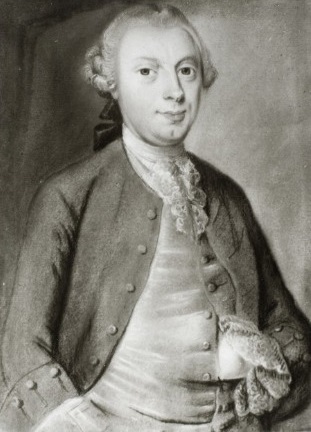
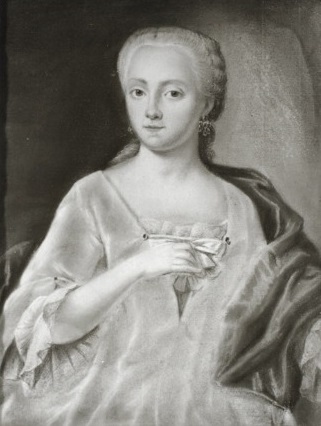
Harmen Wolthers (1721-1788) Louisa Christina Conring(h) (1727-1766)
(Source: www.openarch.nl en www.genealogieonline.nl)
The Wolthers family was a leading one in the city of Groningen from the early 17th until the late 18th century. Harmen's father, Wolther Wolthers (1696-1728), was Burgomaster of Groningen; he married Clara van Buttingha (1695-1722) and Harmen was their only child.
Wolter Wolthers (1696-1728) Clara van Buttingha (1695-1722)
(Source: Groninger Museum) (Source: Groninger Museum)
Harmen Wolthers (born Groningen, 8 October 1721; died Groningen 26 March 1788) began his public career in Groningen as gezworene or member of the city council (1748-1768), later raadsheer en taalman, councillor and/or alderman (1773-1786), but he was never appointed burgomaster. In addition, he held various other posts in regional and national government, such as delegate to the States General (1763), member of the Provincial Audit Office (1770-), councillor of the Admiralty of Harlingen (1775,1778) and member of the Provincial Executive (1784). In the late 18th century, he was known to sympathize with the patriotic cause. He was a member of several cultural societies, such as the Leesgezelschap, a reading circle in Groningen (1783). In 1785 he was one of the highest taxpayers in the city, living at the Vismarkt South Side at the time.
Harmen's wife Louisa Conring(h) (born Groningen, 22 August 1727; died Groningen, 29 April 1766) was the daughter of the city councillor Andreas Conring(h) (1696-1754) and Christina Elisabeth Sichterman (1710-1730). Conring(h) was born in Emden, East Friesland, where his ancestors were recorded as early as the mid-16th century with several family members holding senior positions in the church and public office. (Kroes 2007, pp.404-405)
Baptism of Louisa Christina Conring on August 22, 1727 in Groningen; Martinikerk (Netherlands)
(Source: www.openarch.nl en www.genealogieonline.nl)
Andreas Conring(h) (1696-1754) Christina Elisabeth Sichterman (1710-1730).
Oosterstraat 44, Groningen, the house where Andreas Conring(h) (1696-1754) and Christina Elisabeth Sichterman (1710-1730) lived. (Source: Groninger Archieven)
Louisa's mother Christina Elisabeth Sichterman (1710-1730) was the daughter of Gerrit Sichterman, the brother of Jan Albert Sichterman, who ordered a remarkable quantity of armorial porcelain.
Harmen Wolthers had eight children of whom one son, Wolther Wolthers (1756-1811), had a public career like his father, being trustee of the orphanage and raadsheer or city councillor. Four of their daughters married into principal Groningen families: Trip (1768), Alberda van Bloemersma (1777). Lewe (1781), Van der Hoop (1774), De Sandra Veltman (1768) and Van Vierssen (1779). As mentioned earlier a considerable part of this service descended to the Van der Hoop family. (Kroes 2007, pp.405)
Suebsman states that it is unknown, whether the service, of which merely a tea set exists, was commissioned by Dutch East India Company, (Vereenigde Oost-Indische Compagnie, VOC) representatives of Amsterdam or by members of the Royal Prussian Asian Company (Königlich- Preussische Asiatische Handelscompagnie (KPACVE)) of Emden for a future anniversary. (Suebsman 2023, p.110)
When the tea service was made for the occasion of the wedding in 1746 than the order must have gone through Amsterdam by the Dutch East India Company, (Vereenigde Oost-Indische Compagnie, VOC). However, if one assumes that the Royal Prussian Asian Company in Emden carried out the order, then the porcelain would have been ordered between 1752 and 1756, the period in which the Company in Emden was active and imported porcelain from China through the Emden merchants themselves. The yet unknown shape and size of this recently discovered coffee cup (with the larger saucer 135 mm (5.31 inch), compared to the saucer of the tea set 120 mm (4.72 inch), indicates that besides a tea service there must also have been a coffee service. (Ramm, pp.17-19)
For an identically decorated tea bowl and saucer, please see:
- Toelichtende beschrijving van de verzameling Chineesch en Japansch porselein, Chineesch en Europeesch rood steengoed en aardewerk, aanwezig in het Groningsch Museum / Catalogue of Oriental Ceramics and European Earthenware in the Collection of the Groninger Museum, (M.A. de Visser, Groningen, 1930), cat. 43.
- Chinese Armorial Porcelain for the Dutch Market, Chinese Porcelain with Coats of Arms of Dutch Families, (J. Kroes, Waanders Publishers, Zwolle, 2007), pp.404-405, cat.no. 322.
- Groningen Museum Object number: 0000.4086.A.
For an identically decorated tea caddy in the collection of the Groninger Museum, please see:
Condition coffee cup: Missing handle and a frit to the rim.
Condition saucer: Restored rim.
References:
Kroes 2007, cat.no. 281a, cat.no. 281 & cat.no. 376
Vister - van Riemsdijk 2024, Afb. 24
Groninger Archieven
Price: Sold.

Sold Ceramics - Sold Chine de commande - Armorial / Pseudo-Armorial wares 1700-1800 - Armorial - Dutch - Page 1
Object 2012539
Tea bowl and saucer
China
1750-1755
Height of tea bowl 50 mm (1.96 inch), diameter of rim 80 mm (3.15 inch), diameter of footring 30 mm (1.18 inch), weight 76 grams (2.68 ounce (oz.))
Height of saucer 31 mm (1.22 inch), diameter of rim 137 mm (5.39 inch), diameter of footring 78 mm (3.07 inch), weight 120 grams (4.23 ounce (oz.))
Tea bowl and saucer on footrings, the wide tea bowl with handle, slightly everted rims. Decorated in various overglaze enamels, iron-red, black and gold with a coat of arms on the sides a bouquet in pink, orange, lilac and green, fruit and grain with grapes, turnips a pomegranate and a butterfly and a crane all in predominantly European (Mesissen) style. The edges of the rims gilded. The reverse is undecorated. The tea bowl is decorated en suite.
The coat of arms show in the centre of the saucer two large coats of arms accollé in rococo style. The dexster shield is asymmetrical: quarterly, 1. on a gold background a red withered branch, 2. on a green (correctly blue) background three white (silver) bulls' heads, 3. on a red background a (gold) bag or basket filled with (gold?) wheat, 4. on a gold background a red lobster; with a shield of pretence: three black cramps (two-one). These are the arms of Scholten with Aschat in a shield of pretence.
The sinister arms in an oval shield are also quarterly, 1. on a red background three gold weasels (two-one), 2. parted per fess, A. plain gold, B. on a blue background three silver shells (one-two), 3. on a blue background three gold bars charged with nine red saltires (four-three-one), 4. on a red background a gold or silver horn. These are the arms of Van Wesele, with Van Wesele in the first quarter, Fannius in the second, Van Persijn in the third and Guldewagen in the fourth quarter.
The shields are supported by a lion at the dexter and a griffin looking back at the sinister side both standing on a pedestal of scrolling leaves and branches together with a shell, with a gold coronet above.
This is the first service made for Christiaan Scholten (born Amsterdam, 13 June 1722; buried Amsterdam, 6 november 1799) and his wife Johanna Catharina van Wesele (1733-1781) whom he married in The Hague on 22 or 23 December 1750. On the occasion of their silver wedding anniversary in 1775 they ordered a second tea service decorated in underglaze blue. The arms on the services are different: this one is having a coronet and a different design of pedestal and here the Scholten arms have different shield of pretence. The three cramps are the manorial arms of Aschat which Christiaan wasn't entitled to bear until his father's death in 1722.
Christiaan Scholten (1722-1799) belonged to a wealthy, leading Amsterdam family who were clearly interested in armorial porcelain. His father Jan Agges Scholten (1690-1772) and mother Petronella Hoogenberg (1694-1765) ordered several services and his sister, Sophia Petronalla Scholten (1729-1782) who married in 1757 Jean Benjamin du Peyrou (1727-1786) ordered two services.
Group portrait of the four chief commissioners of the ports, quays and cranes in Amsterdam, sitting around a table (from the left to right): Jan Agges Scholten, Jacobus du Peyrou, Carel Lijnslager, Hendrik van Castricum (Jan Maurits Quinkhard 1688–1772) (1747) (not included in this sale/offer)
The building at Oudeschans 6 in Amsterdam was purchased in 1717 by tobacco merchant Jan Agges Scholten, Lord of Aschat. He had this building renovated and the medallions with their faces placed in the facade. John is depicted as an acclaimed Roman emperor. Petronella wears an ancient Greek robe. It is striking that their faces are turned away from each other. The statues are attributed to sculptor Anthonie Turck (1667-1725).
Saucer, China, c.1740 ordered by Christiaan's father Jan Agges Scholten (1690-1772) and mother Petronella Hoogenberg (1694-1765). (not included in this sale/offer) (picture source: Wikipedia)
Christiaan studied law at Leiden University, and he became a solicitor in Amsterdam on 3 December 1743. He held several public posts but never took part in the city council of Amsterdam. Nevertheless, he became very wealthy, particularly after his marriage in 1750. Through his wife he inherited the title of baron or vrijheer van Oud-Haarlem and Kortenbosch and after his father's death in 1772 the title of lord of the manor or heer van Aschat. On 2 September 1777, he purchased a country seat in Ouder-Amstel, the hofstede Lindenhove, formerly Middenrust, situated at the Ringsloot in the Duivendrecht Polder for HFL 3,350
Christiaan's wife, Johanna Catharina van Wesele (born Amsterdam, 3 March 1733; buried Amsterdam, 7 January 1784) was the daughter of Anthony van Wesele and Cornelia Fannius, Baron and Baroness or vrijheer en vrijvrouwe van Oud-Haarlem en Kortenbosch. These titles came from the ancestral family of Fannius from Zeeland. The other ancestral line of Guldewagen belonged to the patrician class of Haarlem during the 17th centrury.
Group portrait of the four chief commissioners of the ports, quays and cranes in Amsterdam, sitting around a table (from the left to right): Christiaan Scholten, Christiaan van Orsoy, Jan Petrus Scholten van Aschat and Frederick Alexander Vernède. On the table some books, paper and an inkstand. On the back the weapons of the four portrayed men. (1791-1795) (not included in this sale/offer)
It is interesting to note that both Christiaan and his father had good connections with the Stadholder's family, however both were far from popular within Amsterdam higher circles. Christiaan was criticized because of his poor conduct as can be red in the following 'ode'.
Ode aen den heere Christian Scholten van A-schat, oppercommissaris van de Waelen, &c.. &c. (not included in this sale/offer)
(Publisher: Hendrik Tielman, 1753)
(source: Koninklijke Bibliotheek)
Christiaan and Johanna Catharina had four sons and one daughter. The eldest son, Willem Scholten (1751-1845) inherited the title of baron or vrijheer van Oud-Haarlem en Kortenbosch. and he and his descendants therefore took the name of Scholten van Oud-Haarlem. The second son, Joan Petrus (1754-1816), was called Scholten van Aschat. He might have helped his parents with the order of their second service in 1775 on the occasion of their silver wedding anniversary for which also s silver memorial medal dated 22 December 1775 was struck, because he was a clerk in the warehouse office of the Dutch East India Company, (Vereenigde Oost-Indische Compagnie, VOC) Chamber Amsterdam from 1768 until 1786. In 1786 he became director of the VOC, later becoming city councillor (1788-1795). The third son Benjamin Petrus (1762-1829), was called Van Wesele Scholten and he was a pensionary of Schiedam and of Delft.. The youngest son, Jhr. Cornelis Anthony (1767-1832) Fannius Scholten, was ennobled in 1815 bearing the title of jonkheer. He married in 1794 his first cousin Maria Helena du Peyrou (1770-?), the daughter of Jean Benjamin du Peyrou and Sophia Petronella Scholten, Christiaan's sister. The armorial service of Du Peyrou and Scholten probably came into the Scholten family through this line.
(Kroes 2007, pp.212-213, pp.352-353)
A 24-piece tea service is still in the family, comprising a teapot in Meissen style, with moulded spout and bracket handle, with a domed cover and a fruit finial, an oval or rectangular tea caddy, the cover with a gold lion finial, a slop bowl, a tall cup without handle, ten cups with handle and nine saucers. In the 1990s a tall cup and saucer were sold at Christie's New York. (Kroes 2007, p.352)
For an identically decorated saucer, please see:
For a milk jug, decorated with the identically armorial design, please see:
Condition tea bowl: A hairline to the rim and a restored (re-stuck) handle.
Condition saucer: A hairline to the rim.
References:
Price: Sold.
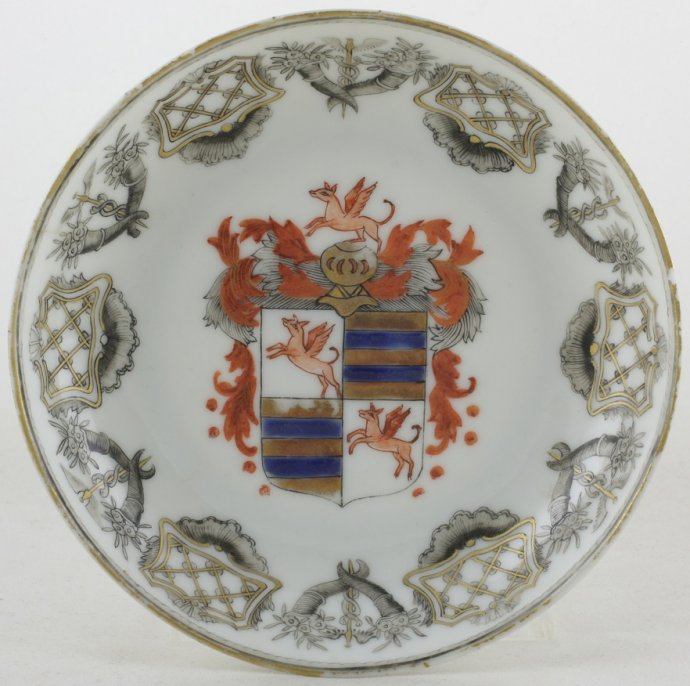
Sold Ceramics - Sold Chine de commande - Armorial / Pseudo-Armorial wares 1700-1800 - Armorial - Dutch - Page 1
Object 2012454
Saucer
China
1750-1760
Height 21 mm (0.82 inch), diameter of rim 115 mm (4.53 inch), diameter of footring 69 mm (2.72 inch), weight 59 grams (2.08 ounce (oz.))
Saucer on footring, straight rim. Decorated in encre de Chine (grisaille), iron-red, gold and blue enamel with a yet unknown coat of arms: the arms are quarterly, 1. and 4. a pegasus, 2. and 3. two bars. The crest a pegasus on top of coronet. The mantling comprises symmetrical scrollwork and ropes of pearls in European style. Round the rim strapwork in Du Paquier style. The reverse is undecorated.
Saucer, part of a tea service of which15 pieces were sold at Sotheby's Amsterdam in 1994 comprising a teapot, milk jug, sugar bowl with cover, a teapot stand, a saucer dish, five tea cups and five saucers. In addition to the illustrated saucer, one other turned up in a private collection and two milk jugs of h. 13.3 cm were sold at Christie's London in 1999. The arms have been incorrectly attributed to the Stapert family from Friesland. They are probably the arms of a Frisian or East Frisian family: in the Amsterdam 1994 sale two other lots in the same section - and possibly from the same collection or collector - comprised porcelain with Frisian and East Frisian arms, such as De Pottere and Van Wingene. (Kroes 2007, pp.532-533)
For this specific saucer, please see:
Condition: Some popped bubbles of glaze, caused by the firing process, a fleabite, a short hairline and two frits one with a short, connected hairline all to the rim.
Reference:
Price: Sold.
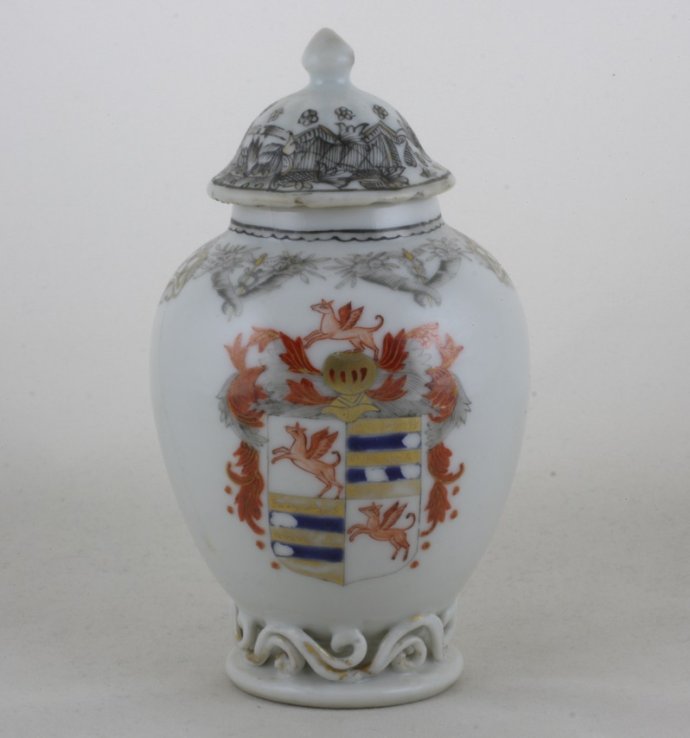
Sold Ceramics - Sold Chine de commande - Armorial / Pseudo-Armorial wares 1700-1800 - Armorial - Dutch - Page 1
Object 2012628
Tea caddy
China
1750-1760
Height including cover 129 mm (5.07 inch), height excluding cover 98 mm (3.85 inch), diameter 74 mm (2.91 inch), diameter mouthrim 35 mm (1.38 inch), diameter of footring 40 mm (1.57 inch), weight with cover 171 grams (6.03 ounce (oz.)), weight cover 35 grams (1.23 ounce (oz.))
Tea caddy of ovoid form on footring, domed cover (not matching) with a pointed knob. Applied scroll work at the spreading foot. Decorated on two sides in encre de Chine (grisaille), iron-red, gold and blue enamel with a yet unknown coat of arms: the arms are quarterly, 1. and 4. a pegasus, 2. and 3. two bars. The crest a pegasus on top of coronet. The mantling comprise symmetrical scrollwork and ropes of pearls in European style. On the shoulder strapwork in Du Paquier style.
A tea service of which15 pieces were sold at Sotheby's Amsterdam in 1994 comprising a teapot, milk jug, sugar bowl with cover, a teapot stand, a saucer dish, five tea bowls and five saucers. In addition to the illustrated saucer, one other turned up in a private collection and two milk jugs of h. 13.3 cm were sold at Christie's London in 1999. The arms have been incorrectly attributed to the Stapert family from Friesland. They are probably the arms of a Frisian or East Frisian family: in the Amsterdam 1994 sale two other lots in the same section - and possibly from the same collection or collector - comprised porcelain with Frisian and East Frisian arms, such as De Pottere and Van Wingene. (Kroes 2007, pp.532-533)
For this specific saucer, please see:
Condition: Three hairlines to the body, issuing from one spot, circling the entire body. The nonmatching cover with some frits to the underside of the rim.
Reference:
Price: Sold.

Sold Ceramics - Sold Chine de commande - Armorial / Pseudo-Armorial wares 1700-1800 - Armorial - Dutch - Page 1
Object 2012597 & 2012598
Two saucers
China
1755-1760
2012597: Height 19 mm (0.75 inch), diameter of rim 113 mm (4.45 inch), diameter of footring 67 mm (2.64 inch), weight 50 grams (1.76 ounce (oz.))
2012598: Height 22 mm (0.87 inch), diameter of rim 111 mm (4.37 inch), diameter of footring 68 mm (2.68 inch), weight 54 grams (1.90 ounce (oz.))
Two saucers on footrings, straight rims with slightly flaring edges. Decorated in various polychrome enamels and gold with a coat of arms surrounded by an oval cartouche consisting of a garland in gold: quarterly: 1. and 4. on a blue background a white swan (silver) rising bird, with a twig in its bill and its right foot raised. 2. and 3. on a gold background three green fleur-de-lis (two-one) and a narrow red bar in chief: the crest is a similar rising bird. The mantling comprises scrolling leaves and a hatched background in gold and rouge de fer. On the sides a gold bamboo design with six flower sprays (peony and prunus) in blue, pink, green, yellow, rouge de fer, white and gold. The edge of the rim in gold. The reverse is undecorated. (Kroes 2007, p.256)
These quarterly arms are those of the Schagen family from Hoorn. It was borne this way in the 1730s by Joan Schagen (1698-1762) and later in the 1750s and 1760s by his son Pieter Schagen (1729-1791) and by Joan's nephew Joan Allard Schagen (1713-1768). Their arms correctly, as shown on seals and an eschutcheon from this period, have a slightly different design and colouring: a silver dove standing on a gold ring and three blue fleurs-de-lis (without a red bar in chief). The first and third quarters with the bird are the original Schagen arms, while that of the fleurs-delis quatres descends from the Van Someren family from Utrecht with Johan van Someren who was deacon of the St. John's Chapter of Utrecht (1666-1674). These families were connected by the marriage of Sibilla van Someren and Johan Schagen, the great-great-grandparents of the forementioned Joan Allard Schagen (1713-1768).
Two members of the Schagen family could have commissioned this armorial service: Joan Allard Schagen (41713-1768) or his cousin Pieter Schagen (1929-1791). Thet were both councillors of Hoorn an directors of the VOC Chamber Hoorn, Joan Allard from 1753 to 1768 and Pieter from 1776 to 1791. This porcelain was made about 1755-1760, thus Joan Allard Schagen is most likely.
From the third quarter of the 17th-century the Schagens belonged to the patrician families of Hoorn and were also strongly connected with the Dutch East India Company, (Vereenigde Oost-Indische Compagnie, VOC). Two brothers, Gerard Schagen (1688-1727) and Joan Schagen (1698-1762), both members of the Hoorn city council, were the fathers of Joan Allard and Pieter.
Joan Allard Schagen (born Hoorn, 8 October 1713; died Hoorn, 7July 1768) began his public career in 1735 when he was appointed alderman at the age of 22. in 1738 he was alderman again, then councillor in 1740 (until 1768). In the 1750s and 1760s he was also elected burgomaster for eight terms. Furthermore, he was director of the Levant Trade (1739-1740) and director of the VOV from 1753 as mentioned earlier. He would have ordered this tea service in the late 1750s soon after joining the VOC board. he also held several other positions such as trustee of the orphanage (1736-1737, 1743-1744), trustee of the old people's home (1739, 1741-1742), churchwarden (from1749) and so on. In spite of all these activities his fortune was not that large: in 1768 his estate amounted to the sum of only HFL. 40,338.
Jaon Allard married on 18 december 1735 Bartha Petronella Bost( 1708-1767), the daughter of Jan Bost, burgomaster of Edam. The had five children between 1737 and 1745 but Gerard Jan (1745-1775) was the only one who survived. He was alderman of Hoorn and director of the Levant Trade (1767-1768).
The second possible commissioner, Pieter Schagen (born Hoorn, 29 November 1729; died Hoorn, 3 June 1791), was a member of the Hoorn city council from 1750, alderman (1750) and burgomaster for ten terms during the 1770s and 1780s. Like his cousin he had several additional posts, such as trustee of the orphanage, churchwarden. director of the Levant Trade (1758-1759), director of the West-Indian Company (West-Indische Compagnie WIC) from 1776 until his death in 1791. From his marriage (11 November 1753) to maria Berkhout (1731-1792) he had three children, of whom the youngest Joan Schagen (1762-1812) became alderman in 1785). (Kroes 2007, pp.256-257)
'Villa Alewijn' Grote Oost 26, 1621 BW Hoorn. Throughout the eighteenth century this building was owned by members of the prominent Schagen family and in the nineteenth century by the noble Alewijn family.
Marriage book entry Joan Allard Schagen (1713-1768 and Bartha Petronella Bost (1708-1767)
Source: Waterlands Archief, Trouwen Edam en Volendam 1581-1811 Edam Archief 0234, inventarisnummer 39a.
Signature of Joan Allard Schagen.
Source; Notariële archieven, Amsterdam inventarisnummer 12365, aktenummer 66945.
Burial book Grote Kerk Hoorn (1755-1816), dated 22 July 1768, Joan Allard Schagen (1713-1768)
Source: Marriage and burial books Hoorn, 1579-1874, inventarisnummer 8439a.
Kroes states that a tea bowl and saucer, part of a tea and coffee service with a least one other saucer and coffee cup is known, please see:
Only six services (1.3%) were decorated with bamboo borders for the Dutch market. The main design was a bamboo band with entwined flowers, fruits and leaves, in several cases with spearhead, small flowers and later line decoration. Most are polychrome enamels. Bamboo is the last style with predominant Chinese features, being fashionable in the 1750s. Some services were also made in the 1760s and again in the 1780s. (Kroes 2007, p.27)
Condition:
2012597: Some fleabites and a chip to the rim.
2012598: Some fleabites to the rim.
References:
Waterlands Archief, Trouwen Edam en Volendam 1581-1811 Edam Archief 0234, inventarisnummer 39a
Notariële archieven, Amsterdam inventarisnummer 12365, aktenummer 66945.
Marriage and burial books Hoorn, 1579-1874, inventarisnummer 8439a.
Price: Sold.

Sold Ceramics - Sold Chine de commande - Armorial / Pseudo-Armorial wares 1700-1800 - Armorial - Dutch - Page 1
Object 2011087
Teacup and saucer
China
c.1765
Height of teacup 44 mm (1.73 inch), diameter of rim 75 mm (2.95 inch), diameter of footring 35 mm (1.38 inch), weight 45 grams (1.59 ounce (oz.))
Height of saucer 28 mm (1.10 inch), diameter of rim 135 mm (5.31 inch), diameter of footring 82 mm (3.23 inch), weight 99 grams (3.49 ounce (oz.))
Teacup and saucer on footrings, slightly everted rims. Decorated in various overglaze enamels, iron-red, black and gold with a coat of arms surrounded by four large and four small flower sprays in European style. Round the rims a chain-pattern border. The teacup is decorated en suite.
The coat of arms show: on a gold background a red arched bend; the crest a gold coronet with above an eagle's claw upside down. The mantling comprises scrolling leaves in red and grisaille. These are the arms of "Van der Burch" from Delft and other major Dutch cities. The "Van der Burch" family is a very ancient one with its genealogy reaching back to the mid-14th century.
This tea bowl was part of a tea service that can be dated to the mid-1760s. At least seven people could have commissioned it, however the most likely is Frans Jansz. van der Burch (1718-1775). He was the city councillor of Delft from 1748 and he became director of the Dutch East India Company, (Vereenigde Oost-Indische Compagnie, VOC) in 1765. This event in particular might have induced him to order both a dinner and tea service with his family arms. Kroes mentions that of this dinner service only an oval dinner platter is known and from the tea service only a tea caddy without cover is known. (Kroes 2007, p.363 & p.453)
In the collection of the Groninger Museum is a metal tobacco box made in Japan in the mid-18th century, with the same coat of arms of the Van der Burch family and an inscription: "FRANC(O) REYERSZ VANDER BURCH". In literature the word Franc(o) has been wrongly interpreted as "Sibrant", please see the following two pictures.
Both images reproduced from: Chinese Armorial Porcelain for the Dutch Market, Chinese Porcelain with Coats of Arms of Dutch Families, (J. Kroes, Waanders Publishers, Zwolle, 2007), p.363, cat.no. 281b. (copyright in bibliographic data and cover images is held by the publisher or by their respective licensors: all rights reserved)
For an identically shaped, sized and decorated tea bowl and cover that was donated by me in 2012 to the collection of Oriental ceramics of the Groninger Museum, please see:
For an oval platter and a tea-caddy, with identically armorial design, please see:
For the metal tobacco box in the collection of the Groninger Museum made in Japan in the mid-18th century, with the same coat of arms of the Van der Burch family and an inscription: "FRANC(O) REYERSZ VANDER BURCH", please see:
Condition teacup: Restored.
Condition saucer: Restored.
Reference:
Kroes 2007, cat.no. 281a, cat.no. 281 & cat.no. 376
Donated to the collection Oriental ceramics of the Groninger Museum, Groningen, The Netherlands.
More pictures of object 2011171, another identically shaped, sized and decorated, sold tea bowl >>
More pictures of object 2011172, another identically shaped, sized and decorated, sold tea bowl >>
More pictures of object 2011173, another identically shaped, sized and decorated, sold tea bowl >>

Sold Ceramics - Sold Chine de commande - Armorial / Pseudo-Armorial wares 1700-1800 - Armorial - Dutch - Page 1
Object 2012632
Part of a coffee and tea service of nineteen pieces; a coffee pot, a stand, a slop bowl, four tea bowls, four coffee cups, two tea bowl saucers and six coffee cup saucers.
China
c.1765-1770
Height of coffee pot with cover 255 mm (10.04 inch), height without cover 190 mm (7.48 inch), diameter rim 75 mm (2.95 inch), diameter footring 122 mm (4.80 inch), diameter handle to spout 230 mm (9.06 inch), weight including cover 1,048 grams (36.97 ounce (oz.)), weight cover 129 grams (4.55 ounce (oz.))
Height of coffee pot stand 27 mm (1.06 inch), dimensions rim 230 mm (9.06 inch) x 180 mm (7.09 inch), weight 340 grams (11.99 ounce (oz.))
Height of slop bowl 77 mm (3.03 inch), diameter of rim 166 mm (6.54 inch), diameter of footring 79 mm (3.11 inch), weight 373 grams (13.16 ounce (oz.))
Tea bowls:
1. Height 44 mm (1.73 inch), diameter of rim 78 mm (3.07 inch), diameter of footring 37 mm (1.46 inch), weight 50 grams (1.76 ounce (oz.))
2. Height 44 mm (1.73 inch), diameter of rim 78 mm (3.07 inch), diameter of footring 36 mm (1.42 inch), weight 62 grams (2.19 ounce (oz.))
3. Height 42 mm (1.65 inch), diameter of rim 76 mm (2.99 inch), diameter of footring 36 mm (1.42 inch), weight 56 grams (1.98 ounce (oz.))
4. Height 42 mm (1.65 inch), diameter of rim 76 mm (2.99 inch), diameter of footring 36 mm (1.42 inch), weight 56 grams (1.98 ounce (oz.))
Tea bowl saucers:
1.Height 32 mm (1.26 inch), diameter of rim 122 mm (4.80 inch), diameter of footring 66 mm (2.60 inch), weight 106 grams (3.74 ounce (oz.))
2.Height 31 mm (1.22 inch), diameter of rim 124 mm (4.88 inch), diameter of footring 66 mm (2.60 inch), weight 112 grams (3.95 ounce (oz.))
Coffee cup saucers:
1.Height 32 mm (1.26 inch), diameter of rim 139 mm (5.47 inch), diameter of footring 74 mm (2.91 inch), weight 118 grams (4.16 ounce (oz.))
2.Height 32 mm (1.26 inch), diameter of rim 140 mm (5.51 inch), diameter of footring 75 mm (2.95 inch), weight 115 grams (4.06 ounce (oz.))
3.Height 31 mm (1.22 inch), diameter of rim 137 mm (5.39 inch), diameter of footring 72 mm (2.83 inch), weight 117 grams (4.13 ounce (oz.))
4.Height 32 mm (1.26 inch), diameter of rim 136 mm (5.35 inch), diameter of footring 80 mm (3.15 inch), weight 128 grams (4.52 ounce (oz.))
5.Height 32 mm (1.26 inch), diameter of rim 136 mm (5.35 inch), diameter of footring 75 mm (2.95 inch), weight 115 grams (4.06 ounce (oz.))
6.Height 31 mm (1.22 inch), diameter of rim 140 mm (5.51 inch), diameter of footring 75 mm (2.95 inch), weight 117 grams (4.13 ounce (oz.))
Coffe cups:
1.Height 65 mm (2.56 inch), diameter of rim 66 mm (2.60 inch), diameter of footring 35 mm (1.38 inch), weight 93 grams (3.28 ounce (oz.))
2.Height 66 mm (2.60 inch), diameter of rim 65 mm (2.56 inch), diameter of footring 34 mm (1.34 inch), weight 100 grams (3.53 ounce (oz.))
3.Height 65 mm (2.56 inch), diameter of rim 66 mm (2.60 inch), diameter of footring 35 mm (1.38 inch), weight 107 grams (3.77 ounce (oz.))
4.Height 67 mm (2.64 inch), diameter of rim 65 mm (2.65 inch), diameter of footring 35 mm (1.38 inch), weight 89 grams (3.14 ounce (oz.))
Part of a coffee and tea service of nineteen pieces. All objects decorated in various overglaze enamels, iron-red, black and gold with the arms of Romswinckel in the center, on a red background three gold concentric circles; the crest a gold coronet surmounted by three similar gold circles with three pink plumes above. Round the rims garlands with broad bands of pink and green flowering leaves.
The coat of arms show: on a red background three gold concentric circles; the crest a gold coronet surmounted by three similar gold circles with three pink plumes above.
These are the arms of Romswinckel from the Cleves district in Germany, with younger branches in Amsterdam, Leiden and the East Indies. They were borne this way as early as 1588 by Mathias Romswinckel as richter or judge of Goch, Germany.
About 1778-1782 the Romswinckel family also had an armorial service made of Loosdrecht porcelain of which a plate with a scalloped rim is known. The armorials of the two Chinese services I & II are very similar, with only small differences in the mantling. However, the arms on the Loosdrecht plate are rather different: the shield having a coronet above and being surrounded by garlands and branches tied by a ribbon beneath.
Romswinckel I Chinese tea service c.1765-1770, the only known pieces of this tea service.
(Image reproduced from: Chinese Armorial Porcelain for the Dutch Market, Chinese Porcelain with Coats of Arms of Dutch Families, (J. Kroes, Waanders Publishers, Zwolle, 2007), p.343, cat.no. 262. (copyright in data and images is held by the publisher or by their respective licensors: all rights reserved))
The Reverend Ds. Johannes Romswinckel (1614-1661) moved from Müllheim, Germany to Holland becomming the founder of the Dutch Romswinckel branch. Members of this family in both leiden and Amsterdam rose to senior positions. It is most likely that someone within the Leiden branch commissioned this service. Nicolaas Romswinckel (Archangel 1707: Leiden 1755), solicitor and from 1742 councillor of Leiden, married in 1732 Catharina Marcus (1713-1775). They had 14 children of whom at least three sons could have ordered this porcelain in the late 1760s: Nicolaas Abraham (1733), Matthijs (1741) and Joost (1745). Nicolaas himself was a solicitor in Leiden and joined the city council in 1742, he was also alderman for a couple of years from 1749.
His eldest son Nicolaas Abraham Romswinckel (born Leiden, 10 January 1733; Died Leiden 10 October 1823) studied law at Leiden University graduating in 1755. He was a solicitor in Leiden and Haarlem and from 1773 sheriff and secretary of Nieuwerveen and Zevenhoven, two villages near Leiden. He married twice, first on 11 january 1761 to Johanna Dorothea Sellius (1736-1780) and in 1782 to Nicasia Johanna Kip (died 1797). One of his sons was Joost Carel Romswinckel (Haarlem 1772; Batavia 1846) who had a remaarkable career in the East Indies, startinmg about 1795 as assitent and in 1808 being appointed extraordinary councillor of the Indies. He married in 1801 a girl from a prominent family in the Dutch East Indies, Catharina Wilhelmina van Stockum (1761-1806), who was the daughter of the councillor of the Indies Hendrik van Stockum, and Catharina Elisabeth Romswinckel. They ordered an armorial service in the late 18th century. Catharina Elisabeth (1744-1785) was the daughter of Matthijs Romswinckel( 1702-1750), Nicolaas Senior's brother and thus these brothers were cousins. Matthijs had been in Batavia since 1741, first as junior merchant and from 1745 as vendumeester or auctioneer.
The second son, Matthijs Romswinckel (born Leiden, 28 february 1741; died Amsterdam, 7 March 1796) settled in Amsterdam after 1761, where he became bookkeeper of the stadsimpost, a local tax (1761-1767) trustee of the St. Pietergasthuis (1768) and director of the VOC Chamber Amsterdam 1786. He never married.
Although still a rather young when this porcelain was made, the third son could also have ordered this service and the Lossdrecht set later. This was Joost Romswinckel (born Leiden, 20 december 1745; died The Hague, 28 May 1824) who studied law at Utrecht Universityand started his career in Leiden as a soliciter in 1770. He had been a captain of the citizn guard there from 1767 (until 1773). In 1771 he entered the city council as vroedschap or councillor until 1787 and as alderman (1781-1782, 1787). He was also a delegate of the States General from 1784until 1786 and commissioner of the Bank van Lening or pawnbroker's shop (1775-1781). he married twice, first in 1781 Gerardina Barbara Beeldemaker (1755-1783), who was the widow of Jan van der Poorten, after het death in 1887 Henriette Geertuij Vester (1760-1829). He had ten children, two from his first en eight by his second wife. By 1783 Joost was a wealthy man. After the death of his first wife that year an inventory was made with details about his fortune which comprised debentures and shares woth more than HFL 49,273, together with jewellery, furniture and so on, in all totalling more than HFL 88,843. One quarter, over HFL 22,200, was left over to Joost. There was also a large library part of which, after 1807, was purchased by the Koninklijke Bibliotheek or Royal Library in The Hague for HFL 50,000.
This tea bowl and saucer are from the second Chinese service with the Romswinckel arms dating to the same period as the first service (1765-1770) of which two other saucers part of a tea and coffee service of which four other pieces are known: a teapot, a coffee pot, a sugar bowl and a lobbed dish. The armorial design is almost identical to that of the first Romswinckel service, however, the mantling is different showing in this case garlands and some scrollwork in pink, green and gold enamels.
The service must have been made in teh second half of the 1760s about the same time as the first Romswinckel service. In the entry for that service it is noted that several people coul have commissioned this service, in particular in the Leiden branch the three brothers Nicolaas Abraham (1733-1823), Matthijs (1741-1796) or Joost Romswinckel (1745-1824)
For the covered sugar bowl with a small saucer from thre Romswinckel I tea service (1765-1770),
please see:
- Chinese Ceramics in the Collection of the Rijksmuseum, Amsterdam. The Ming and Qing Dynasties, (C.J.A. Jörg in collaboration with J. van Campen, London, 1997), p.312 cat. 370.
- Chinese Armorial Porcelain for the Dutch Market, Chinese Porcelain with Coats of Arms of Dutch Families, (J. Kroes, Waanders Publishers, Zwolle, 2007), pp.343-344, cat.no. 262.
For a saucer from thre Romswinckel II tea and coffee service (1765-1770), please see:
About 1778-1782 the Romswinckel family also had an armorial service made of Loosdrecht porcelain of which a plate with a scalloped rim is known.
The Romswinckel family armorial service plate with the scalloped rim, made of Loosdrecht porcelain.
(Image reproduced from: Museum De Lakenhal Leiden (copyright in data and images is held by the publisher or by their respective licensors: all rights reserved))
Conditions: See under more pictures >>.
Reference:
Jörg & Van Campen 1997, cat. 370
Kroes 2007, cat.no. 262 & cat.no. 291
Price: Sold.

Sold Ceramics - Sold Chine de commande - Armorial / Pseudo Armorial wares 1700-1800 - Armorial - Dutch - Page 1
Objects 2010192A and 2010192B
Two saucers
China
c.1767
Height 38 mm (1.49 inch), diameter of rim 140 mm (5.51 inch), diameter of footring 75 mm (2.95 inch)
Two saucers on footrings, moulded sides and scalloped rims. Decorated in various overglaze enamels with two coats of arms accolée, on the rim a continuing flowering garland. The reverses are undecorated.
The arms are those of the "Van Altena" family of Tietjerksteradeel and the "Pierson" family of The Hague.
These saucers were part of a coffee and tea service made for Hector Livius van Altena (1741-1806) and Albertina Pierson (1745-1803) on behalf of their marriage on may 23, 1768 in Tietjerk, Friesland, The Netherlands. (Kroes 2007, pp.373-375)
For identically decorated objects, please see:
- European Noble and Private Collections. Including the G.A.H. Buisman Jzn. Chinese Armorial Porcelain Collection, auction catalogue Christie’s Amsterdam, 14-16 February 2006, pp.430-431, lot 1094.
- Chinese Armorial Porcelain for the Dutch Market, Chinese Porcelain with Coats of Arms of Dutch Families, (J. Kroes, Waanders Publishers, Zwolle, 2007), pp.373-375, cat. no. 292.
Condition: Both restored.
References:
Price: Sold.
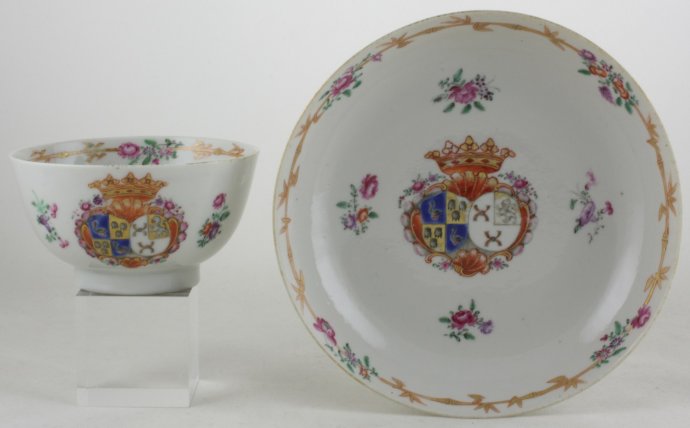
Sold Ceramics - Sold Chine de commande - Armorial / Pseudo-Armorial wares 1700-1800 - Armorial - Dutch - Page 1
Object 2012202
Teacup and saucer
China
c.1775-1780
Provenance: Suchow & Seigel, New York City, Fine Antiques est.1968.
Height of teacup 49 mm (1.93 inch), diameter of rim 88 mm (3.46 inch), diameter of footring 42 mm (1.65 inch), weight 72 grams (2.54 ounce (oz.))
Height of saucer 30 mm (1.18 inch), diameter of rim 140 mm (5.51 inch), diameter of footring 84 mm (3.31 inch), weight 107 grams (3.77 ounce (oz.))
Teacup and saucer on footrings, straight rims. Decorated in various overglaze enamels, iron-red, black and gold with two coats of arms accolée The shields are in a rococo style cartouche edged by scrollwork, flower festoons and shells above a gold coronet and surrounded by four flower sprays in European style. Round the rims a framework of deutsche blumen (German flowers) joined by fonds of bamboo. The teacup is decorated en suite. On the base of the saucer an oval paper dealers label that reads: Suchow & Seigel, New York City, Fine Antiques est.1968 and a crossed out old hand written collectors number / museum inventory number (201974d) in red. On the base of the teacup an oval paper dealers label that reads: Suchow & Seigel, New York City, Fine Antiques est.1968 and a crossed out old hand written collectors number / museum inventory number (201974-9L) in red.
Decorated with two coats of arms accolée. The dexter side is quarterly, 1. and 4. on a blue background a silver swan; 2. and 3. on a gold background three black cauldrons (two-one) on a gold background three cauldrons (two-one). The arms at the sinister side have two gold millrinds, in a quarter on a gold background a walking lion.
The dexster arms are those of Van de Leur, borne by an ancestor of the Krayenhoff van de Leur line, Anna Jacoba van de Leur (1747-1785), as shown on her tomb in Ceylon. She married in 1769 Cornelius Dionysius Krayenhoff (1744-1792) who was a senior merchant and director of Galle and Mature, Ceylon. The armorial quarters of Dick Arnold Krayenhoff van de Leur are those of Krayenhoff van de Leur - Loke, Krayenhoff van de Leur - Kolff, Loke - Muntz and Krayenhoff - Van de Leur.
However the sinister arms remain unidentified as none of those family arms resemble the millrinds and lion quarter which were, however, borne by at least six armigerous families, all from the province of North Brabant; Gommaerts or Gommers, Van der Hoeven (Heusden and Vrijhoeve, 18th century), Coenen, Nolleken, (Rover) van der Poorten and De Rode, the latter four in 's-Hertogenbosch during the 15th century.
The Van de Leur family is also from Brabant descending from Philippus van de Leur who was a wine merchant in Bergen op Zoom in the early 18th century. His son was appointed schout or bailiff of villages and small towns in western Brabant and Zeeland, such as Oude Tonge, Prinsenland and Willemstad. Philippus' son, Jacob van de Leur (born 1717), a bailiff and dike reeve of Willemstad (1749) was the father of Anna Jacoba who married into the Krayenhoff family. (Kroes 2007, p.523)
Kroes states that a (Chinese?) porcelain service with two coats of arms accolée was, in 1927, in the collection of Dirk Arnold Krayenhoff van de Leur (1855-1939) in the Dutch city Haarlem.
Only six services (1.3%) were decorated with bamboo borders for the Dutch market. The main design was a bamboo band with entwined flowers, fruits and leaves, in several cases with spearhead, small flowers and later line decoration. Most are polychrome enamels. Bamboo is the last style with predominant Chinese features, being fashionable in the 1750s. Some services were also made in the 1760s and again in the 1780s. (Kroes 2007, p.27)
Condition teacup: Perfect.
Condition saucer: Perfect with slight wear to the golden decoration.
Reference:
Price: Sold.

Sold Ceramics - Sold Chine de commande - Armorial / Pseudo-Armorial wares 1700-1800 - Armorial - Dutch - Page 1
Object 2011983
Teacup
China
c.1778
Height 45 mm (1.77 inch), diameter of rim 77 mm (3.03 inch), diameter of footring 35 mm (1.38 inch), weight 53 grams (1.87 ounce (oz.))
Teacup on a footring with a straight rim. Polychrome decorated in various overglaze enamels with two coats of arms accollé standing on a cloud flanked by a ship’s mast with the Dutch flag (colours reversed), an anchor, measuring instruments, a map and writing implements. Inscribed on the banderol below: 17 P:SIX C:COR:ANDRIESSEN 78. On the sides four single ‘German’ flowers, round the inner rim a saw-tooth border.
Maritime and naval emblems and instruments were popular among the Dutch (VOC) mariners who commissioned armorial porcelain. Several of them had one or more ships with the Dutch tricolour, a chart, anchor, measurement stick, sextant and so on painted along with their arms. Services inscribed with a date are an interesting category of armorial porcelain and there are at least 27. Armorial porcelain with dates was made during the whole of the 18th century, the first one was De Vassy dated 1702 and the last Arkenbout inscribed with the year 1792. (Kroes 2007, p. 64/65 & p. 69)
The arms are those of the Dutch Six and Andriessen families, both of Middelburg. After Amsterdam Middelburg was the second most important VOC Chamber. The Heeren XVII alternately gathered in both cities, after six years in Amsterdam they met for two years in Middelburg.
This service was made for Pieter Six (died 1784) and his wife Christina Cornelia Andriessen (c.1754-1834). It was presumably made soon after their marriage in 1778, probably in 1779 when Pieter Six was in the East Indies himself for the fourth time in the service of the VOC. He died on his fifth voyage to the East Indies, while he was master of the East Indiaman Ouwerkerk, four days before the ship arrived at Batavia. Though a family connection with the well-known noble Six family of Amsterdam is likely, this has not been established yet. Pieter Six’s wife Christina Cornelia Andriessen belonged to a family of Flemish origin, from about 1670 living in Middelburg. Several of them were minister of the Dutch Reformed Church and alderman.
A cup and saucer with an identical armorial design can be found in the collection of the Rijksmuseum Amsterdam, please see: http://hdl.handle.net/10934/RM0001.COLLECT.4167.
It was part of the bequest of J.G.A.N De Vries (1853-1925). He was a well-to-do individual who, in addition to collecting Chinese and European porcelain of the 18th century, had devoted himself in particular to amassing Chinese porcelain with coats of arms and other decorations after Western prints. The well-known Dutch heraldic expert R.T. Muschart (1873-1955) provided him with identifications of the coats of arms and also used the data from the porcelain for his own research. Nearly all the Dutch armorial porcelain in the Rijksmuseum’s collection was part of the De Vries bequest. He was also author of one of the earliest publications on Chinese porcelain in the Netherlands. (Vries 1923)
Kroes clearly states that the Six-Andriessen cup and saucer in the Rijksmuseum are the only documented pieces of a tea service so far. This chocolate cup can therefore be considered very rare.
For the identically decorated cup and saucer, please see:
- Chinese Ceramics in the Collection of the Rijksmuseum Amsterdam, The Ming and Qing Dynasties, (C.J.A. Jörg in collaboration with J. van Campen, Philip Wilson in association with The Rijksmuseum Amsterdam, London 1997), p.313, cat. 372.
- Chinese Armorial Porcelain for the Dutch Market, Chinese Porcelain with Coats of Arms of Dutch Families, (J. Kroes, Waanders Publishers, Zwolle, 2007), pp.435-436, cat. 357.
Condition: Wear to the decoration, two fleabites, two (restored) frits and two hairlines to the rim. A shallow frit to the footring.
References:
Jörg & Van Campen 1997, p.18, cat. 215 & cat. 372
Kroes 2007, pp.64-65, 69, 435-436, 613, cat. no. 357
http://hdl.handle.net/10934/RM0001.COLLECT.4167
Price: Sold.
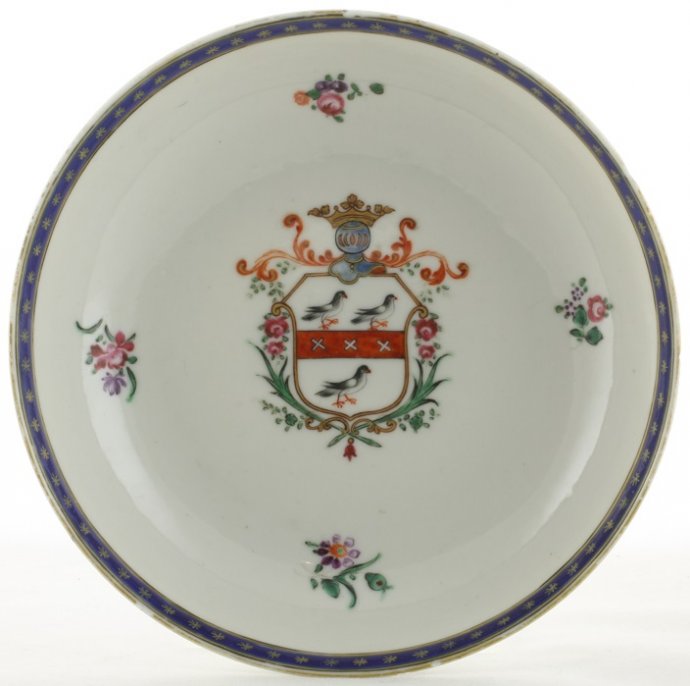
Sold Ceramics - Sold Chine de commande - Armorial / Pseudo-Armorial wares 1700-1800 - Armorial - Dutch - Page 1
Objects 2011546
Saucer
China
1790-1795
Height 33 mm (1.49 inch), diameter of rim 142 mm (5.51 inch), diameter of footring 85 mm (2.95 inch), weight 130 grams (4.59 ounce (oz.))
Saucer on footring, straight rim. Decorated in various overglaze enamels, iron red, black and gold with a coat of arms, on the sides four flower sprays and on the rim a border with astrixes in gold on a blue enamel ground. The reverse is undecorated.
These coat of arms: on a white background a red bar charged with three white (silver) saltires, with three birds looking to the sinister, although with the birds looking at the opposite direction, were borne by two Dutch families, Verlouw and Froon. Both from Schiedam (the Netherlands). On the sides four groups of flowering branches and on the rim a blue border with stars in gold. Jan Verlouw (1749-1805) the eldest son of Daniël Verlou(w) (1724-1789?) and Maggeltie Helloe (Hellu) (1724-) seems most likely to have commissioned this armorial porcelain made in the early 1790s. Jan Verlouw was a councillor and alderman of the city of Schiedam. He married twice, first on 6 November 1771 Agata van Essen (1747-1784) and secondly, on 5 August 1788 Catharina van Holst (1753-1802. He outlived them both. His first wife gave birth to five children and his second wife had one daughter. Two daughters and two sons grew up to maturity. His eldest son Hendricus Verlouw (1774-1800) was a town physician of Schiedam. His youngest son, Daniël Verlouw (1779-1856) who married his older brothers widow became councillor and alderman of Schiedam. After the death of Daniël's youngest son, Jean Philippe (1809-1872), this branch became extinct in 1872. (Kroes 2007, pp.498-499)
Only a 13-piece tea service with this armorial design is known comprising of a rectangular tea caddy; a six-lobed teapot stand; a slop bowl; two coffee cups with moulded and s-shaped handle; two tea cups; five saucers (identical to the saucer offered) and one larger saucer. Additionally one tea bowl appeared on the English market in the early 21st century.
For an identically decorated saucer, please see:
Condition: Three tiny frits, two small and shallow chips and a short hairline to the rim.
Reference:
Price: Sold.
Sold Armorial - British

Sold Ceramics - Sold Chine de commande - Armorial / Pseudo-Armorial wares 1700-1800 - Armorial - British - Page 1
Object 2012224
Cup
China
c.1720
Height 62 mm (2.44 inch), diameter of rim 57 mm (2.24 inch), diameter of footring 26 mm (1.02 inch), weight 90 grams (3.17 ounce (oz.))
Cup with handle on footring. Decorated in iron-red, blue, purple and (unusual) lime green enamels and gold with the arms and crest of Sir John Lambert, Bt., the reverse with a basket with ribbons and tassels filled with finger-lemon fruit also called 'Buddha's-hand citron (Citrus medica), divided by a flywhisk and ruyi sceptre (Daoist symbols) amongst flowers prays. Round the foot and inner rim a spiked palings border and on the outer rim a foliage border. On the base an old rectangular paper label.
The arms are those of Sir John Lambert, created a baronet in 1711. One of the twenty-eight directors of the South Sea Company, founded the same year, Lambert became wealthy by his unscrupulous handling of the company's affairs. He was involved in the selling of fictitious stock, bribing royal mistresses with shares at favourable rates, and juggling the books. His name also occurs in Dutch accounts as agent for speculators in Amsterdam. Lambert tried to cash in on the bubble mania by proposing a company of his own, a whale fishery in Greenland but this was in July 1720: the South Sea Bubble was about to burst, and his petition was refused. The directors were held responsible for the collapse, and after a public inquiry their estates were confiscated. Of this newly acquired wealth valued at 72,508 GPB, Lambert lost all but 5,000 GBP. He died in February 1723. (Corbeiller 1974, p.46)
The service to which the octagonal dish in China Trade Porcelain: Patterns of Exchange, (C. le Corbeiller, The Metropolitan Museum of Art, New York 1974), pp.46-47, cat. 20 belongs is typical of the armorial wares made for the English and French markets between about 1720 and 1730. The decoration at this comparatively early stage of the porcelain trade was still essentially Oriental, the European armorials in no way interfering with the traditional K'ang Hsi arrangement of borders and symbols. The Lambert service, which must date before 1723 and was probably ordered at the height of Sir John's financial success or about 1720, appears to be the earliest of this type. All comparable and datable services fall within the ensuing decade. Although the decorative style of export porcelains showed little Western influence at this period, the shapes of individual pieces were generally copied from contemporary examples in silver; the moulding on the rim of the octagonal dish (cat.20) offers further confirmation of this point, as does the inclusion in the Lambert service of a tazza, one of the few known to exist in China trade porcelain. (Corbeiller 1974, p.46)
This cup proves, that besides the Lambert armorial service, Sir John Lambert, Bt. must also have ordered an armorial tea / coffee service, no other object from this tea / coffee service seems to be recorded at this time.
For other objects decorated arms, crest and motto of Sir John Lambert, Bt., please see:
- Chinese Armorial Porcelain. (D.S. Howard, Faber & Faber Ltd, London, 1974), p.206, no. D2
- China Trade Porcelain: Patterns of Exchange, (C. le Corbeiller, The Metropolitan Museum of Art, New York 1974', pp.46-47, cat. 20.
- Important Chinese Export Porcelain and Chinese works of art from the Collection of the late Mildred R. and Rafi Y. Mottahedeh, auction sale catalogue 7520, Sotheby's New York, October 19, 2000, pp.124-125, lot number 279.
- The Bullivant Collection of Armorial Porcelain. Offered by direction of the Executors of the late Cecil H. Bullivant, auction catalogue Phillips London, 22 March 1988, pp.22-23, cat. 82 & 87.
Condition: Perfect.
References:
Price: Sold.

Sold Ceramics - Sold Chine de commande - Armorial / Pseudo-Armorial wares 1700-1800 - Armorial - British - Page 1
Object 2012215
Saucer
China
c.1740
Height 16 mm (0.63 inch), diameter of rim 116 mm (4.57 inch), diameter of footring 68 mm (2.68 inch), weight 52 grams (1.83 ounce (oz.))
Saucer on footring, slightly everted rim. Decorated in various overglaze enamels and gold with the arms of Gore, Gules a fess between three crosses crosslet fitched or, impaling Azure three roach (?) argent in pale, possibly for Roach, quartering Herris (?) of Woodham Mortimer in Essex, Or on a bend gules three cinquefoils of the field. At the cavetto a spearhead border and round the rim a foliate and floral scroll border. The reverse is undecorated. (Howard 1974, p.286, cat. G1)
Gerard Gore was an Alderman of the city of London who died at the age of ninety-one in 1607 leaving a number of sons. From these descended the Earls of Arran created in 1762, the family of Ormsby Gore, Barons Harlech, the baronetcy of Gore-Booth, descended from Sir Booth Gore of Co. Sligro, created in 1760 and the baronetcy of Gore created in 1622 and a number of other families. It seems possible that the impaled coat is for the Irish family of Roche but the marriage is not known. A simlar decorated saucer dish is in the Clive Rouse Collection. (Howard 1974, p.286, cat. G1)
A special group within Chine de commande is armorial porcelain, that is pieces decorated with the coats of arms of the men who ordered them. Identification of the arms is not always easy. Either they are not known or the Chinese porcelain painter may not have used the correct colours. Coloured prints, book-plates or drawings were used as models. Even if the arms can be identified, it may not be known which member of the family placed the order. Pieces with two coats of arms, which were usually ordered as wedding gifts or for wedding anniversaries, pose a particular problem if one of the arms cannot be identified. On the other hand, when they are known, they allow dating within a fairly short period. (Jörg & Van Campen 1997, pp.299-300)
Condition: A few tiny frits to the rim.
References:
Jörg & Van Campen 1997, pp.299-300
Price: Sold.
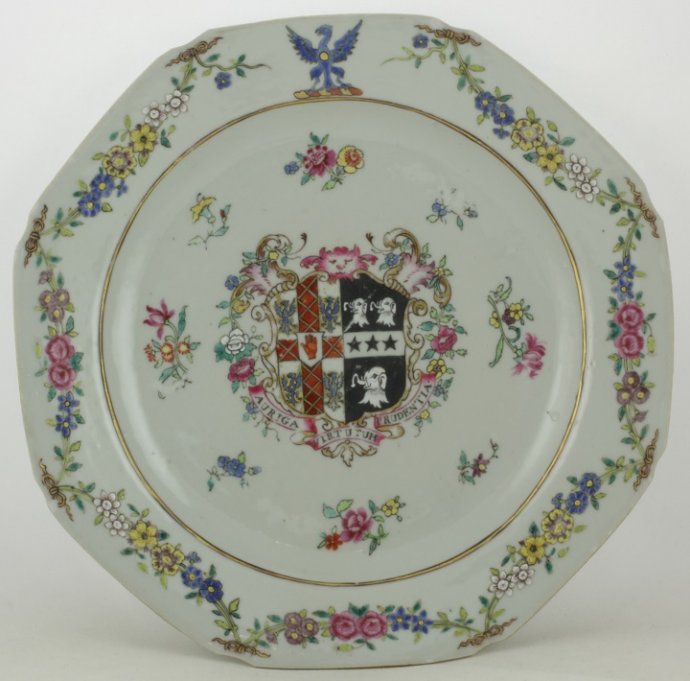
Sold Ceramics - Sold Chine de commande - Armorial / Pseudo-Armorial wares 1700-1800 - Armorial - British - Page 1
Object 2011908
Dish
China
c.1760
Height 27 mm (1.06 inch), diameter of rim 234 mm (9.21 inch), diameter of footring 137 mm (5.39 inch), weight 377 grams (13.30 ounce (oz.))
Octagonal dish on footring, flat rim with indented corners. Polychrome decorated in various overglaze enamels and gold with a coat of arms surrounded by scattered flower sprays. On the rim flower festoons tied with bows. At the top an eagle displayed. The reverse is undecorated.
The arms are those of Mawbey impaling Pratt. Underneath the arms scrolls with the motto: “auriga, virtutum, prudentia.” On the rim at the top the family crest, an eagle displayed.
Joseph Mawbey was born on 2 December 1730, the fourth son and youngest child of John Mawbey and his first wife Martha Pratt. When he was about ten years old he was taken to Surrey by his uncle, Joseph Pratt, main owner of a distillery at Vauxhall. Mawbey entered the business at the age of 17, and carried it on for many years with his brother John. On his uncle's death in 1754, Mawbey inherited property in Surrey and established himself as a landed proprietor. He became the High Sheriff of Surrey in 1757 and later on was an MP for many years.
In August 1760 Joseph Mawbey married Elizabeth, only surviving daughter of his cousin, Richard Pratt of Vauxhall. He bought the estate of Botleys in Chertsey, Surrey in 1763. Mawbey built a large house designed by Kenton Couse, who was remodelling 10 Downing Street at the same time.
Botleys Mansion, Chertsey, Surrey, UK (source: martinskikulis.com)
Mewbey was created a baronet on the 30th of July 1765. His wife Elizabeth died at Botleys, 19 August 1790, having had nine children, four of whom were then alive. Mawbey died at Botleys, 16 June 1798, and was buried in the family vault in the chancel of Chertsey Church, where his wife and several of his children had preceded him. (source: wikipedia.org)
Engraving of Sir Joseph Mawbey, the elder, 1st Baronet (1730 - 1798)
Memorial tablet of Sir Joseph Mawbey in St Peter's Church, Chertsey
This dish was once part of a dinner service ordered around 1760 by Sir Joseph Mawbey, first Baronet of Botleys, probably on the occasion of his marriage to Elizabeth Pratt. (Goldsmith Phillips 1956, p.93)
For an identical dish, please see:
David Howard describes another armorial service with the arms of Mawbey impaling Pratt, a very similar decorated underglaze blue service, dated slightly later (c.1770), of which he illustrates a mug. (Howard 2003, p. 592)
A milk jug with the arms of Mawbey impaling Pratt was in the collection of the famous collector Frederick Arthur Crisp, please see this auction catalogue from his collection in 1923, lot 233.
For similar milk jugs also decorated with the arms of Mawbey impaling Pratt, please see:
- China Trade Porcelain, (J. Goldsmith Phillips, Harvard University Press, Cambridge, Massachusetts 1956), p.107, plate 34 (right).
- Christies New York, 25th of January 2011, sale 2404, lot 201
Condition: Wear to the gilding of the arms and some wear to the enamels. A chip and some tiny frits and fleabites to the footring and rim. An X-shaped hairline to the base.
References:
Goldsmith Phillips 1956, p.93 & p.107 plate 34 (right)
Howard 2003, p.592 & p.614, plate top left
Price: Sold.
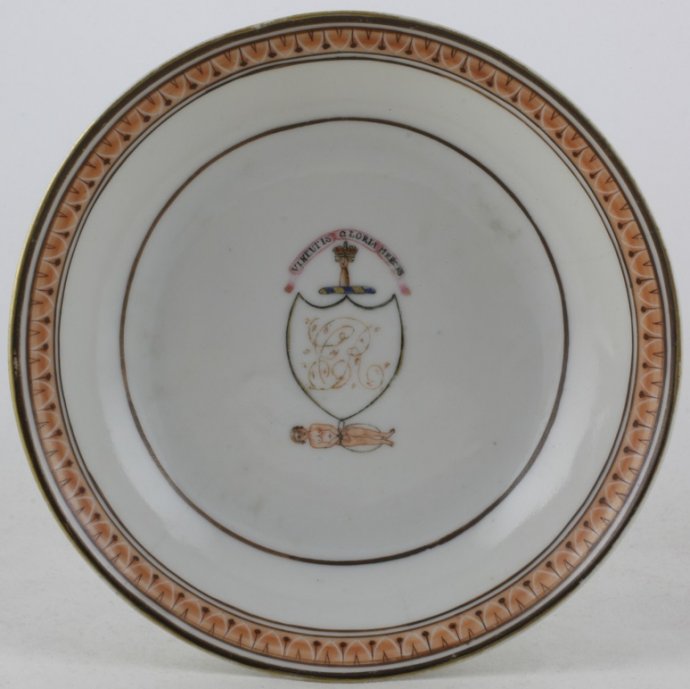
Sold Ceramics - Sold Chine de commande - Armorial / Pseudo-Armorial wares 1700-1800 - Armorial - British - Page 1
Object 2012142
Saucer
China
c.1800
Height 28 mm (1.10 inch), diameter of rim 128 mm (5.04 inch), diameter of footring 75 mm (2.95 inch), weight 81 grams (2.86 ounce (oz.))
Saucer on footring, straight rim. Decorated in various overglaze enamels and gold with the crest and moto of Robertson, A dexterhand erect holding in the hand an imperial crown all proper, with the motto 'Virtutis Gloria merces' (Glory is the reward of valour). Beneath the shield, on which are the initials C.R., the figure of a wild man in chains proper. Round the rim an ornamental border. The reverse is undecorated.
This service is one of a number made for the family of Robertson of Struan (which family bore on a compartment beneath their arms a wild man in chains commemorating the capture of the murderer of King James I of Scotland in 1437 by the 4th Chief of the Clan. Four earlier services are illustrated in this volume (F4, V8, V14 and V17) which give detail of the family in the second half of the 18th Century, but although there is more than one Charles Robertson in earlier generations, and younger sons are mentioned in published records, there is no obvious owner of this service. The border design is, however, exactly as the Hon. East India Company service (Volume I, W12) which was delivered to the Governors of all the principal East India Stations in India at this time, and it would seem quite possible that the service was carried by Captain Thomas Robertson who commanded East Indiamen at Canton in 1797, 1800 and 1802 (although his crest is not recorded. (Howard 2003, p.656)
For a small cup/mug from the same service, please see:
The Robertsons claim to be descended from Crinan, Lord of Atholl, from whom sprang the royal house of Duncan I, the King of the Scots. The Robertson clan is more properly called ‘Clan Donnachaidh’ from their ancestor Duncan, who was a staunch supporter of Robert the Bruce, and who led the Clan at the Battle of Bannockburn.
The general surname of the clan Robertson was taken from Robert Riach (Grizzled Robert) the clan chief, who was known for his intense loyalty to the Stewarts. Riach was responsible for capturing the murderers of King James I and was rewarded by the crown for this act by having his lands at Struan erected into a Barony.
Robert Riach (source: www.scotclans.com)
The clan was also granted a symbolic memorial by additions to their coat of arms – subsequently the chief of clan Robertson bore as his crest a hand holding an imperial royal crown, and underneath a man in chains, representing the regicide. About a century later, the Robertson family lost the lands of Struan to the Earl of Atholl but the family regained them in 1606.
However, in the seventeenth century, after the final defeat of James VII, all Robertson estates were forfeited, and the chief of the Robertson clan joined the exiled court in France. To this day the chiefs of the clan Robertson still have the right and privilege of interment in the family burial ground at Struan. (Source: www.scotclans.com)
For more information on the Clan Robertson (Clan Donnachaidh), please click here.
Condition: Three hairlines to the rim.
References:
Price: Sold.
Sold Pseudo-Armorial

Sold Ceramics - Sold Chine de commande - Armorial / Pseudo-Armorial wares 1700-1800 - Pseudo-Armorial - Page 1
Object 2010367
Chocolate beaker and saucer
China
c.1720-1740
Height of beaker 73 mm (2.87 inch), diameter of mouthrim 79 mm (3.11 inch), diameter of footring 37 mm (1.46 inch)
Height of saucer 24 mm (0.95 inch), diameter of rim 139 mm (5.47 inch), diameter of footring 75 mm (2.95 inch)
Chocolate beaker and saucer on footrings with straight rims (original cover is missing). Chinese Imari, decorated in underglaze blue, iron-red and gold. In the centre of the saucer a roundel filled with a single flower spray on the sides and rim flowering peonies alternating with double headed eagles. The beaker is decorated en suite.
In 1565, the Philippine Islands were conquered by an expedition that included six Spanish Augustinian friars under the supervision of Father Andres de Urdaneta, who established several missions in the Archipelago. According to Augustinian sources, after the discovery of the Holy Child of Cebu (an image thought to be miraculous), King Philip II of Spain (1556-98), granted the privilege to the Augustinians of the Phlippine Islands to make use of his ensign, the double headed eagle from the Hapsburg in their emblem. (Welsh 2003, p.18)
The double headed eagle is the emblem of the Spanish Catholic Order of St. Augustine and it is very likely that this set was ordered by the Augustinian Fathers.
An article in The Oriental Ceramic Society of the Philippine, June 2007 on The Pacific route of Ceramic trade: the Commercial Flow of Oriental Ceramics between Asia and Latin America by Etsuko Miyata and Risuko Yajima, focusses on their findings of the study about Chinese ceramics traded through galleons via Manila to the New World (Mexico) in the 16th-19th centuries. The research was conduted in Zócalo area, Mexico City in 2006. The excavated pieces dated from the late Jiajing period (1522-1566) to the 18th century. Amongst the 18th century objects excavated was a sherd of an overglaze bowl (read beaker) with a double headed-eagle drawn on the exterior wall. Special orders with emblems by the Portuguese Kings, nobles, and religious orders are known from the 15th century, some of which can be seen among the Portuguese collection today. This emblem probably depicts that of Hapsburg (1510-1700) or the Augustinian order, though in any case, it dates back to the early 18th century at the latest. (The Oriental Ceramic Society of the Philippines, June 2007)
For other objects decorated with the double headed eagle emblem of the Spanish Catholic Order of St. Augustine, please see:
- Chinese export porcelain in North America, (J. McClure Mudge, Riverside Book Company, Inc., New York, 2000), p.47, cat. 50 & 52.
- Imagens do Cristianismo na Porcelena da China / Christian Images in Chinese Porcelain (J. Welsh, T. Canepa, Jorge Welsh Books, London/Lisbon 2003), pp.18-19, cat. 1.
- SKD Online collection.
Cocoa was first brought to Europe by the Spaniards from Mexico in the 1st half of the 16th century. From Spain the cocoa beans were traded to Italy and The Netherlands, First used as a medicine, later at the end of the 17th century it was consumed as a pleasure drink. (Jörg & Van Campen 1997, p.116) In 1722 Father d'Entrecolles already mentioned, high chocolate cups/beakers, in his letters.
From the archives of the Dutch East India Company (VOC), we know that the ordered cups/beakers had to have straight vertical walls without a flattened rim, the cup/beaker had to be 70 mm high (2.76 inch).
Condition
Beaker: Perfect.
Saucer: A firing flaw and three fleabites to the rim.
References:
Jörg & Van Campen 1997, cat. 117
The Oriental Ceramic Society of the Philippines, June 2007
Price: Sold.
(not illustrated objects 2010556, another identically deorated chocolate beaker and saucer)
More pictures of object 2011365B, another identically, shaped, sized and decorated, sold, saucer >>
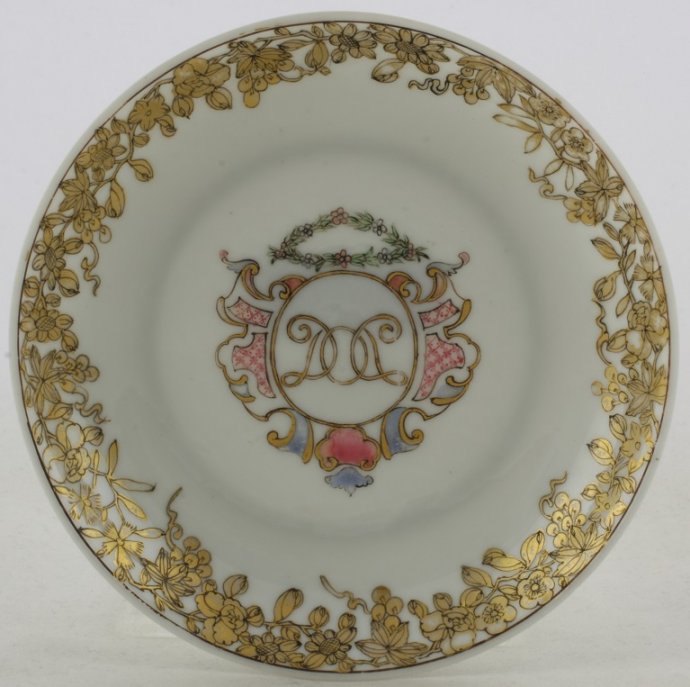
Sold Ceramics - Sold Chine de commande - Armorial / Pseudo-Armorial wares 1700-1800 - Pseudo-Armorial - Page 1
Object 2011202
Saucer
China
c.1740
Height 21 mm (0.82 inch), diameter of rim 116 mm (4.57 inch), diameter of footring 68 mm (2.68 inch), weight 43 grams (1.52 ounce (oz.))
Saucer on footring, slightly everted rim. Decorated in various overglaze enamels and gold with a roundel enclosing the mirror monogram of possible the 'DOC' the Danske Ostindke Company within a rocaille mantling and below a flower wreath, the rim with a border of vine and flowers. The reverse is undecorated.
Much Chinese export porcelain made for the Dutch market has a pseudo-armorial character, the most notable and largest group being monogrammed porcelain. Monograms are initials, often finely painted in the shape of a mirror monogram or cipher. A mirror monogram is a design of a monogram where the letters are reversed to make mirror images to produce an ornamental form. The word cipher is more or less synonymous with mirror monogram the with the emphasis on encrypting text with a combination of symbolic letters in an entwined weaving of letters.
Monograms and ciphers are mainly personal as opposed to coats of arms that beside by individuals can also be borne by whole families and communities. Pseudo-armorials are those emblems and signs which only resemble a coat of arm by using heraldic components such as a shield shape and/or banners, spears, flying angels etc. that surround the monogram or cipher. (Kroes 2007, p.56)
For an identically shaped, sized and decorated teacup and saucer, please see:
The mirror monogram on this saucer is interesting, similar monograms can be found on Danish coins (Kronet) from 1699-1730 made during the reign of the Danish/Norwegian King Frederick IV (1671-1730). In the Christie's Amsterdam auction sale catalogue 14-16 February 2016, the monogram on the Buisman teacup and saucer (lot 1096) is described as 'DOD'. The pictures of the Danish coins (Kronet) can be found on danskmoent.dk. On this website the author states that the very similar monograms 'DOC' on these coins (Kronet) are the monogram of the Danske Ostindke Company.
'DOC' monogram of the Danske Ostindke Company.
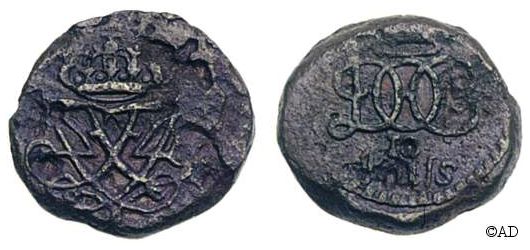
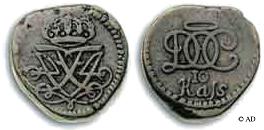
Forside: Kronet double F4 monogram
Bagside: Kronet DOC monogram; 10 Kas under DOC
I 1729 gik det Danske Ostindiske Company bankerot og det var slut med DOC på mønterne. Den danske konge overtog kolonien.
Pictures and text courtesy: danskmoent.dk
Condition: A tiny firing flaw to the rim.
References:
Price: Sold.
More pictures of object 2010786 another identically shaped, sized and decorated, sold, saucer >>
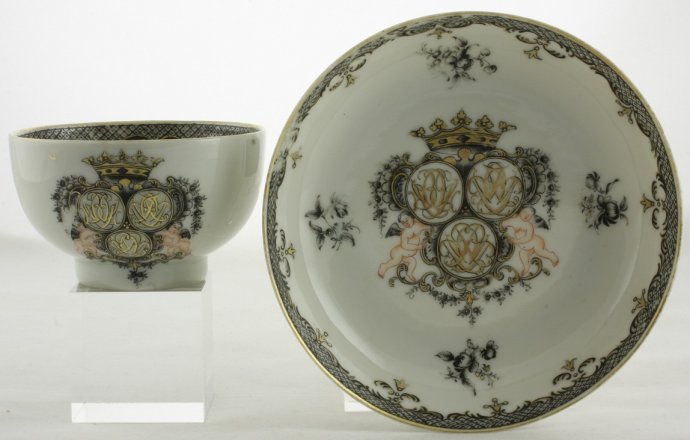
Sold Ceramics - Sold Chine de commande - Armorial / Pseudo-Armorial wares 1700-1800 - Pseudo-Armorial - Page 1
Object 2010944
Teacup and saucer
China
1740-1750
Height of teacup 47 mm (1.85 inch), diameter of rim 76 mm (2.99 inch), diameter of footring 37 mm (1.46 inch)
Height of saucer 28 mm (1.10 inch), diameter of rim 120 mm (4.72 inch), diameter of footring 76 mm (2.99 inch)
Teacup and saucer on footrings, the cup with handle. Decorated in encre de Chine, gold and a pink-gold wash with three monogrammed ovals surmounted by a coronet surrounded by European scrollwork with hanging flowers supported by two angels. In the dexter oval a cipher "J C V E" and a cipher "F V P " at the sinister side oval, underneath both ovals a third oval with the cipher "P V P". It is, until now, unknown to who these ciphers refer.
Monograms and ciphers are mainly personal as opposed to coats of arms that beside by individuals can also be borne by whole families and communities. Pseudo-armorials are those emblems and signs which only resemble a coat of arm by using heraldic components such as a shield shape and/or banners, spears, flying angels etc. that surround the monogram or cipher. Chinese export porcelain decorated with three monogrammed ovals is rare. (Kroes 2007, p.56)
Condition:
Teacup: A hairline.
Saucer: A chip and two frits to the rim.
Reference:
Price: Sold.
More pictures of object 2012532, another identically shaped, sized and decorated, sold tea bowl >>

Sold Ceramics - Sold Chine de commande - Armorial / Pseudo-Armorial wares 1700-1800 - Pseudo-Armorial - Page 1
Object 2010467
Milk jug
China
c.1760
Height with cover 115 mm (3.46 inch), diameter 69 mm (2.72 inch), diameter of mouthrim 38 mm (1.49 inch), diameter of footring 38 mm (1.49 inch)
Milk jug on footring, pear shaped body with handle, small triangular spout at the rim. The handle is placed opposite the spout. The cover is not matching but dates from the same period. Polychrome decorated in overglaze blue and pink enamel, iron-red, black and gold with a large (totally faded) pseudo Armorial "initials" design (only partial visible in "ghost form"), above a coronet held by two flying, clothed angels. On the rim a band of "Laub- und Bandelwerk" or foliage and scrollwork.
These angelic figures represent marriage and were particularly popular in Dutch Heraldry at that time, being typical for the Dutch market of Armorial porcelain.
In 1722 Père d'Entrecolles reported that the Chinese were experimenting with painting in black, so far unsuccessfully. Black or schwarzlot, decoration, was also then just being developed in Europe, and in fact the German Hausmaler was putting it primarily on Chinese imported in the white, rather than on wares from the newly established Meissen factory. It must have been these hybrids that were sent back to Canton for imitation at the time of Père d'Entrecolle's letter, but the perfection of the technique and its translation into commercial export porcelain came only later, under the direct influence of the du Paquier period (1719-1744). Unique to the du Paquier factory was the Laub- und Bandelwerk border, based on two series of engravings by Paul Decker (d.1713). Continually modified and varied its essential elements were strapwork, palmettes, trelliswork cartouches, and foliate scrolls combined into a rhythmical pattern of baroque formality. Other China trade versions of the Laub- und Bandelwerk border, such as the more usual one with the addition of peacock and with panels of quilting rather than trellis- or scale work are farther removed from their Viennese factory prototypes, and are perhaps derived from Hausmaler variants. (Corbeiller 1974, pp.68-69 )
Monograms and ciphers are mainly personal as opposed to coats of arms that beside by individuals can also be borne by whole families and communities. Pseudo-armorials are those emblems and signs which only resemble a coat of arm by using heraldic components such as a shield shape and/or banners, spears, flying angels etc. that surround the monogram or cipher. Chinese export porcelain decorated with three monogrammed ovals is rare. (Kroes 2007, p.56)
For an identically decorated dish, please see:
Condition: A hairline to the rim.
References:
Corbeiller 1974, pp.68-69, cat. 30
Price: Sold.

Dish
China
1770-1790
Height 28 mm (1.10 inch), diameter of rim 242 mm (9.53 inch), diameter of footring 136 mm (5.35 inch), weight 451 grams (15.91 ounce (oz.))
Dish on footring, flat rim with a scalloped edge. Polychrome decorated in various overglaze enamels and iron-red and gold. Initialled in the centre with flowering branches and a butterfly forming the initials 'W M J' on the sides a framework of deutsche blumen (German flowers) joined by fonds of bamboo. On the rim six cartouches filled with deutsche blumen (German flowers) on a white enamelled bianco sopra bianco diaper pattern ground. The reverse is undecorated
In the 18th century the Dutch, the British and, later on, the other European trading nations begin ordering armorial porcelains. Coats-of-arms were now ever increasingly decorated in overglaze colours in dedicated workshops stocked with wares to which a range of borders had been applied. These custom jobs cost many times more than the standard ware and were generally ordered by private traders who rented space on East India company ships. Company captains and officers were likewise inclined to garner a service with their own arms. Initialled porcelain was particularly popular in Scandinavia. (Emden 2015/1, p.108)
For a similarly decorated drinking service with the initials 'WB', please see:
Condition: Some wear to the decoration, a fleabite, two frits, two chips and a hairline to the rim.
References:
Price: Sold.


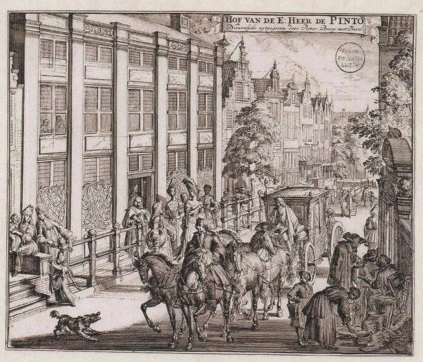
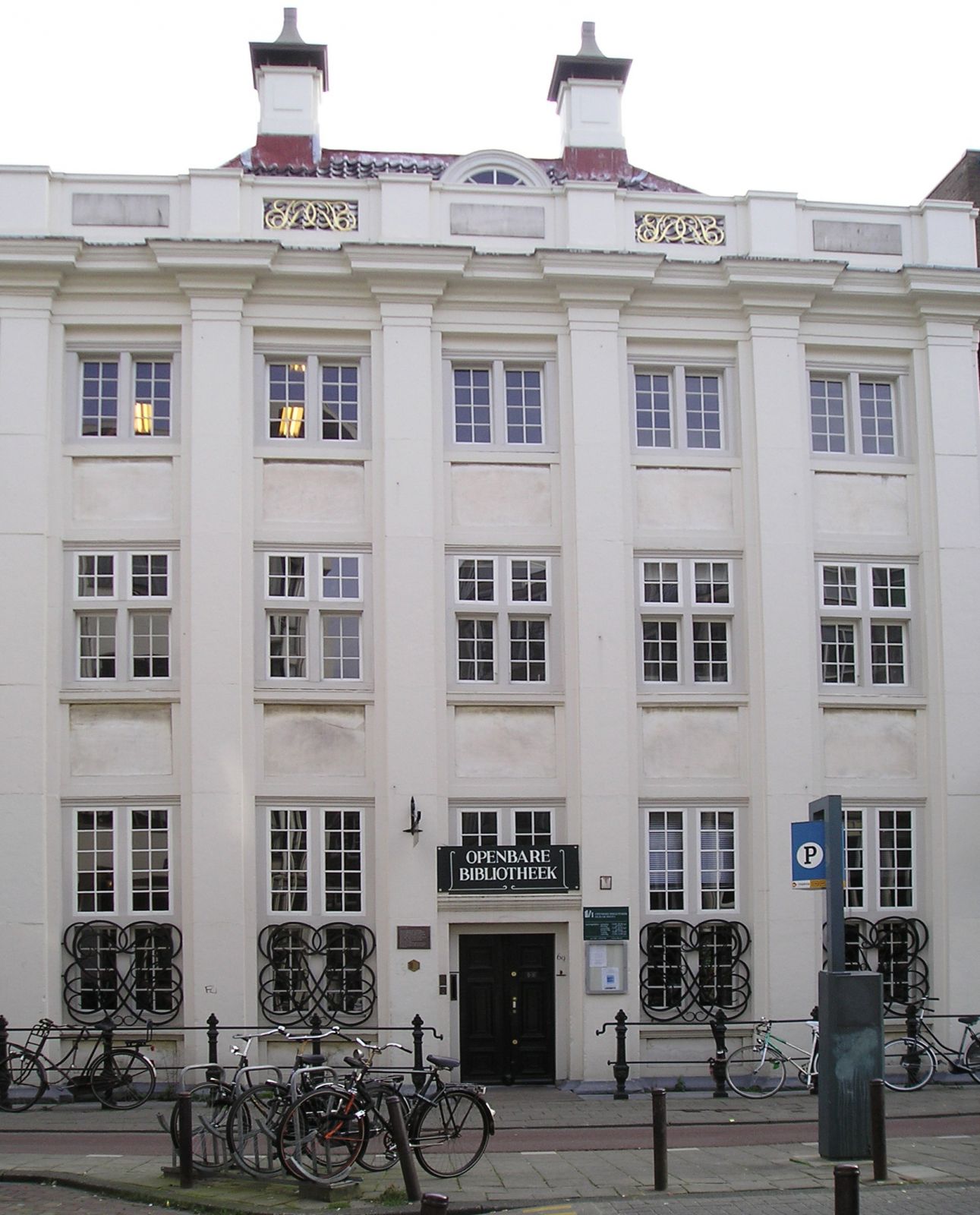

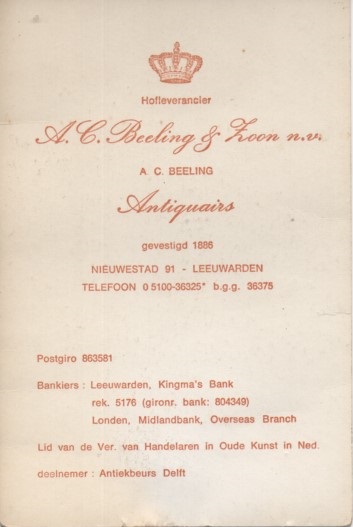
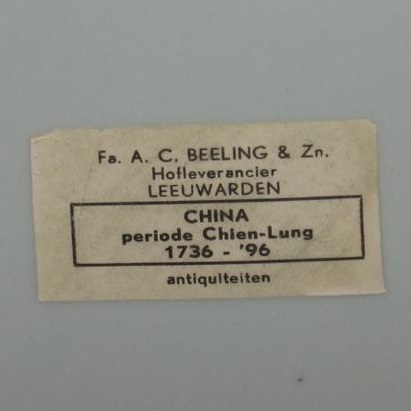
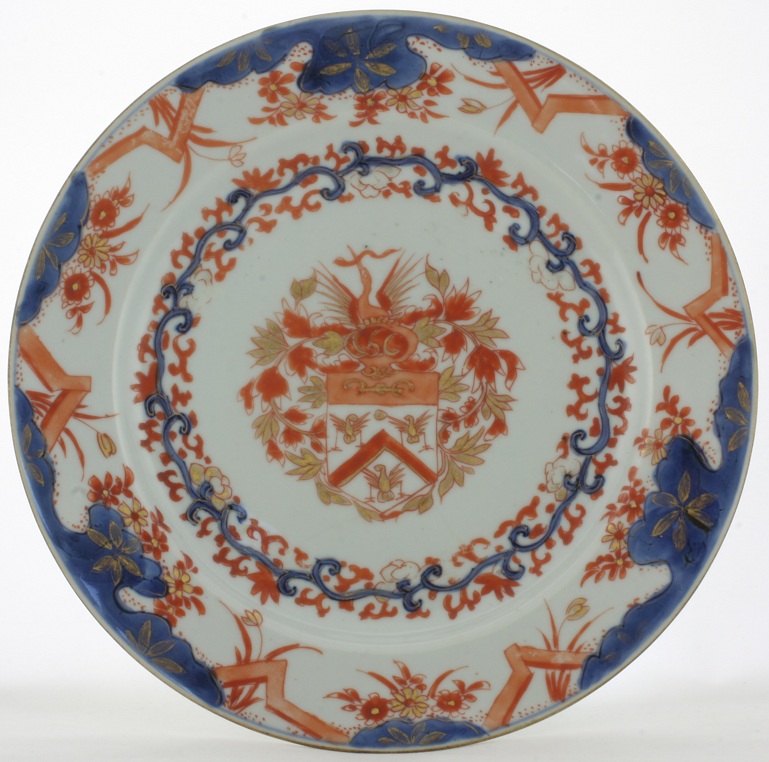
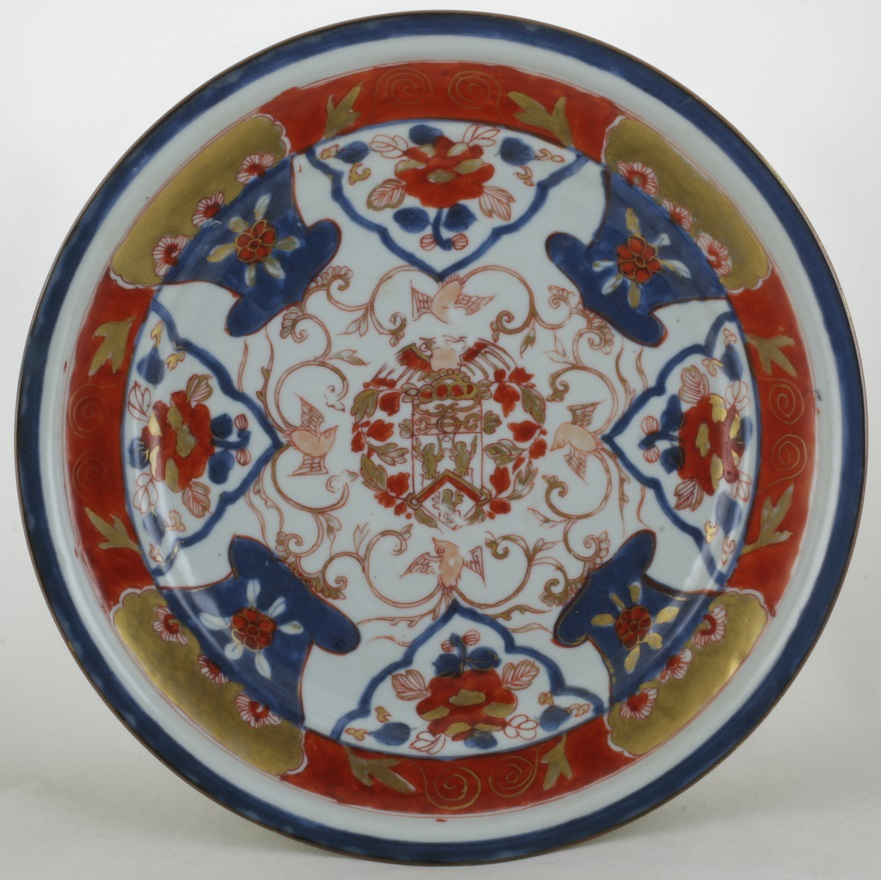
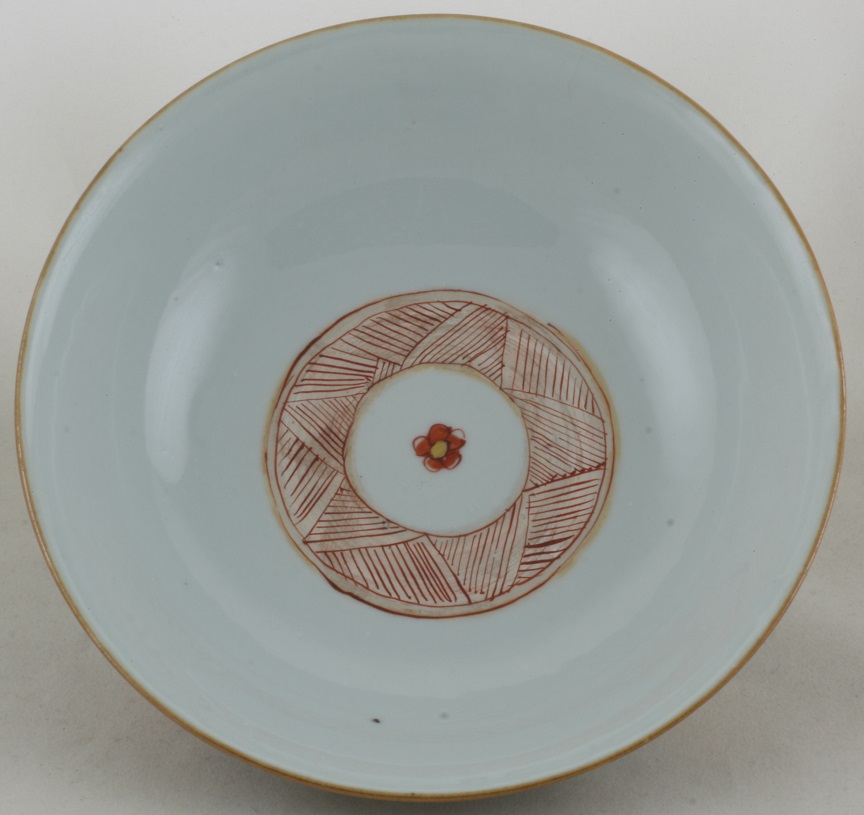
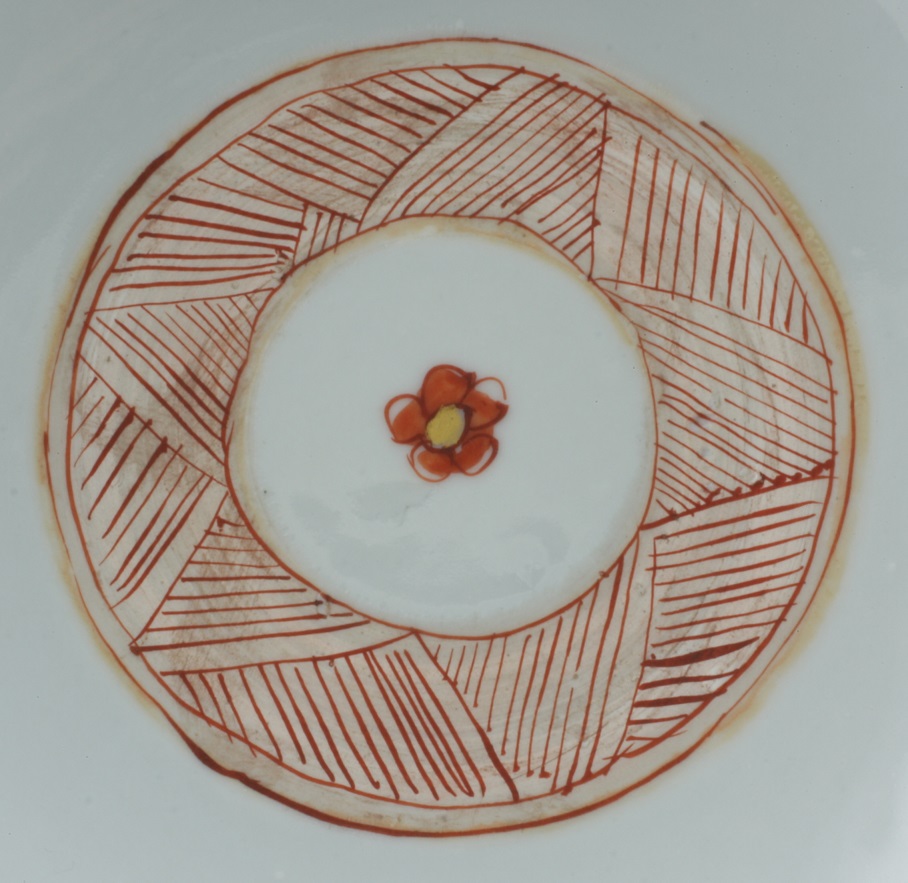
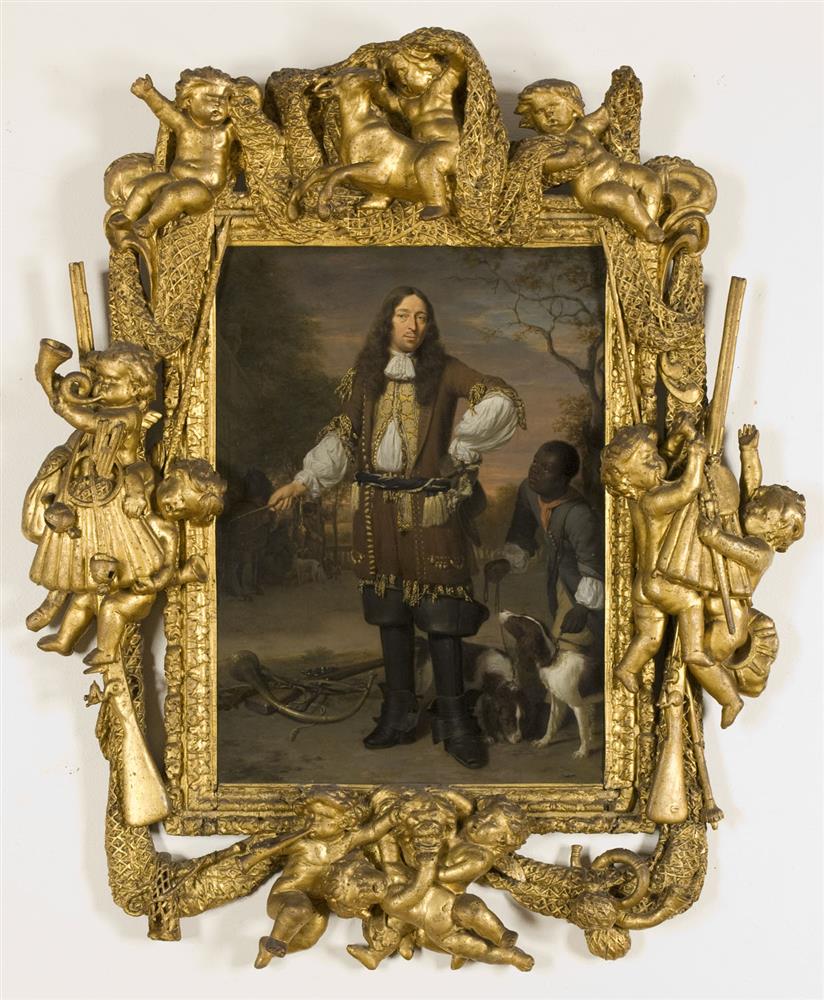
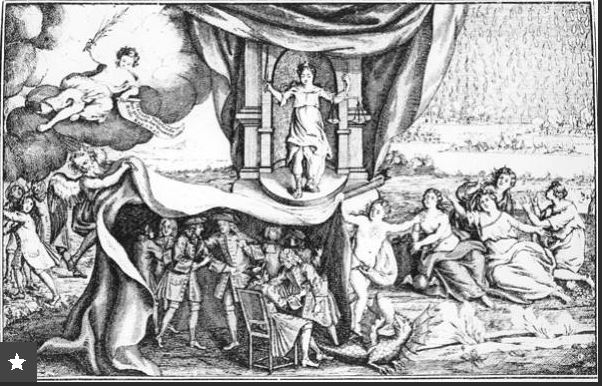
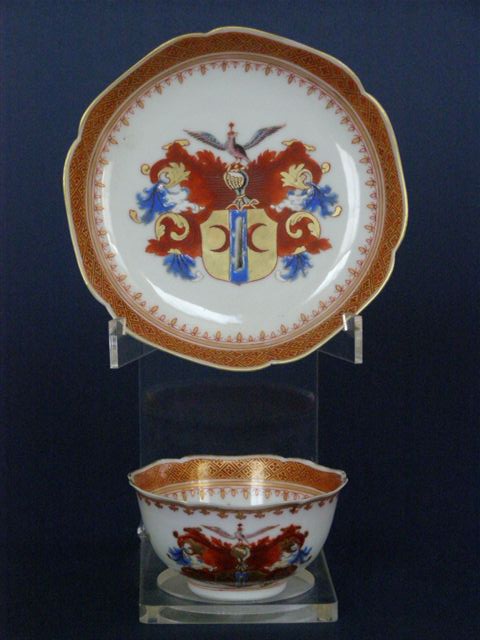
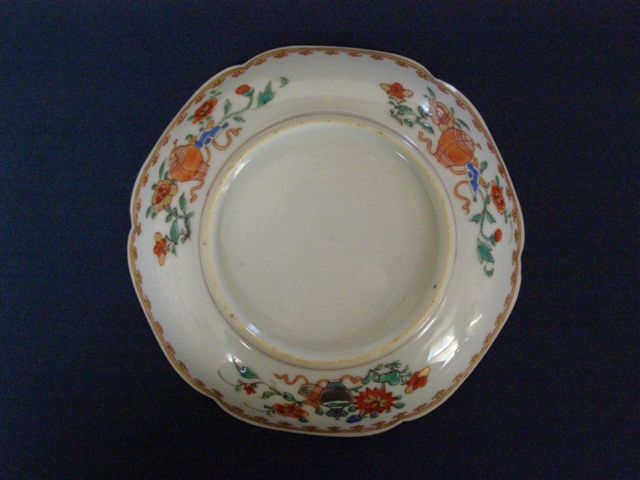







a.jpg)
a.jpg)
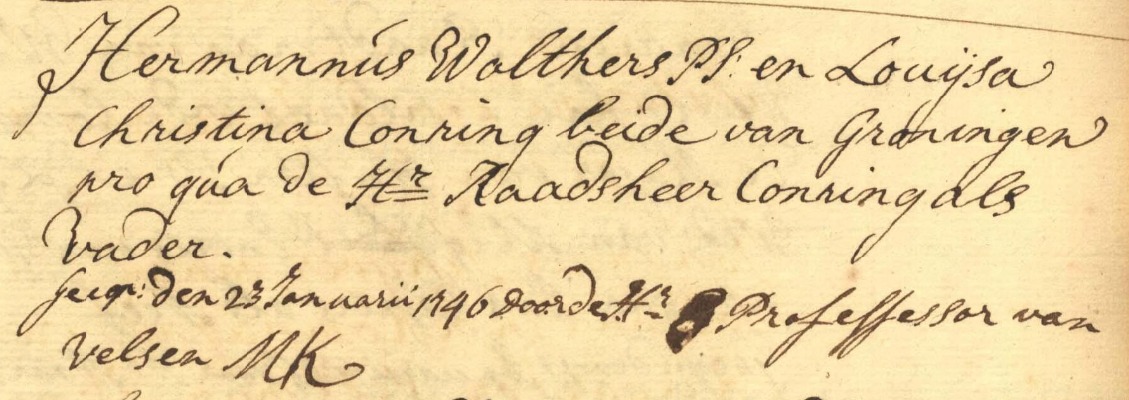
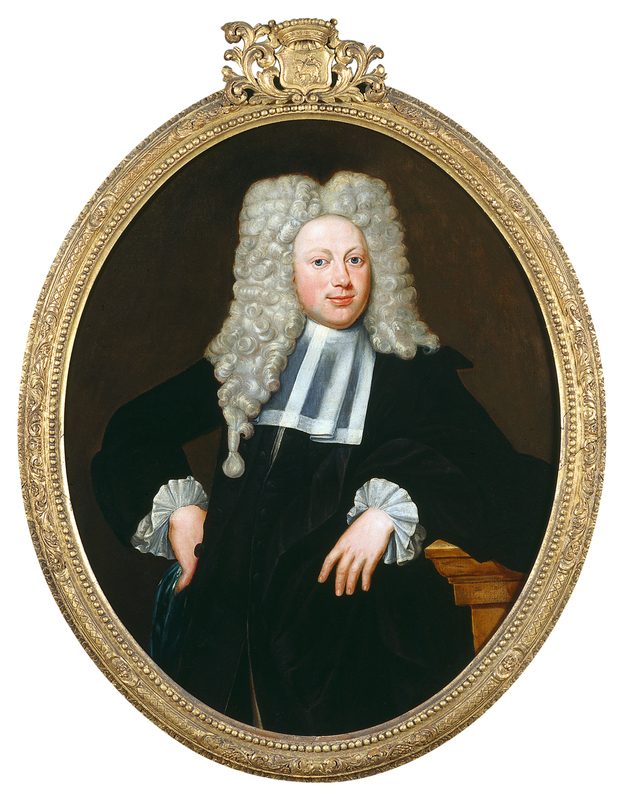
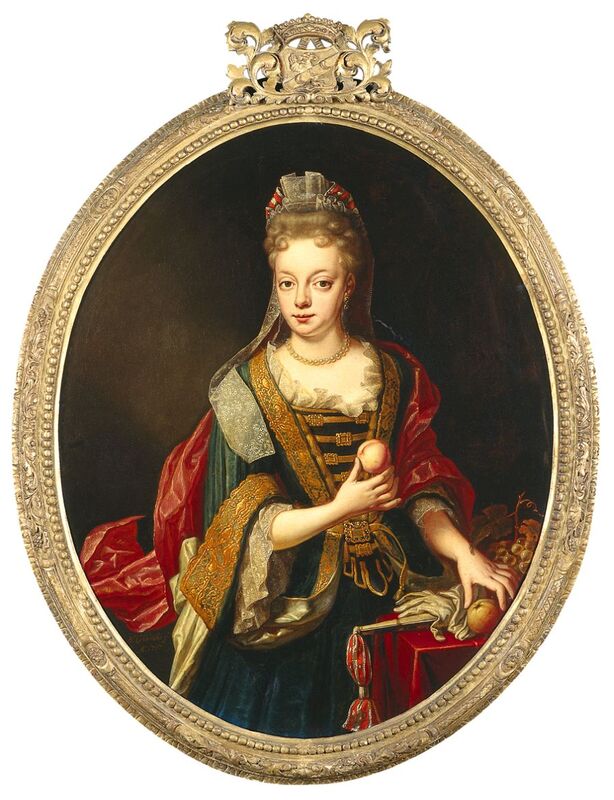

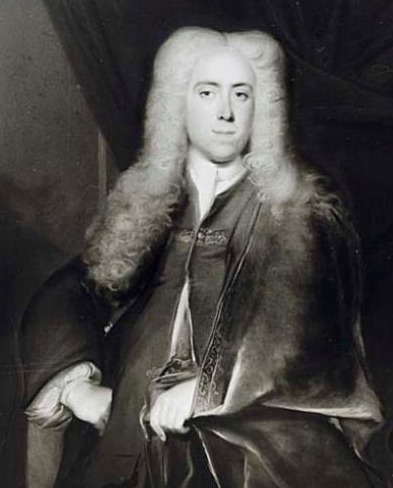
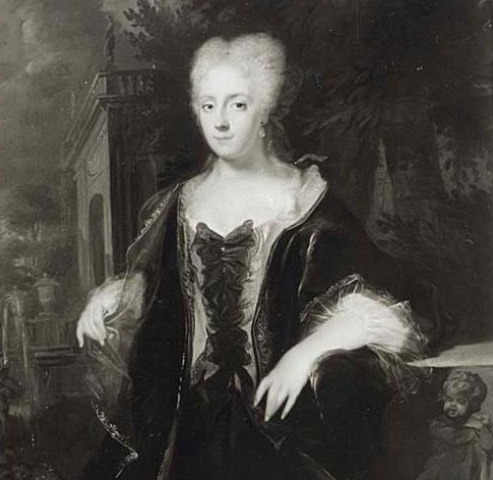
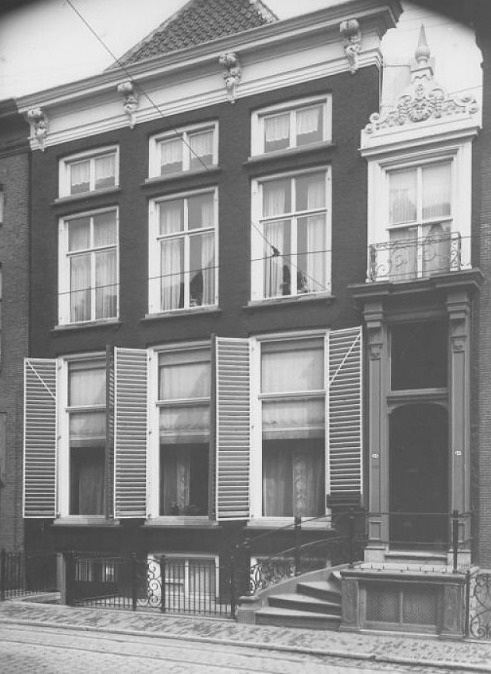
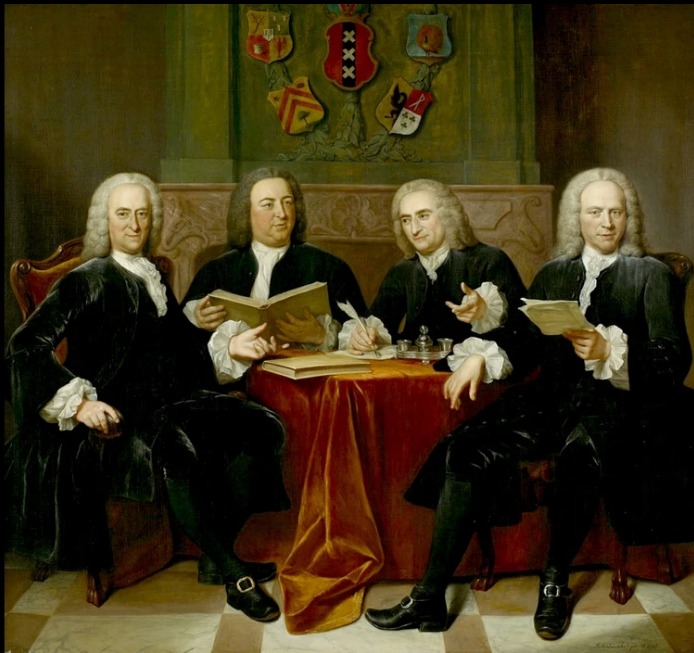
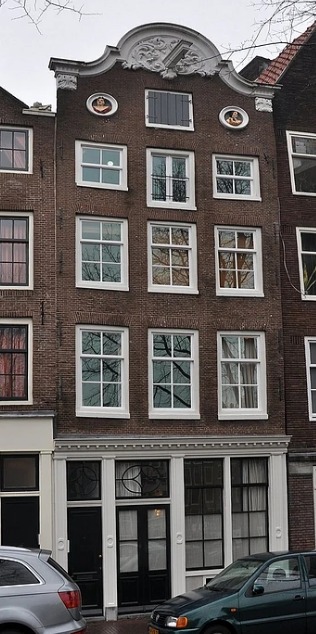
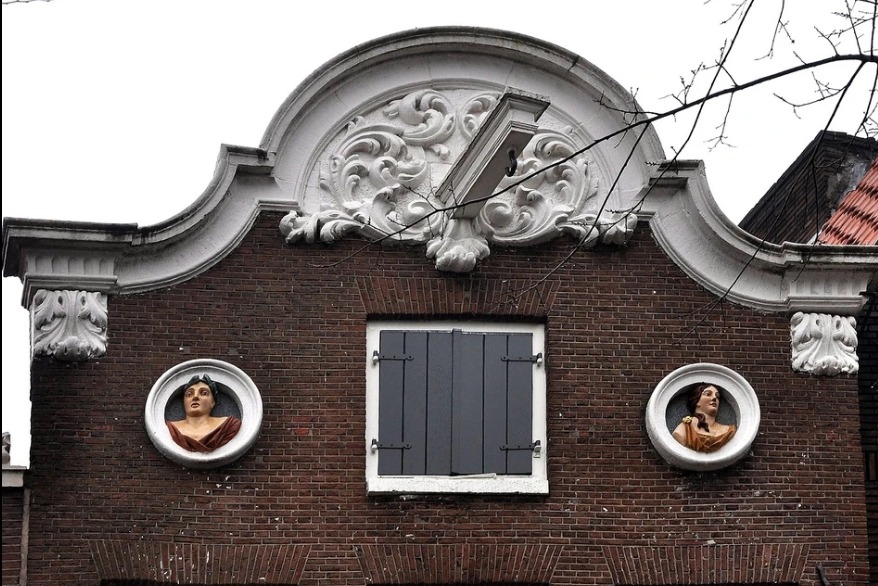
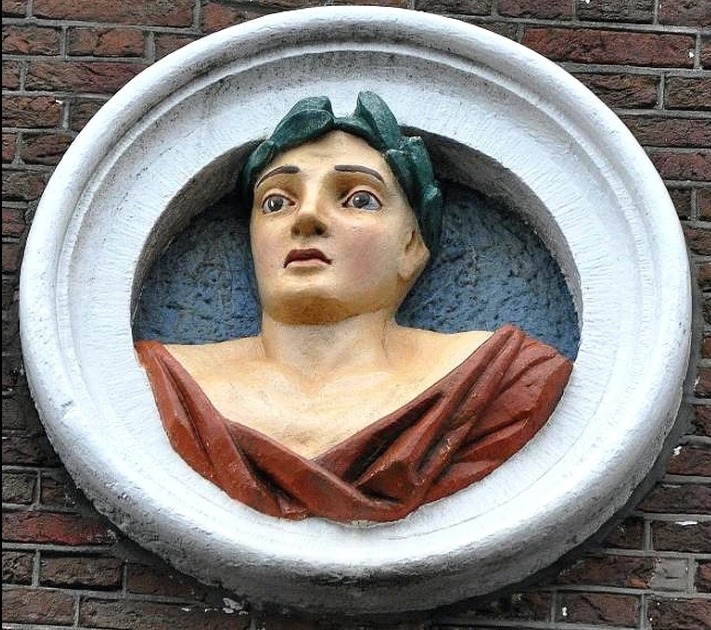
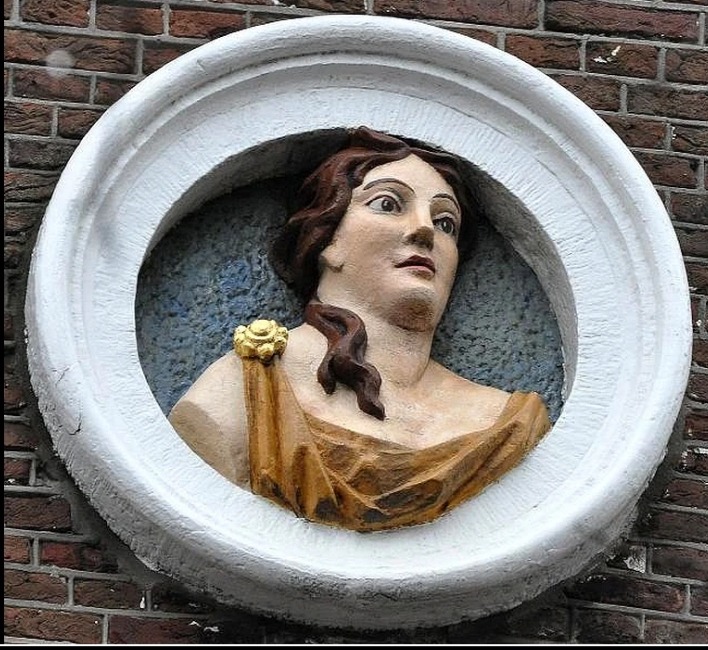
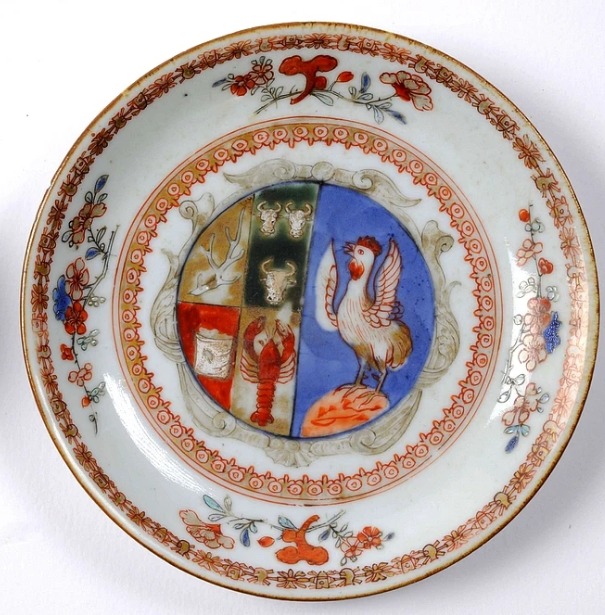
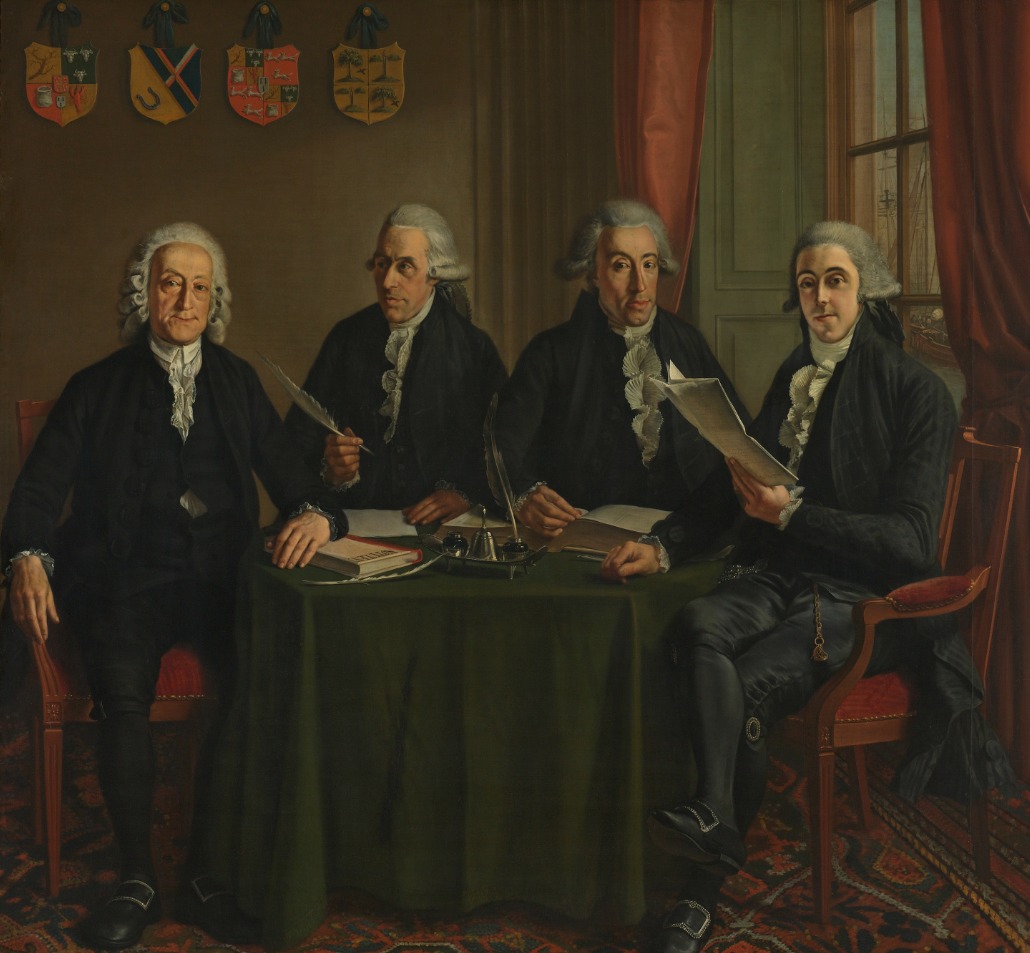
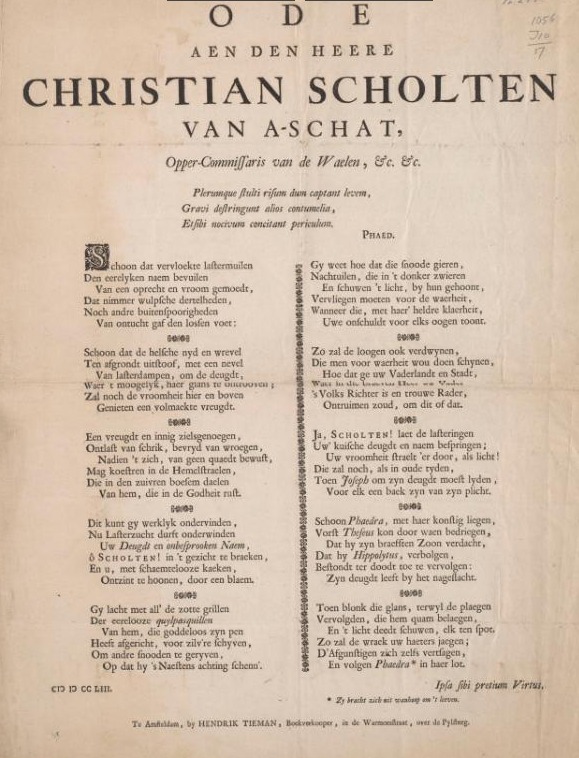
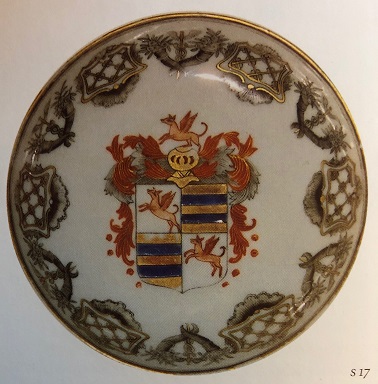

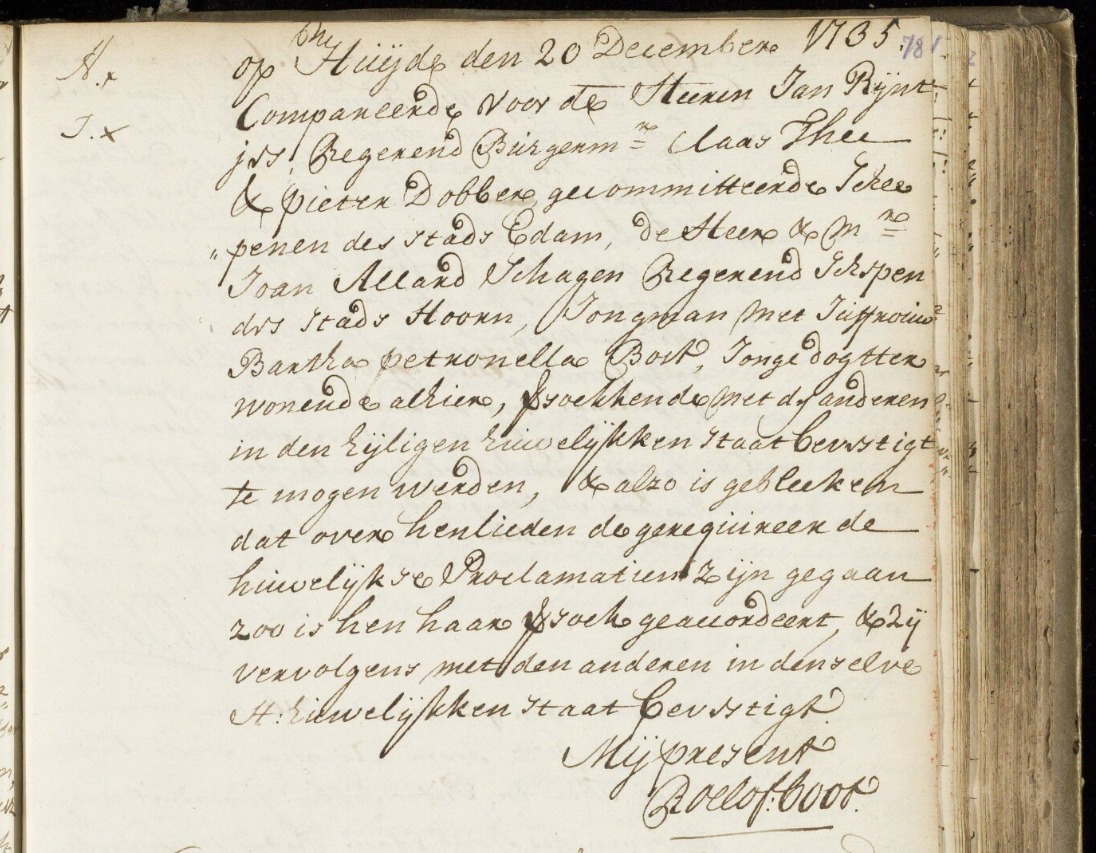
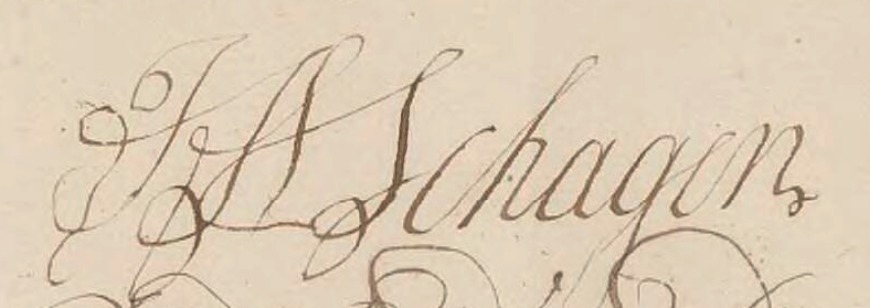
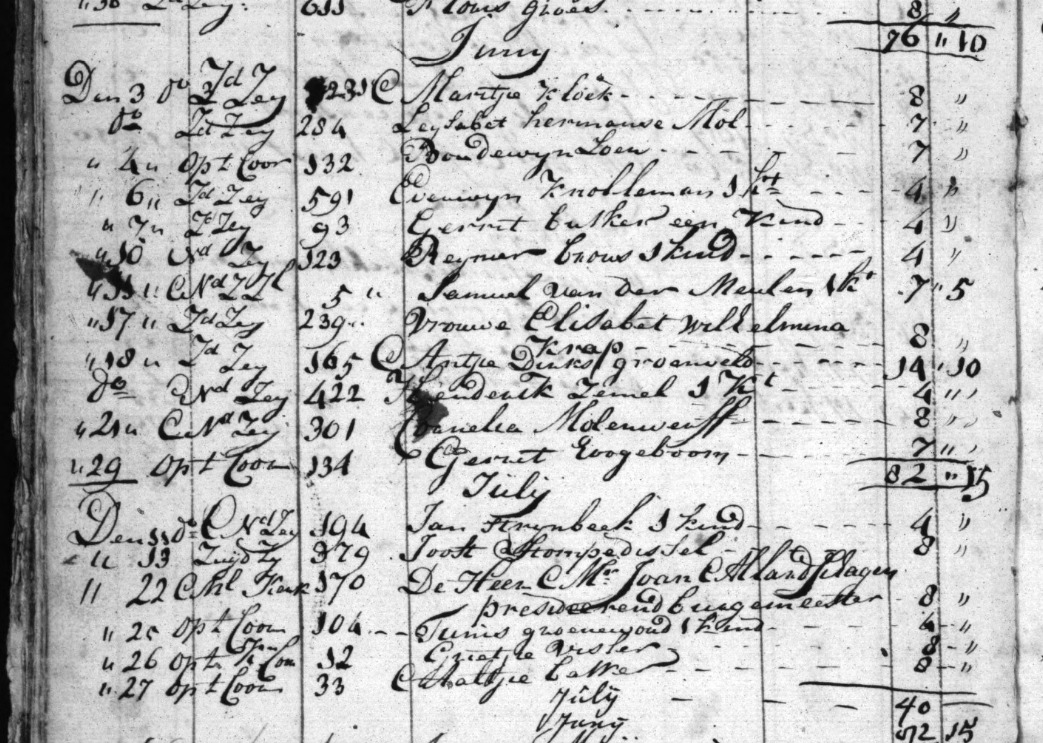
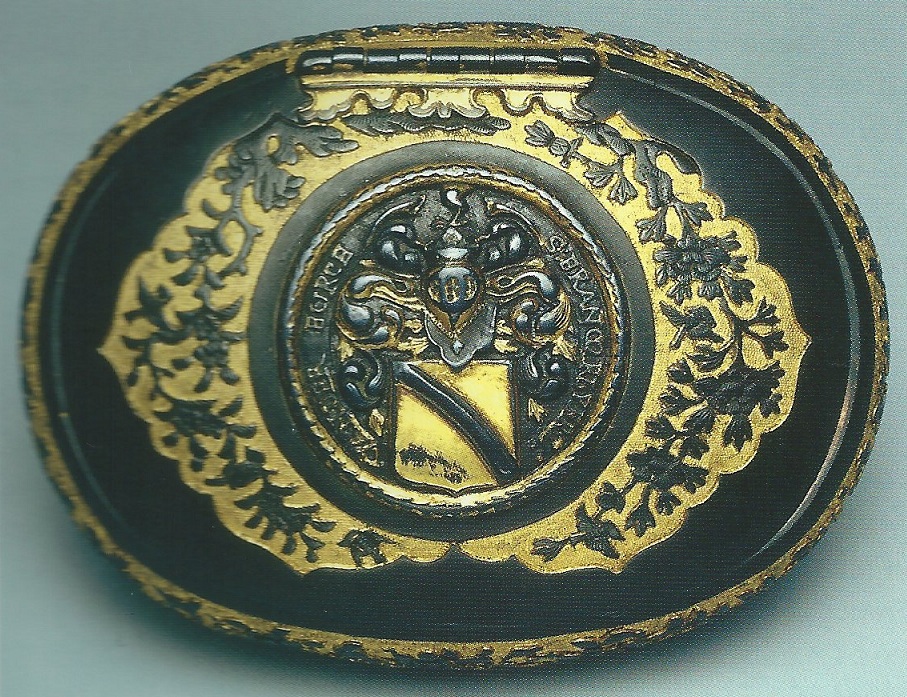
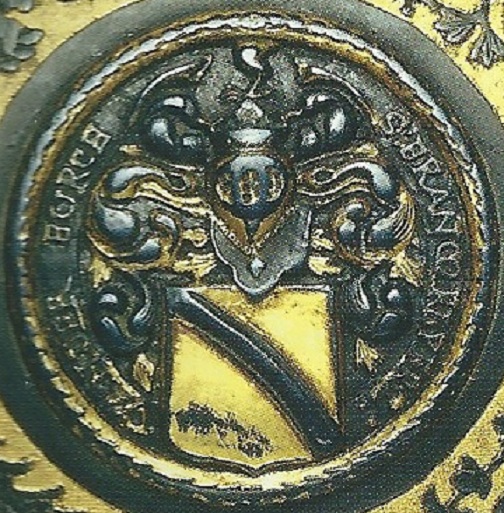
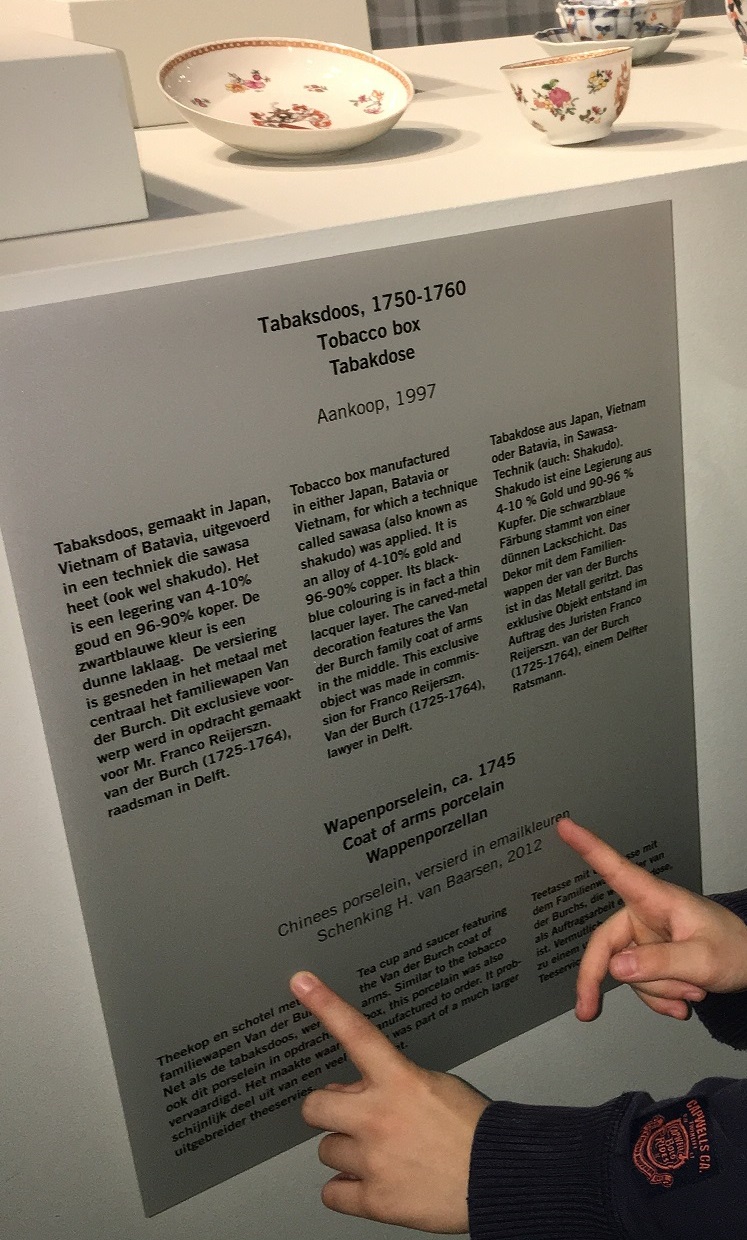
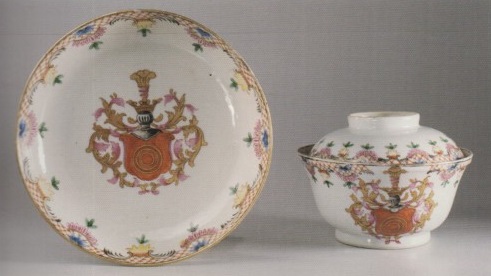
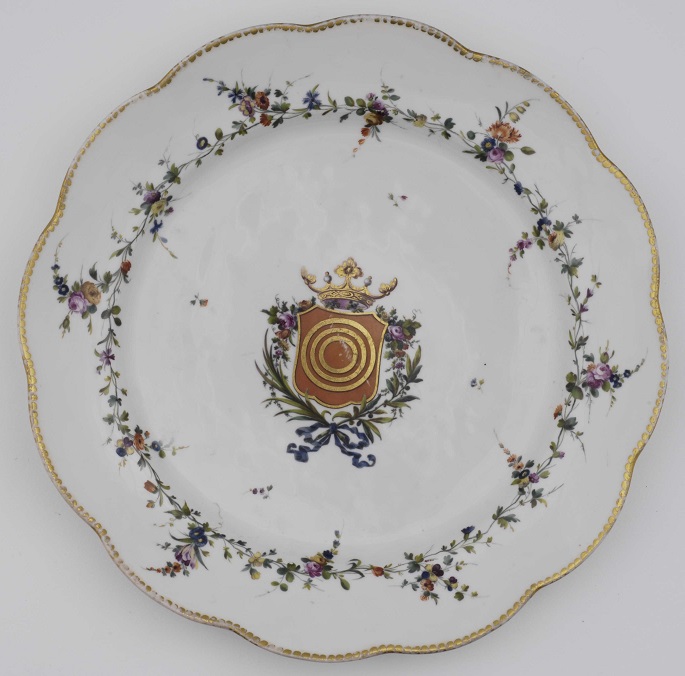

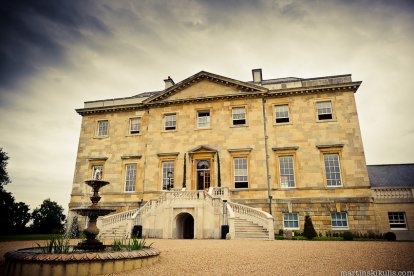
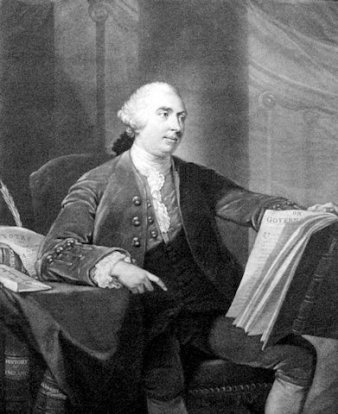
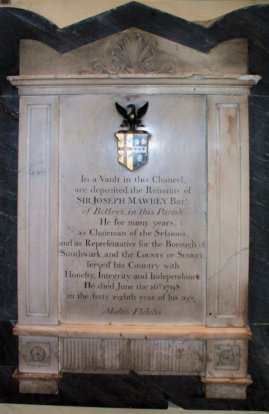

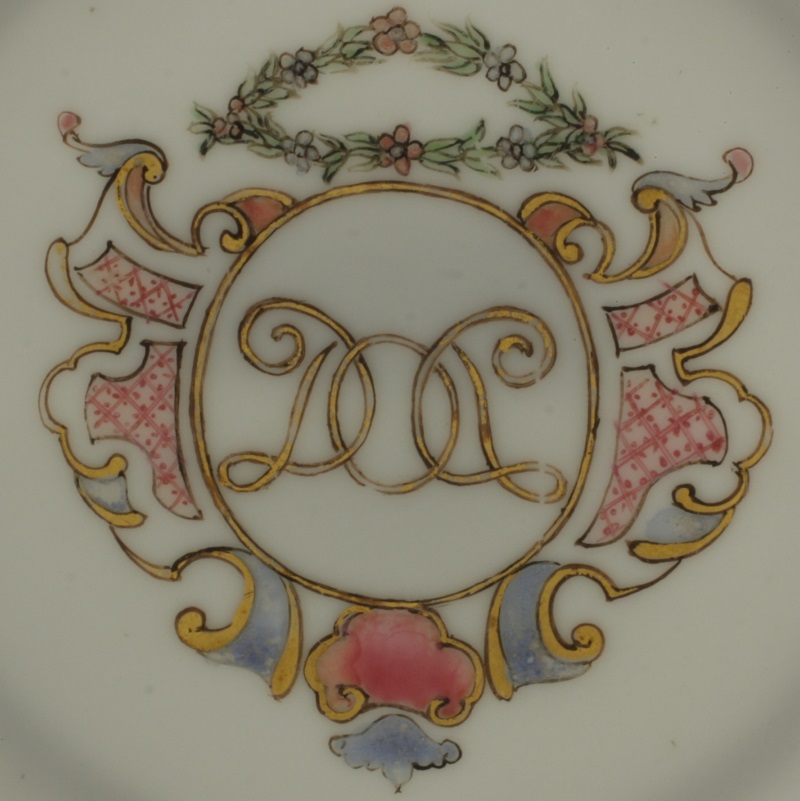
 create websites
create websites